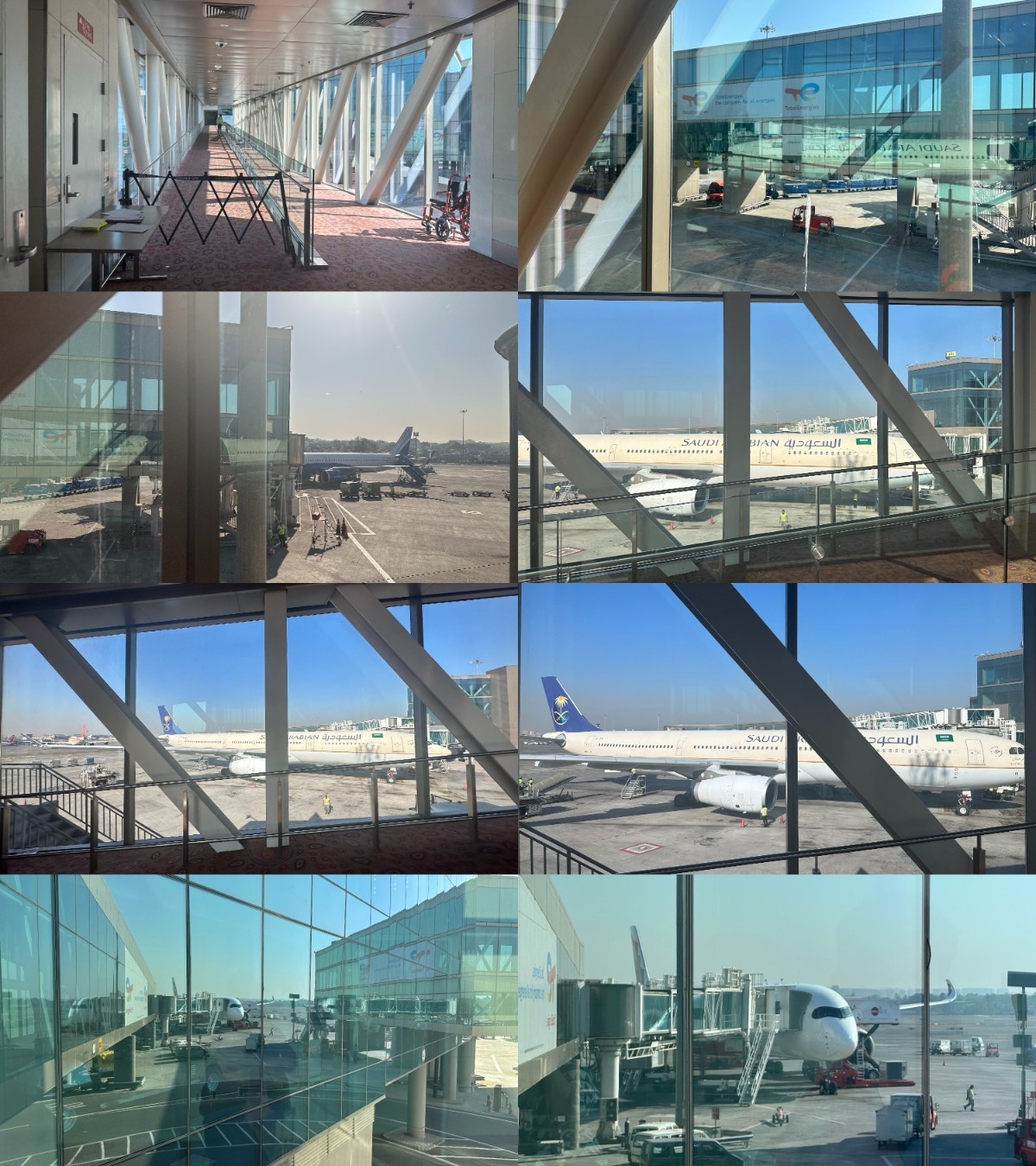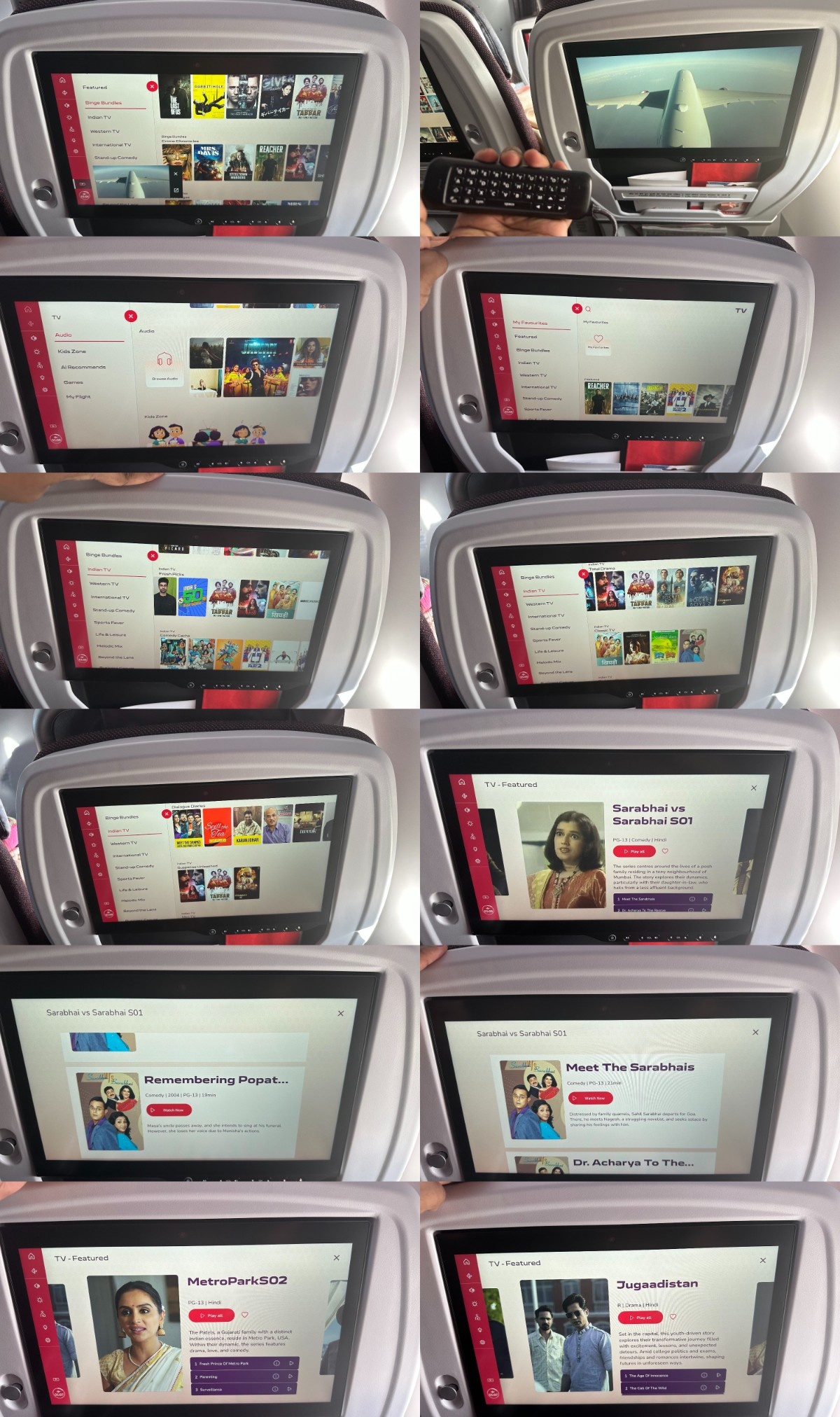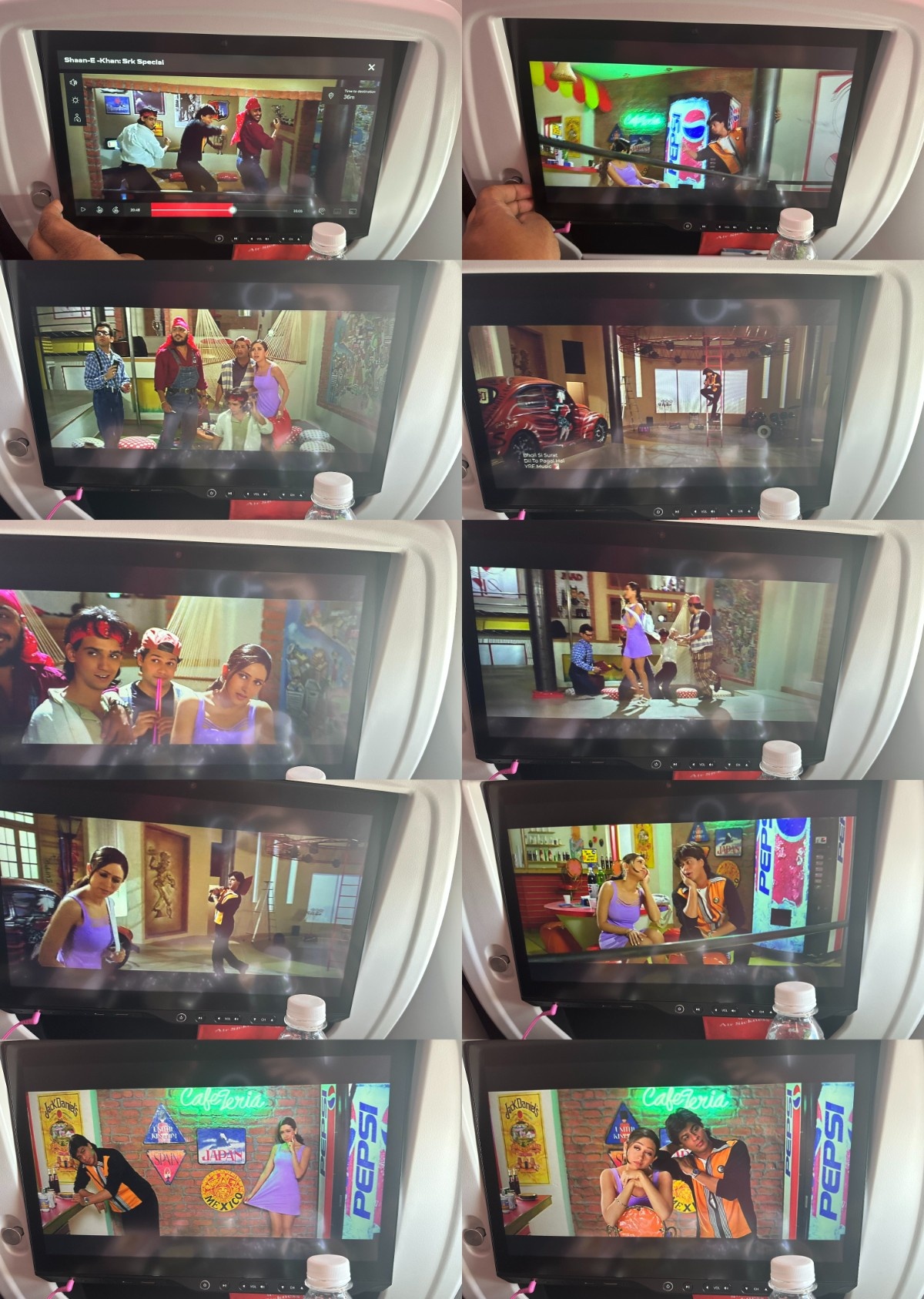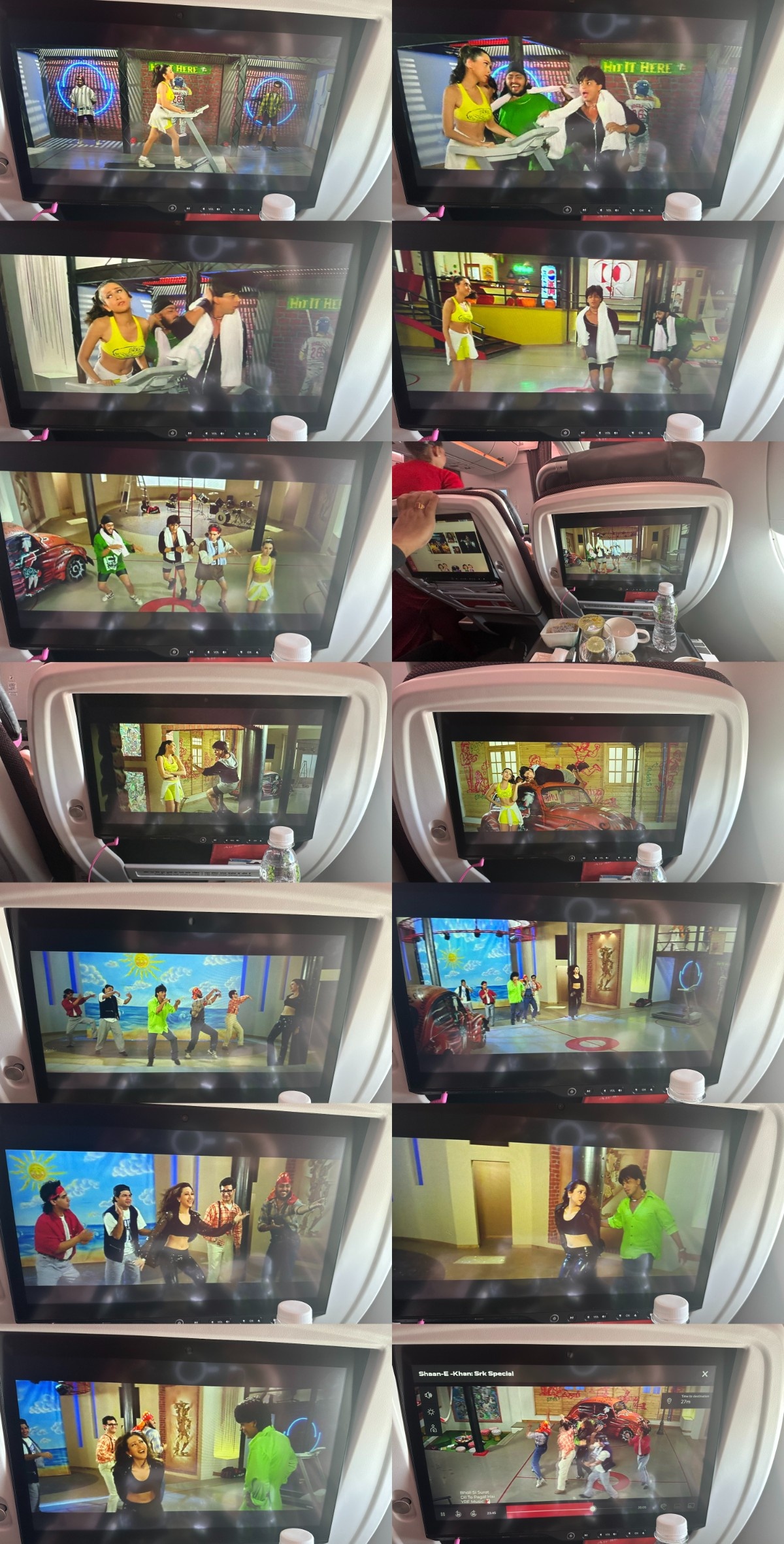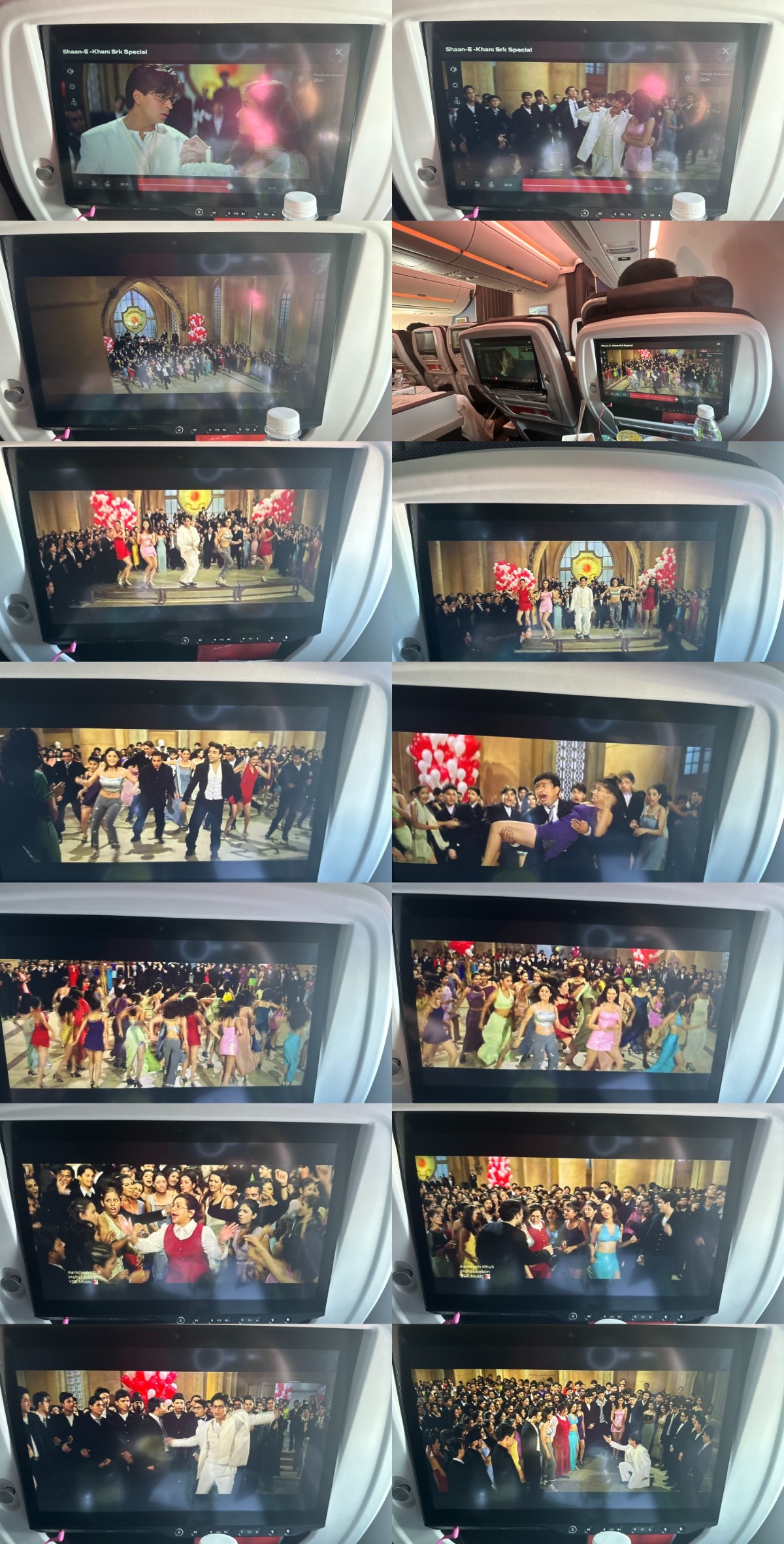Notice: This is the full version of the brief report of my Air India A350 experience, which was published on 29 February 2024: a once-in-4-years special date. If you’ve already read that one and feel that this is just a rehash of the same things, or haven’t read it but would rather read the shorter version, by all means do as you please. Otherwise, read on!
All that’s transpired with Air India’s A350s since this domestic flight in February 2024
As many of you know, a big part of Air India’s massive transformation after being acquired by the Tata Group in January 2022 is the acquisition of six Airbus A350-900s originally intended for Aeroflot Russian Airlines, but not delivered because of worldwide sanctions on Russia due to its invasion of Ukraine. With a whopping 470 aircraft from Airbus and Boeing (of which nearly 100 are widebodies) ordered in February 2023, and a new livery and brand identity being unveiled in August and implemented starting from December, these A350s would be the first visible touchstone of the much-maligned airline’s radical reinvention — aside from some 777-200LRs and 777-300ERs inducted from Delta Air Lines and Etihad Airways, respectively.
Back in February 2024 when I took this flight from Bengaluru (BLR) to Mumbai (BOM), Air India had all of two A350s: VT-JRA and JRB, of which I got the latter. They were flying on domestic triangular routes between Bengaluru, Mumbai, Chennai (MAA) and Hyderabad (HYD) in the southern half of the country, with a once-weekly maintenance flight to the national capital of Delhi (DEL) in the north. These started with AI589 BLR–BOM–MAA–BLR (this flight on the BLR–BOM leg) and AI587 BLR–MAA–HYD–BLR being the two primary triangles, with AI868/869 BLR–DEL once a week. Over the course of 2024, the remaining four A350s joined the fleet: VT-JRE, JRF, JRH and JRI. More such domestic A350 flights were added between these cities, with far more BLR–DEL flights, in particular, than before — as explained in this article — and many of them still do operate as of September/October 2024, and will do so until US flights start in November.
However, the true purpose of the A350 is on longhaul routes, they being Air India’s latest and greatest aircraft for the foreseeable future — even with Vistara’s 787-9s in the mix, as that brand will be permanently closed on 12 November 2024 and merged with AI — until new A350s, 787s and 777Xs from that mega-order are delivered. Before going all the way to the US and UK, the AI A350 was briefly rostered on the Dubai (DXB) route for a four-month period from May: AI995/996 from DEL and AI983/984 from BOM, both of them night flights. From 1 September 2024, the AI A350 has been flying twice daily from Delhi to London Heathrow (LHR), on the AI111/112 and AI161/162 frequencies, and consequently the Dubai flights have reverted to the 787-8.
And from November, the Air India A350 will stretch its wings all the way to the US: first Delhi to New York City (JFK) on the AI101/102 frequency from 1 November, and then Delhi to Newark (EWR) on AI105/106 from 2 January 2025. Note that, from that point, all AI A350s will be flying exclusively from DEL, with nothing from BOM, BLR or elsewhere, as both New York frequencies will take up four planes between them, and both London frequencies the remaining two. In addition, ex-Delta 777-200LRs and ex-Etihad 777-300ERs with refreshed interiors continue to fly other US and UK routes, including San Francisco, which is served from DEL, BOM and BLR. (AI is the only major global airline, besides Vietnam Airlines, to serve SFO but not Los Angeles (LAX)!)
Fun fact: Of the six Air India A350s, VT-JRB — the one I flew on this flight — is the only one so far (until October) to never have left Indian shores! This bird has flown exclusively domestic flights ever since starting service in February. All the other five A350s (VT/JRA/JRE/JRF/JRH/JRI) have been flying abroad, Dubai at first (May–August) and London from September, in between their domestic rotations — but with the start of US flights in November, shortly before Vistara bids a final goodbye, all six A350s have no choice but to be based at DEL and conduct all their longhaul flying from there!
But all this route planning doesn’t matter to you readers… What matters is the exponentially, drastically improved onboard product, a far cry from the falling-apart 777s and 787s of the bad old sarkari (government-owned) days, with non-functional IFE, broken seats held together by duct tape, disgusting décor and the occasional fistfight or even urination (!!!) incident… These A350s are no less than a quantum leap for one of the most lambasted and ripped-to-shreds airlines (literally and metaphorically) the world has ever seen, and have one of the world’s newest business-class suites (Collins Aerospace Horizon) to boot. I knew that this was perhaps my only opportunity to get the AI A350 on a domestic flight, so I grabbed it with both hands, despite the very early-morning departure.
With my previous 5.5-hour AI flight earlier that week (AI383, SIN–DEL) on a cramped A320neo in the dead of night showcasing the very worst of the old AI, it was all the more important for me to experience just how much it was capable of discarding the bad old reputation that it still has. It goes without saying that, in the astute hands of the Tata Group, not to mention global luxury legend Singapore Airlines (part-owner of Vistara) with a 25.1% stake, Air India is venturing bravely and boldly, rising from the morasses, where perhaps no one’s ever gone before with such a trajectory. This will ring all the more true after the much-loved Vistara brand disappears forever in November, joining fellow fallen luxury icons Jet Airways and Kingfisher Airlines in the graveyard of Indian airlines, one that (very sadly) never seems to stop adding new victims!
Flight routing
- 1
- 2
- 3AI589 | Bengaluru to Mumbai | 25 February 2024 | A350-900 | VT-JRB (this is the full review)
- 4
A tale of two A350s in a day — and finding what their registrations are
Sunday, 25 February, early morning. Which AI A350 would operate my flight to Mumbai was easy enough to figure out, given that only VT-JRA and JRB were in the fleet at the time, and the latter had already been listed in the flying schedule on Flightradar24. As for the connecting plane, I’d need to wait until SQ422 to BOM showed up on the radar to know what it would be.
In the meantime, another Mumbai-to-Singapore flight, a very unique one at that, was in the air: the weekends-only SQ425, operated by 9V-SJG, then the newest A350 in the entire SQ fleet. (9V-SJH was delivered in April, and 9V-SJI will be SQ’s final passenger A350.) Mumbai is the only Indian city to receive the longhaul-configured (9V-SM*/SJ* series) A350 at all — which further reinforces the fact that no Indian city has it better for flights to Singapore than BOM, between the SQ A380, two types of SQ A350 and the (soon-to-be-gone) Vistara A321neo, which I’d flown in March 2023.
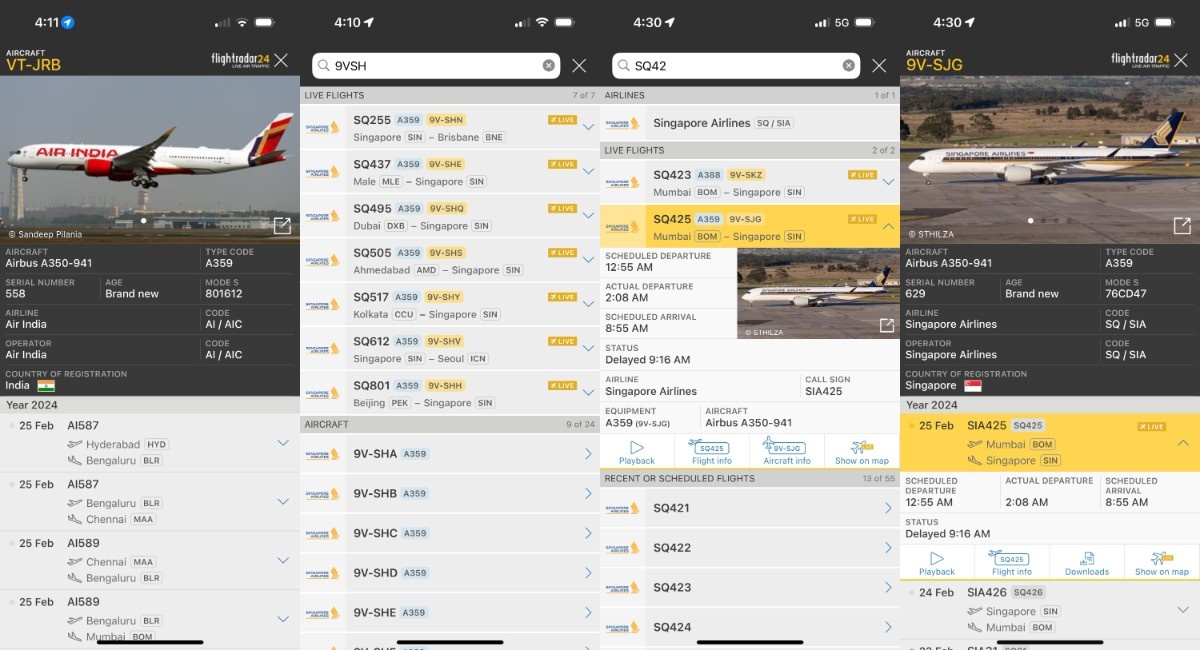
As I love to do before a journey from my parents’ home in the southern suburbs of Bengaluru, I took pictures of the rooms of the home — including the objets d’art in my study-table-cum-bookshelf that I’d used before moving to Singapore for university, and that’s now filled with such bric-à-brac.
Before long, at 4:30, the family of four (including parents and grandmother) were all bundled into a Toyota Etios taxi-sedan rented for the purpose, commencing the hour long 47-km journey all the way up north… a journey that can take more than two hours in the worst of traffic! (As I experienced in August 2024, where a gridlock at a flyover near the northern fringes almost made me miss my flight — not that I was in any way looking forward to the Thai Airways 777-200ER for the umpteenth time!)
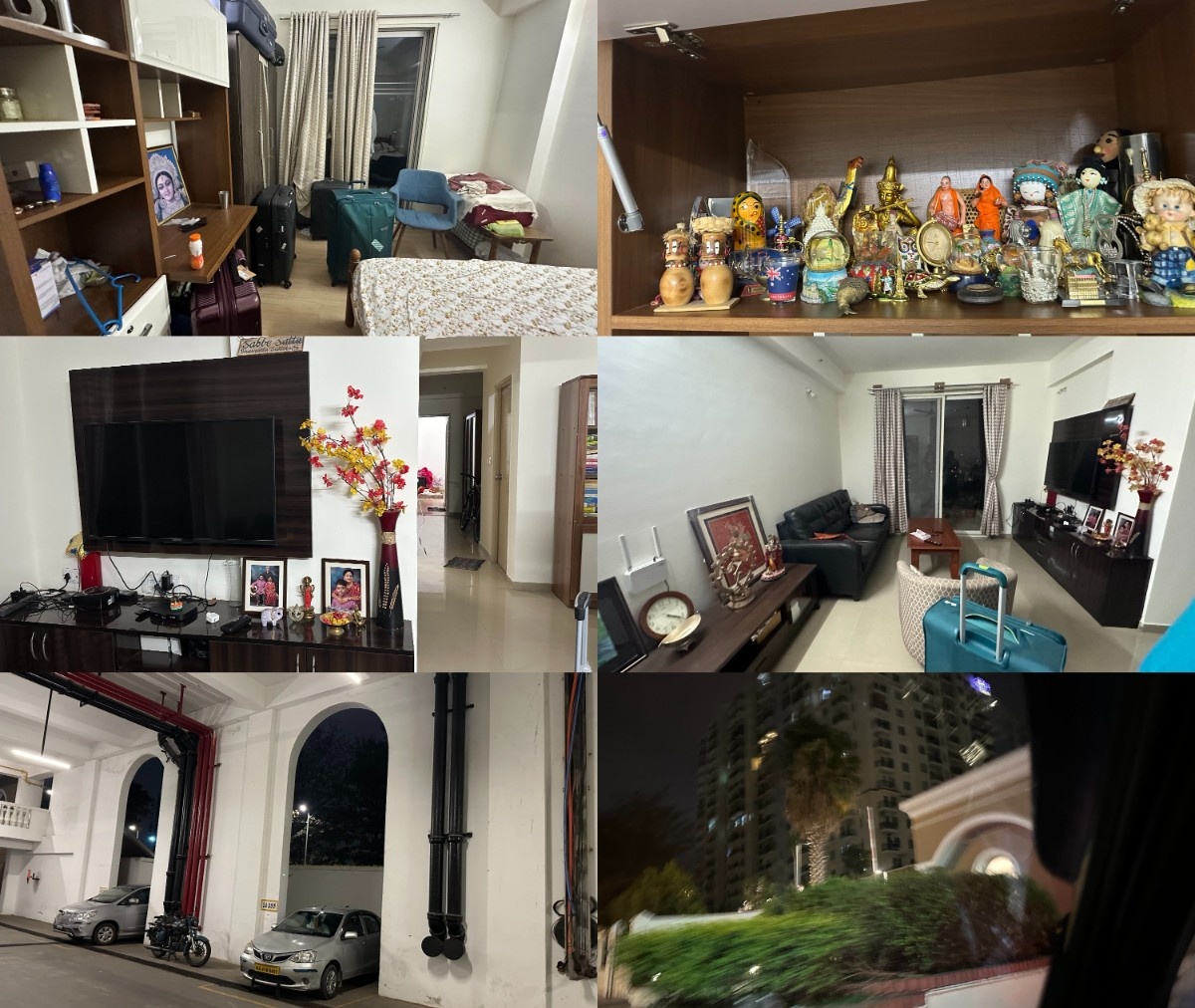
Ever since my family shifted here from Chennai in 2023, I’ve never travelled to Kempegowda International Airportduring the daytime to catch a flight, but this early-morning departure was the closest I could get — even though the skies remained completely dark.
As we reached the northern suburbs of Hebbal in less than 45 minutes, the city roads, which are packed with bumper-to-bumper traffic at other times of day, gave way to smooth, broad expressways with techparks and malls on either side. (And, of course, the billboards, which I miss badly in Singapore!)
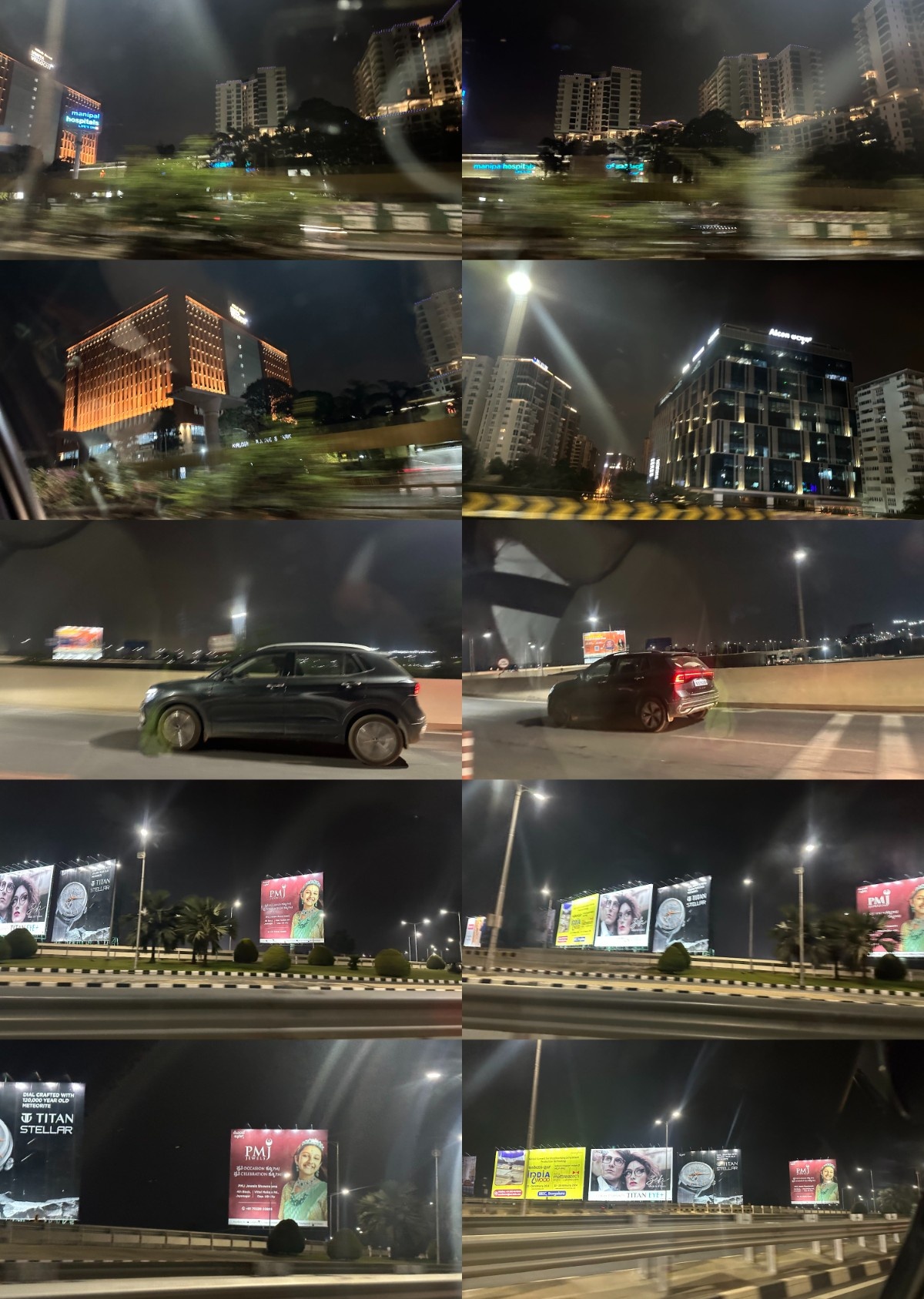
As we neared the airport, the plane operating my subsequent flight from Mumbai showed up on Flightradar24, and it would be 9V-SHL. This was my fifth time on this series of SQ’s medium-haul A350s (and my sixth SQ A350 overall, the first being 9V-SMF with a ’10,000th Airbus aircraft’ sticker), with another one being added in late August 2024: 9V-SHS as SQ705 from BKK.
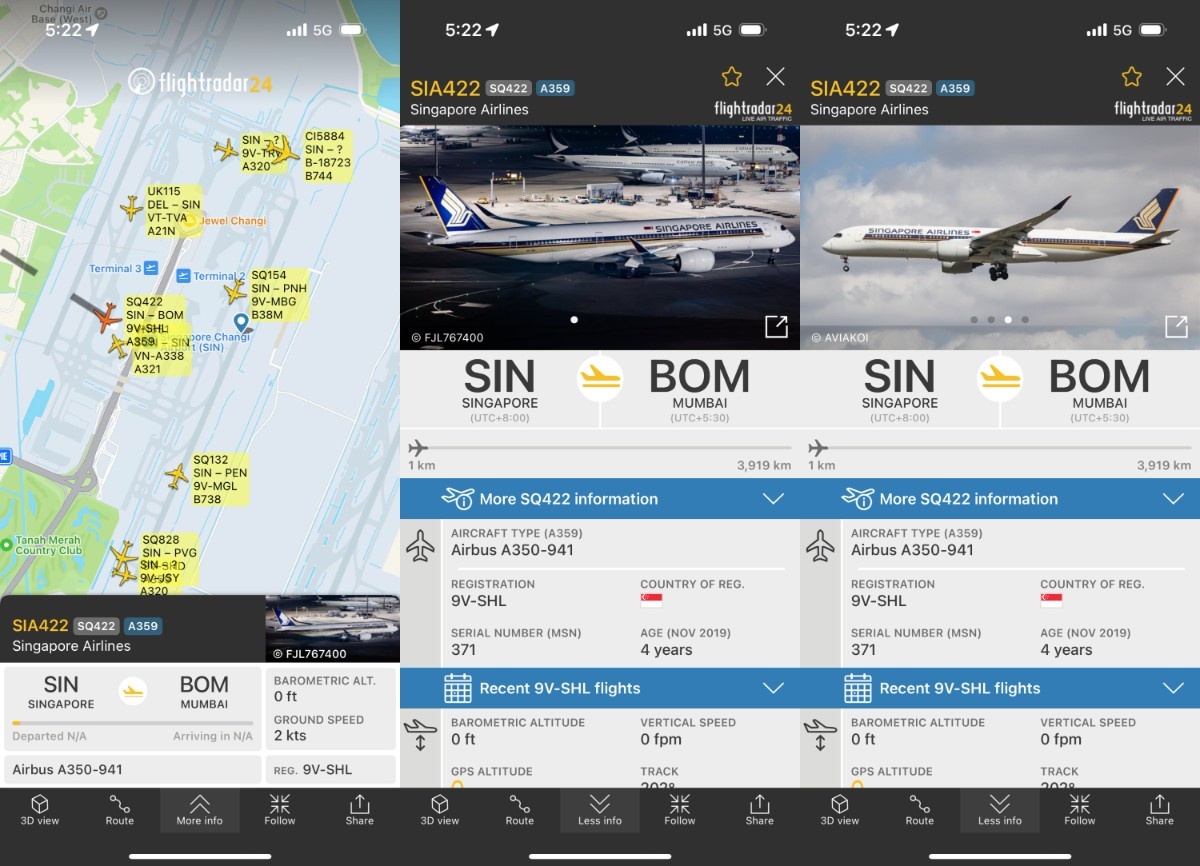
SkyTeam’s latest member at the time, Virgin Atlantic — with Scandinavian Airlines switching from the Star Alliance at the start of September — had recently announced service to Bengaluru (VS316/317) on the 787-9, which started from April. This was shown prominently on a big overhead JCDecaux billboard as we approached the terminal driveway. The SkyTeam logo was nowhere to be seen, which seems to be the norm nowadays for Air France–KLM, Virgin and now SAS. (Korean Air, Delta and Garuda will never do that!)
Together with its double-daily Delhi (VS300/301, VS302/303) and Mumbai (VS354/355) service, the British airline, which otherwise focuses on US and Caribbean routes (plus some African ones) while cutting East Asian routes, has been doubling down on India–UK demand lately as the success of its BLR route shows.
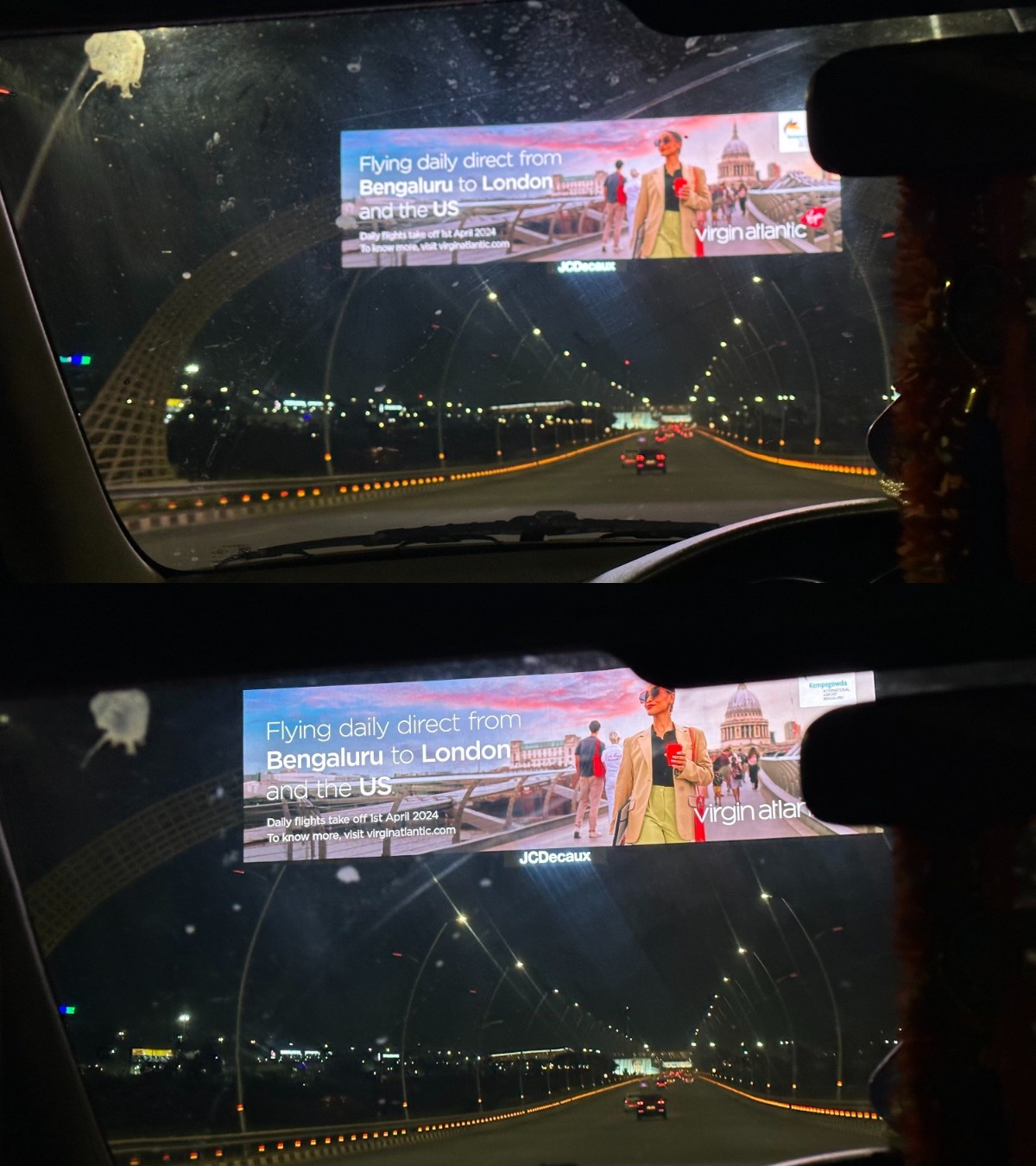
At length, at just over an hour after leaving home, the luxurious towers of the Taj Bangalore 5-star hotel came into view, and then Terminal 1. After a bit more of a drive towards the right, the glittering, globally award-winning Terminal 2 loomed over the scene, having bagged the Prix Versailles (Special Award for an Interior) from UNESCO at the end of 2023.
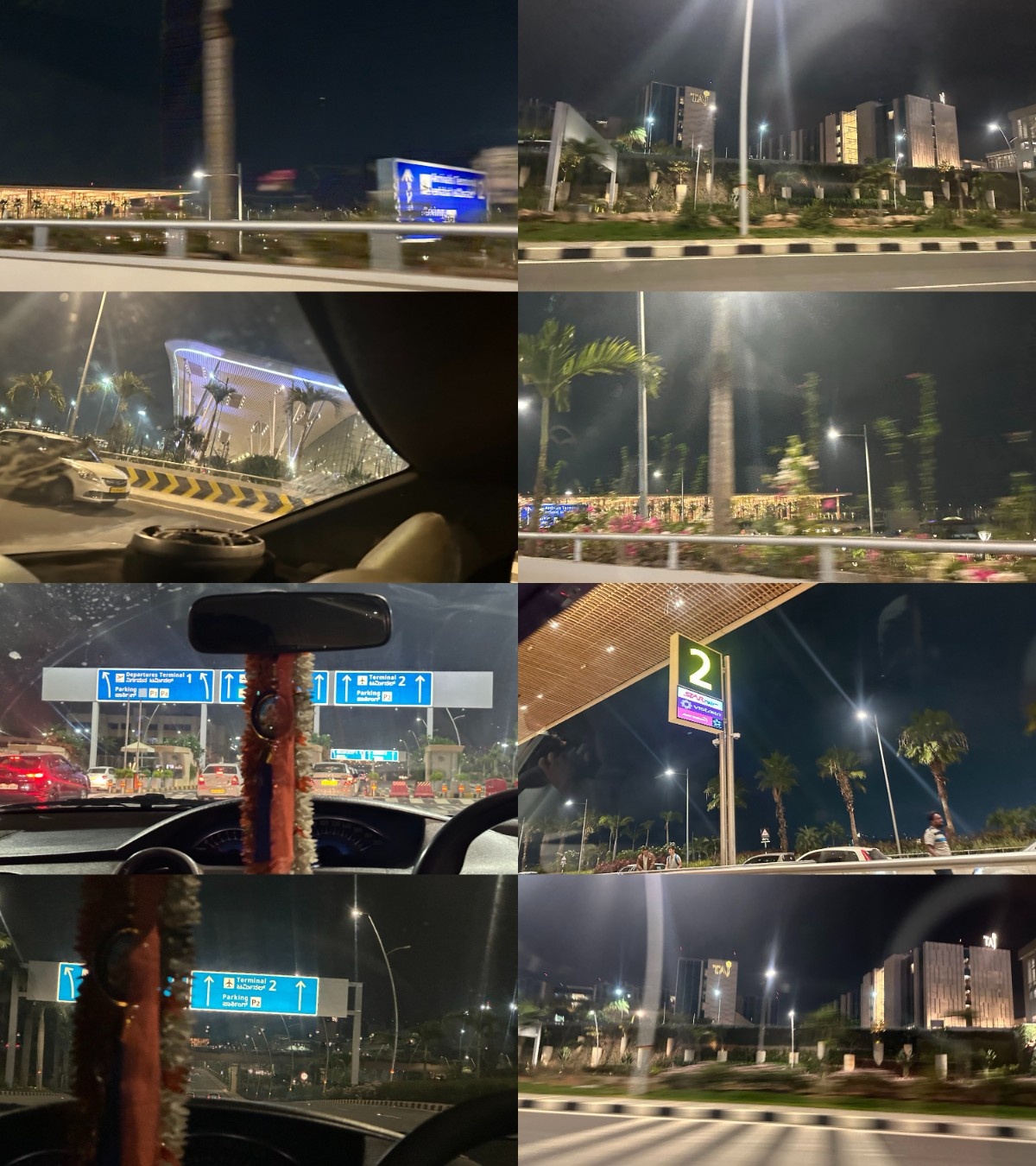
I brought down my luggage and saw off my ever-waving family members — with an Air India widebody’s tail visible from afar — before proceeding to the security check (found at all Indian airports, alongside the newer DigiYatra system at some of them), showing the boarding pass in my Apple Wallet and entering through a door featuring the panoramic picture of a forest.
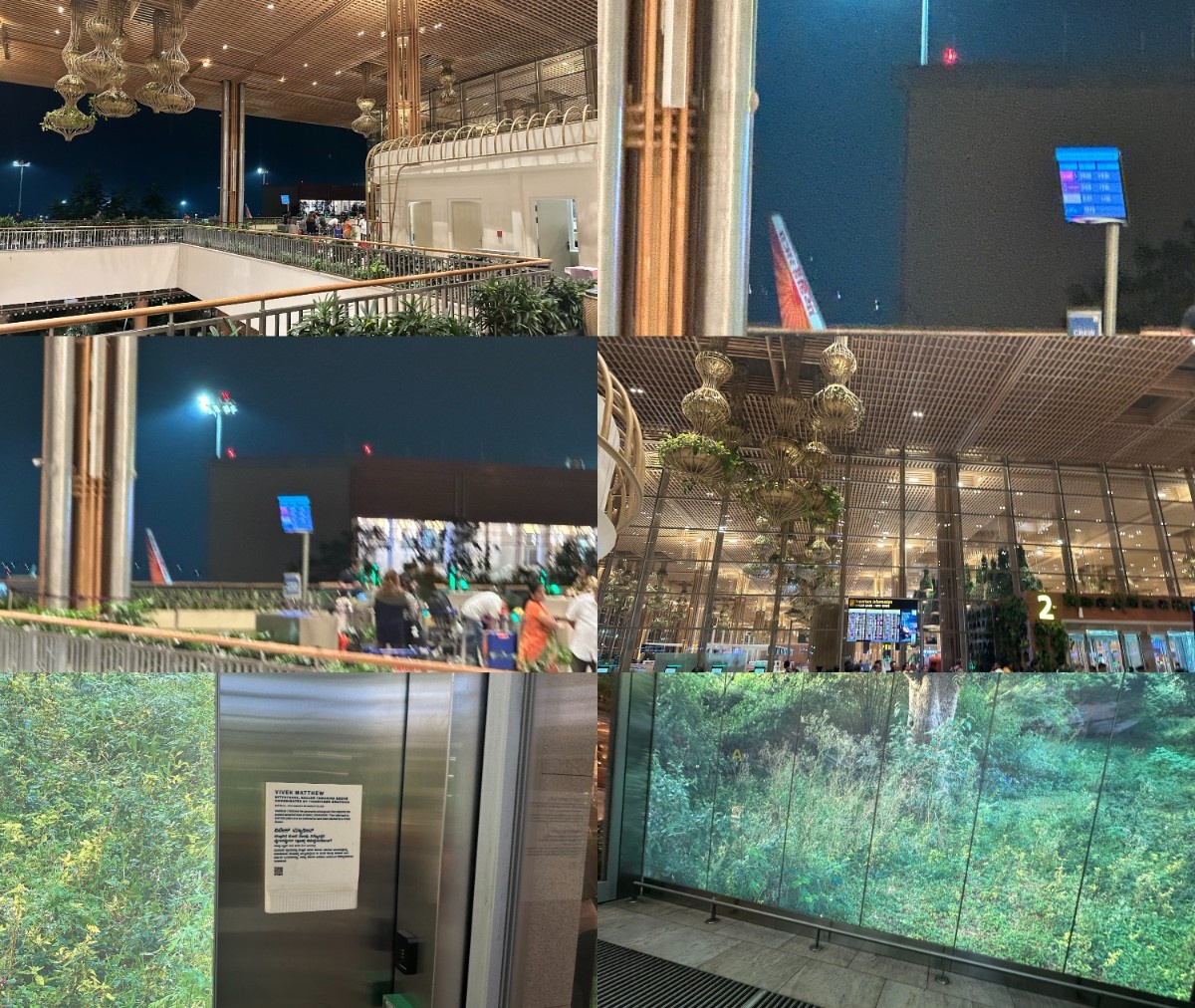
Inside the cavernous building with bamboo-lined ceilings, wicker lanterns, 360°-rotating ads and acres of check-in space, I headed, for once, to the domestic Air India and Vistara counters instead of the international airline counters.
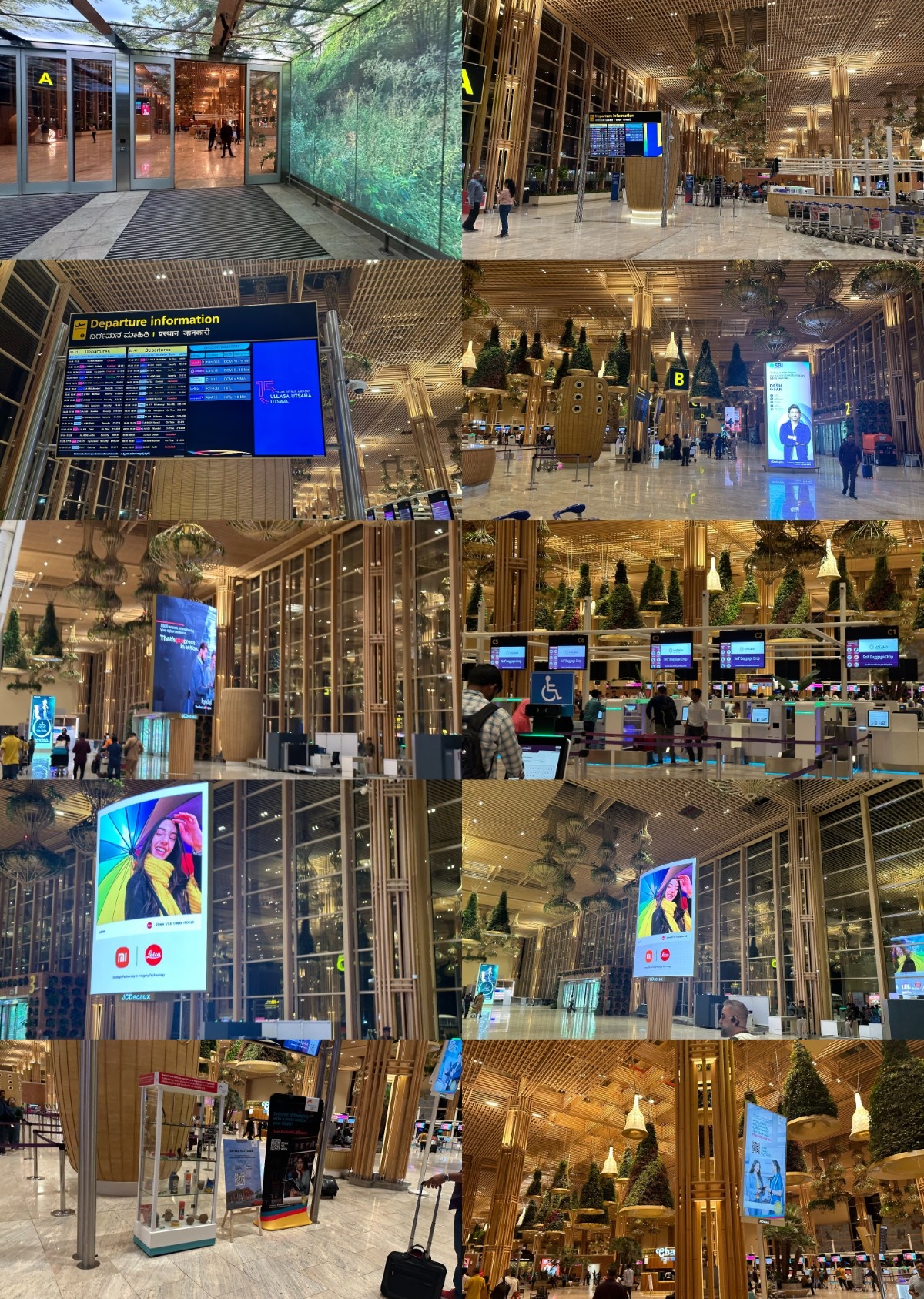
As you might expect, the AI bag-drop counters were decked in all the latest finery, with new signages and colours, to drive home the fact that this was not the sarkari (government-owned) Air India of old. A sign placed nearby had a Namaste and a picture of the Vidhana Soudha, the state legislative assembly building of Karnataka, to add an authentic Bengaluru touch. As I’ve been saying, the branding transformation was as comprehensive as it gets, up unto the suave stretchiness of the custom Air India Sans font — though I’d rather (as I’ve also been saying) they didn’t choose the free Nunito font to complement it, and instead went the Saudia way in using that custom font, or a narrower version thereof, exclusively.
On my part, I went straight to the Premium Economy counter, as I knew that would be the best way to experience this cutting-edge aircraft without splurging for Business. This would be only my second Premium Economy flight, after a one-month-old Vistara A320neo (VT-TQT) in the other direction (BOM–BLR) two months before, in December 2023 — also an early-morning flight, which I usually avoid. That time, however, I was upgraded for free without my knowledge, as opposed to this occasion where I intentionally booked the higher cabin on this A350.
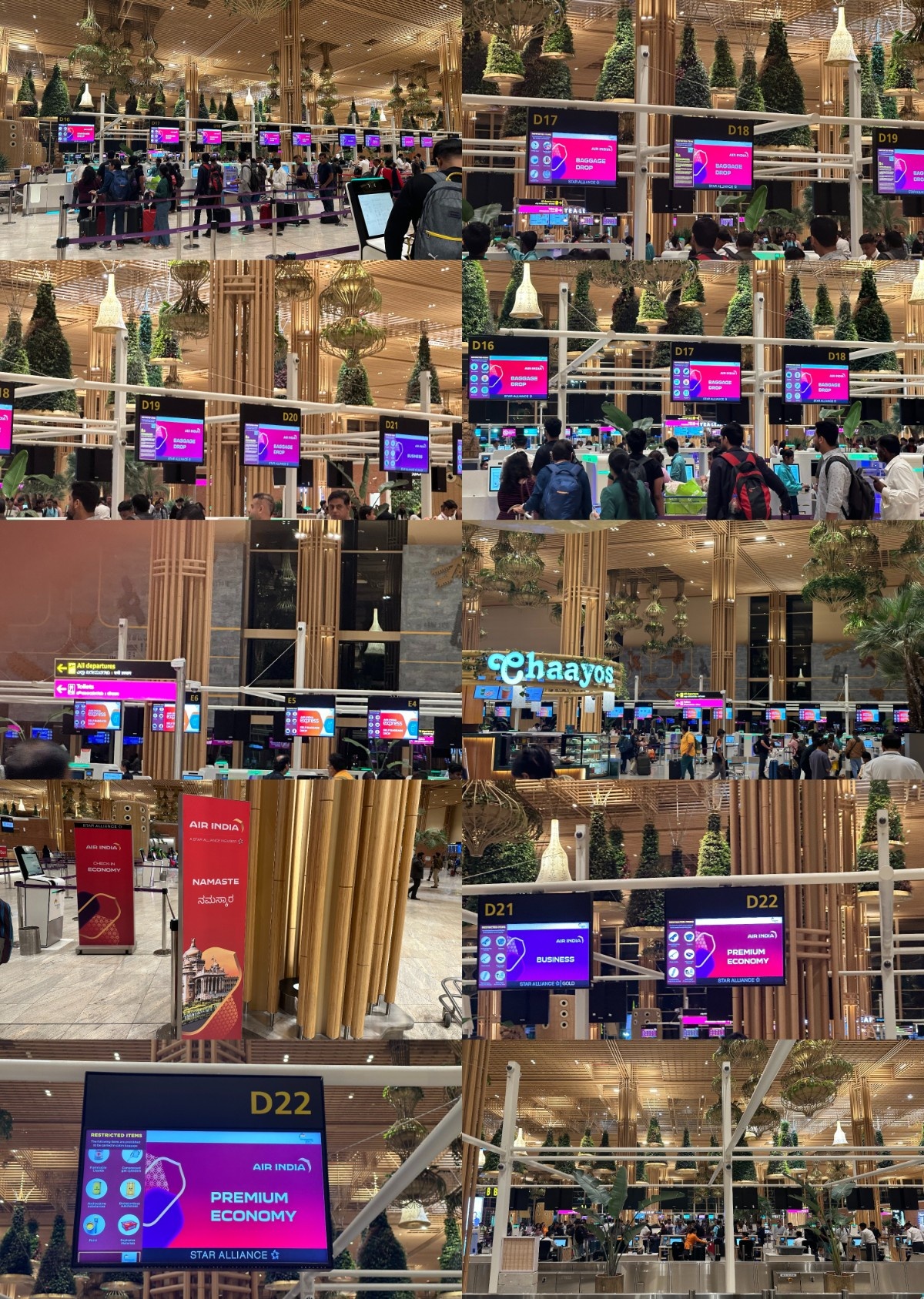
In a matter of time I was issued my boarding pass, which had a band of burgundy on top to denote Premium Economy: clearly a nod to Vistara. For its part, Vistara’s Premium Economy boarding pass, as I’d seen on that occasion, had a blue band on top instead of its signature purple colour — one that Air India has pledged to keep in the skies well after November 2024, when Vistara closes its doors for good.
Meanwhile, I’d received AI’s new safety video, entitled ‘Safety Mudras’ and inspired by Indian traditional dances, as a WhatsApp forward from my mom. Go figure this wasn’t actually screened on this flight, despite the crystal-sharp displays of the A350, as it’d been only two days since it was introduced! Only a few days later, on 1 March, Air India also introduced a new signature brand track that was composed by some of our finest musicians. While not the serene tranquility that its part-owner Singapore Airlines portrays so harmoniously, it’s well worth a listen for its old-meets-new melodies and beats.
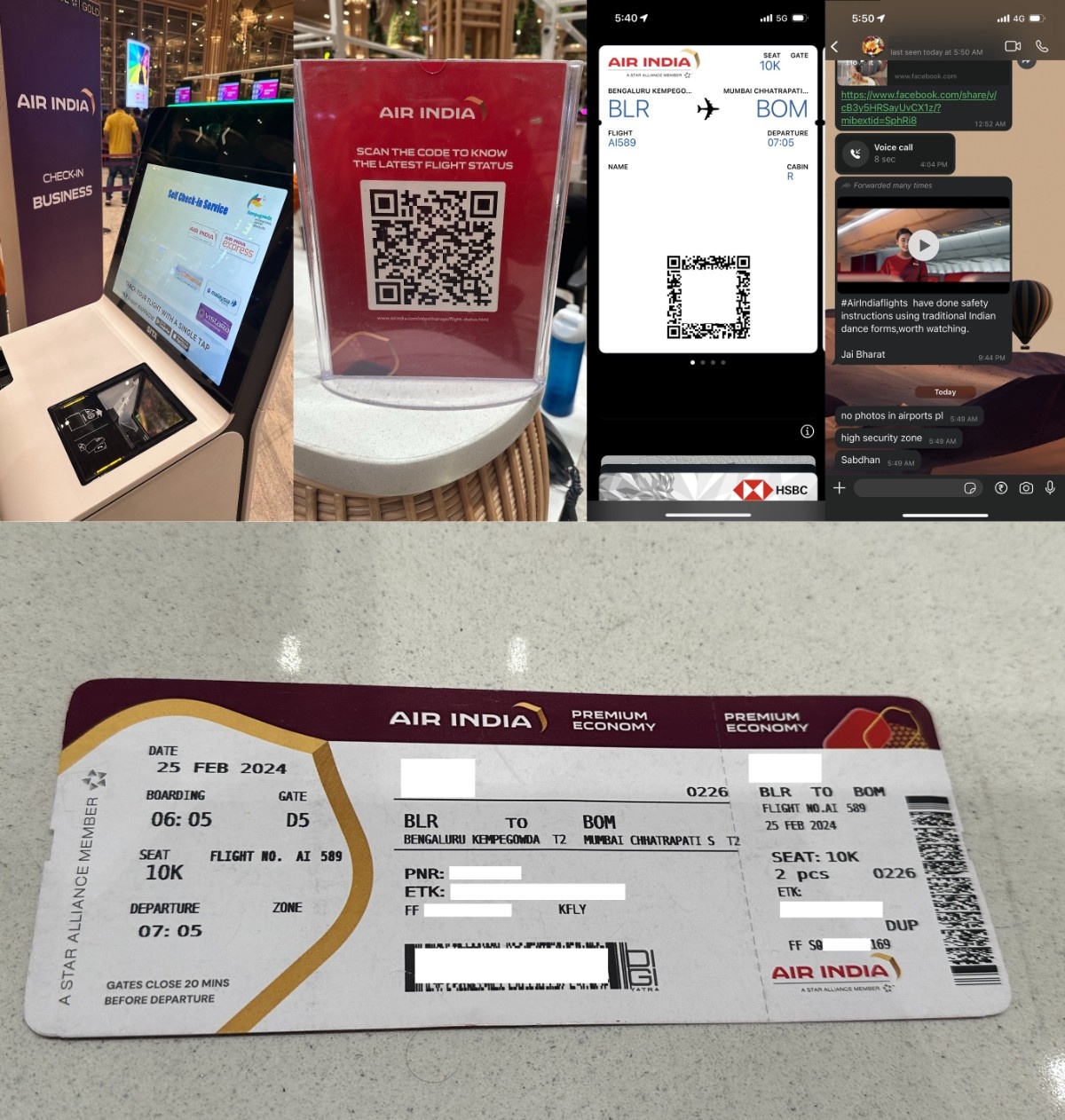
I’ve attached both the safety video and the brand track below, for your viewing/listening pleasure.
This being a domestic departure, my first from BLR T2, there was only a security check to complete, and (to my surprise) it was done speedily enough despite the large number of trays needed to host all my belongings. After this began a vast corridor of retail and recreation, one that completely blows most other Indian airports — and even this terminal’s slightly under-equipped international section — out of the water, save for Mumbai’s T2 (with the retail space shared between domestic and international) which will always remain one of my favourites in the world.
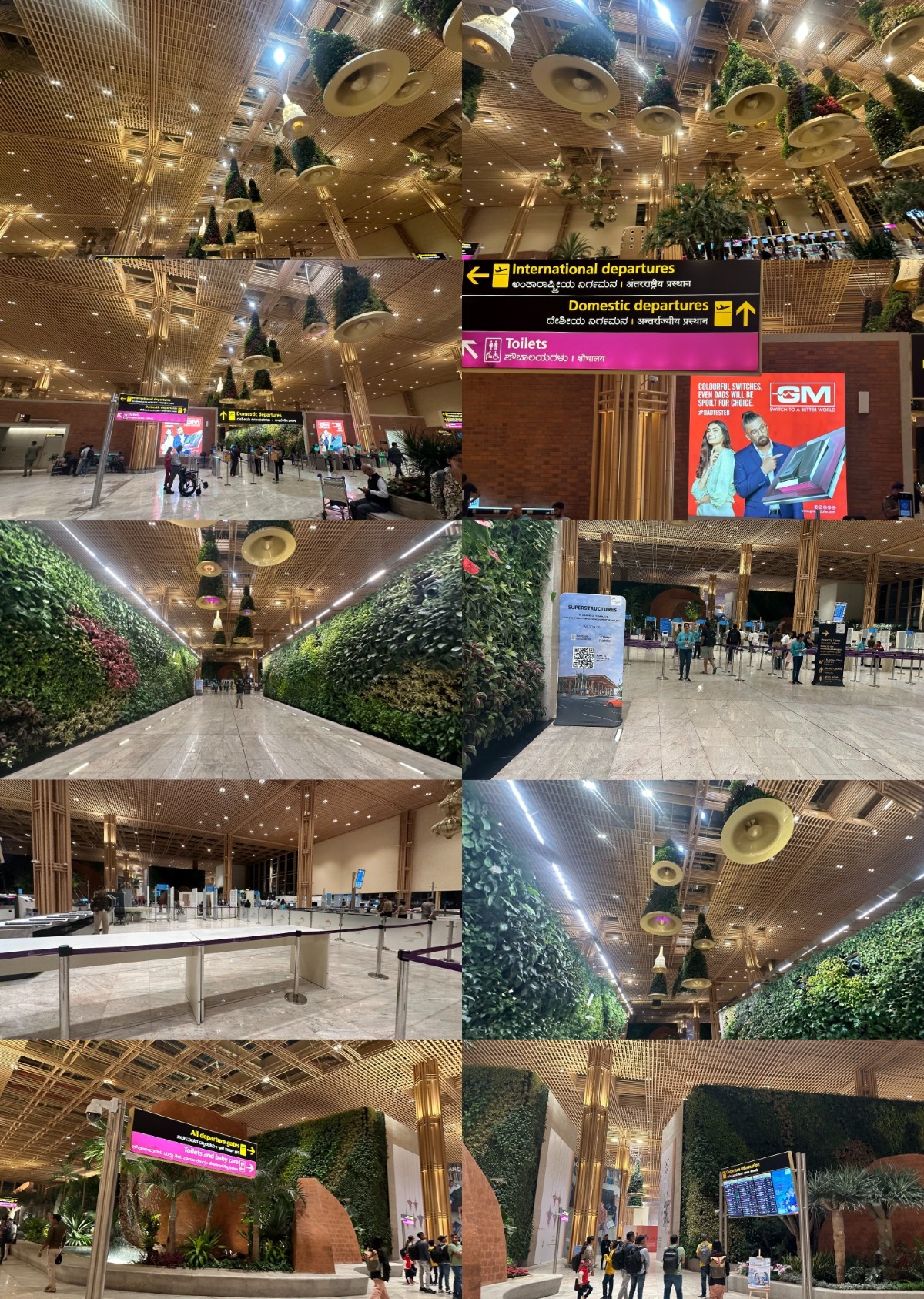
Combien de luxe désirez-vous, monsieur ?
Or, for the benefit of those who cannot speak Français (I most certainly cannot): How much luxury would you like, sir? (No, this hasn’t suddenly turned into the FRench version of Flight-Report — though I’m sure some would be enchanté to see that!)
The sheer extravagance of BLR T2 comes to the fore in its domestic section, which has a bewlidering array of posh retail outlets — far more than the international section, which has no food court or anything relatively cheap (like McDonald’s) — while steering clear of the Chanels, Diors and Guccis that Changi, Hamad and Co. never cease to flaunt. This being my first time in this part of the terminal, I was bowled over by global names as exotic as P.F. Chang’s, Brioche Dorée (which I visited) and Carcluccio’s — none of which are present at even Changi, even though Wolfgang Puck is. And, of course, I’ve written aplenty about Tim Hortons and its Indian expansion in a previous instalment about the Air India Express A320 from Delhi to Bengaluru.
If only Indian domestic flights themselves were half as luxurious as their international counterparts, or indeed the exclusive international brands that perhaps no other airport in India, or in some cases even Southeast Asia, can boast of! But were many people actually going to part with hundreds or thousands of rupees at these places? Your guess is as good an mine.
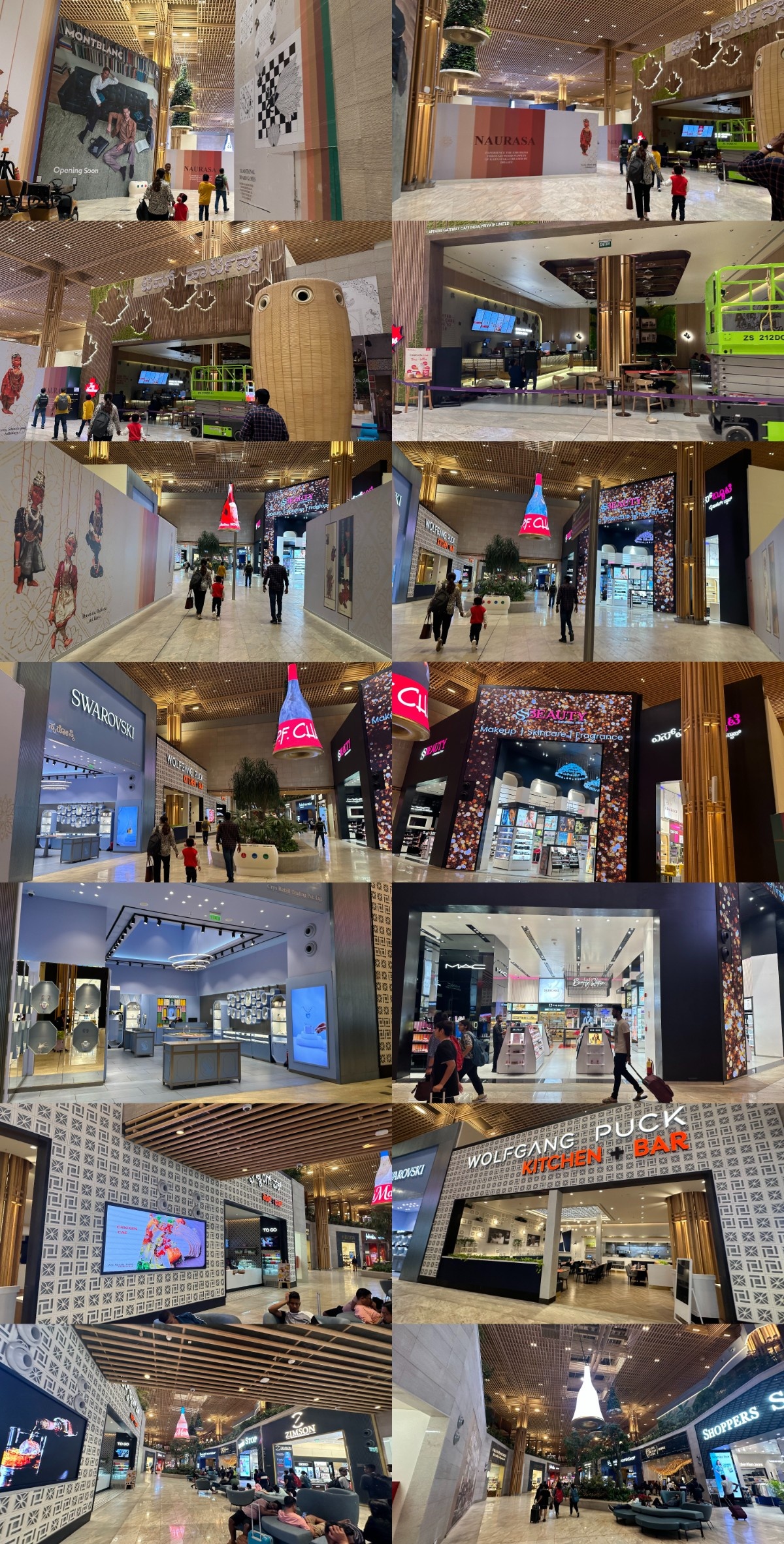
Alongside these decidedly international names — which I bet the airport management roped in to give Bengaluru a major leg-up over Delhi and Mumbai’s airports in terms of its rapidly globalising high-heeled clientele — were some familiar Indian retail/apparel brands like Shoppers Stop and Fabindia, the likes of which you’ll also find in BLR Terminal 1. There was also a very distinctive-looking confectionery store: Bon Voyage by CocoCart, with its foliage-covered exterior display wall and classy chocolate-brown décor, which débuted a few months before and is located opposite Smoor, a homegrown chocolatier.
Another thing you’ll notice is the prevalence of wall art depicting the city’s most peopled thoroughfares, from Brigade Road to Commercial Street. You’ll also find some old-timey paintings, nothing like this modern take on street art, in the international section of T2 depicting the idyllic streets of Bengaluru Bangalore from a century ago.
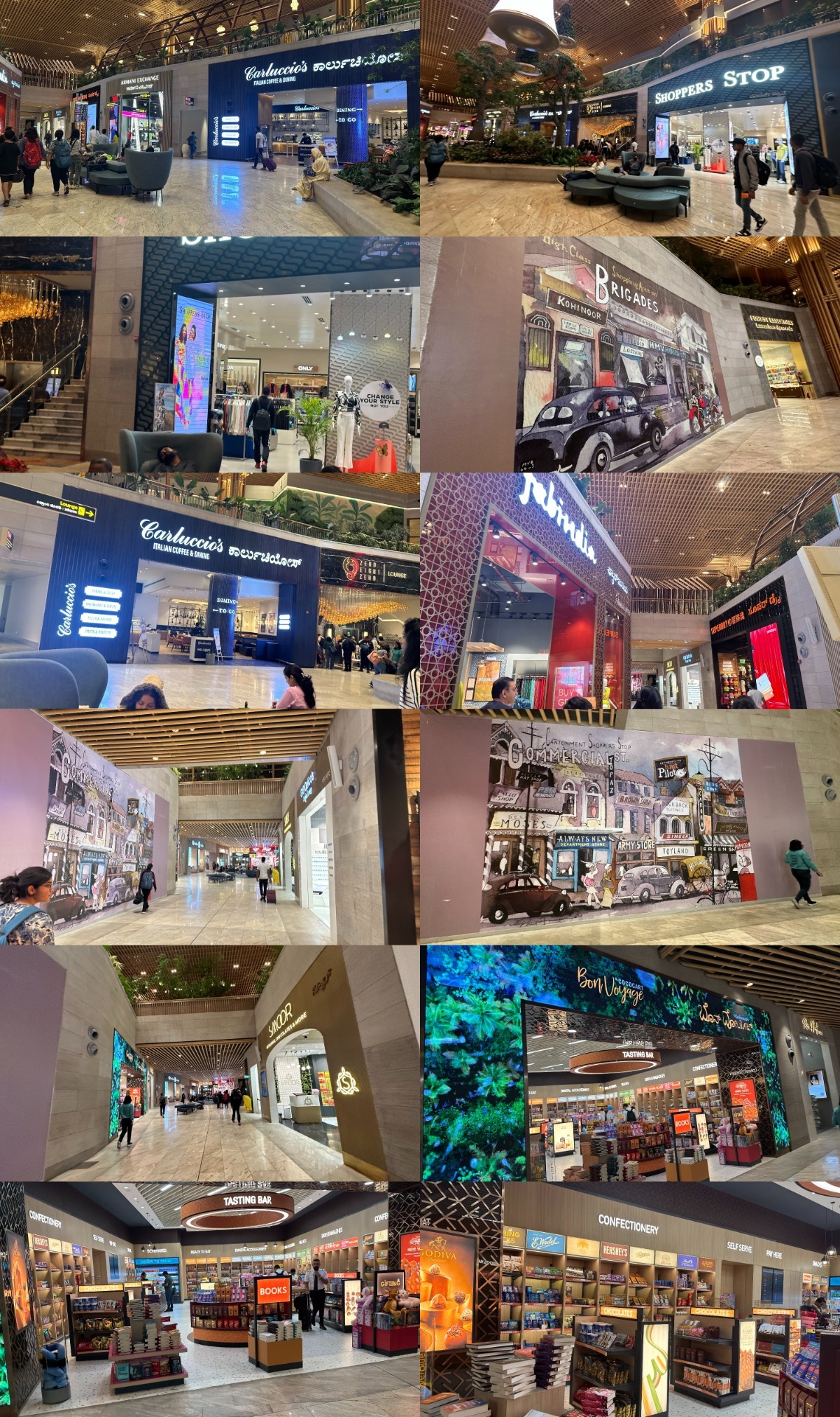
Yet, yes, there weren’t all that many generic fast-food chains (aside from this Starbucks) as you might find at BLR T1 or BOM T2, with the emphasis being on premium luxury brands. Among other global premium restaurants were James Martin Kitchen (third row below, left), Giraffe World Kitchen and the Johnny Rockets burger chain, which was present in Delhi a decade prior but had to pull out soon thereafter. Rest assured, I’d never heard of any of them before, given their absence from Singapore — or anywhere else in India!
Another noteworthy name was Jones The Grocer (fifth row, left), the Australian-origin artisan food chain with a number of branches especially in the UAE, Qatar and Saudi Arabia — but also Changi T2, with this being its first and, as of now, only Indian outlet. There were also a few homegrown Indian stores, like Satya Paul, Maiyas Restaurant and Gully Kitchen, and they exuded the same understated luxurious vibe as the others.
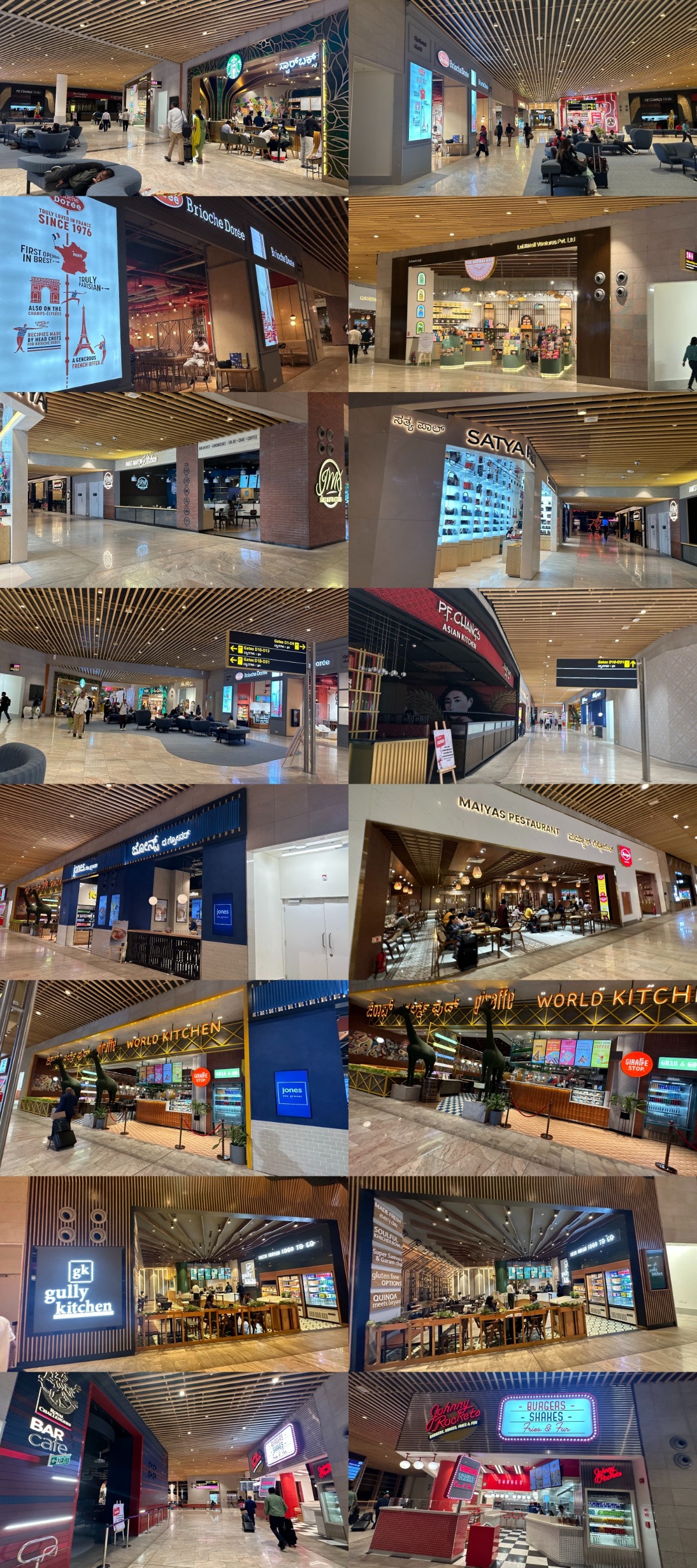
At length, I also chanced upon a Hard Rock Cafe: this is the iconic musical-themed restaurant chain’s second branch in Bengaluru, after the one at St Mark’s Road in the centre of the city’s pub-hopping district. I tired of roaming all over the place, and decided to get my breakfast fix once and for all from one of these rather expensive-looking eateries.
In my opinion, I think it would be better for such foreign restaurant chains to set up shop in the international part of T2, as the likes of Jamie Oliver’s Pizzeria have done, and keep the domestic section for famous Indian fast-food/specialty restaurant chains like Haldiram’s, Bikanervala and Punjab Grill — as is the case at BOM T2, as well as BLR’s Terminal 1 for that matter. Keeping everything pricey is only going to create the impression that this place (minus the Louis Vuittons and Cartiers of Changi) is for well-heeled nouveau-riche kids who think nothing of dropping thousands of rupees (tens of dollars) on a single item!
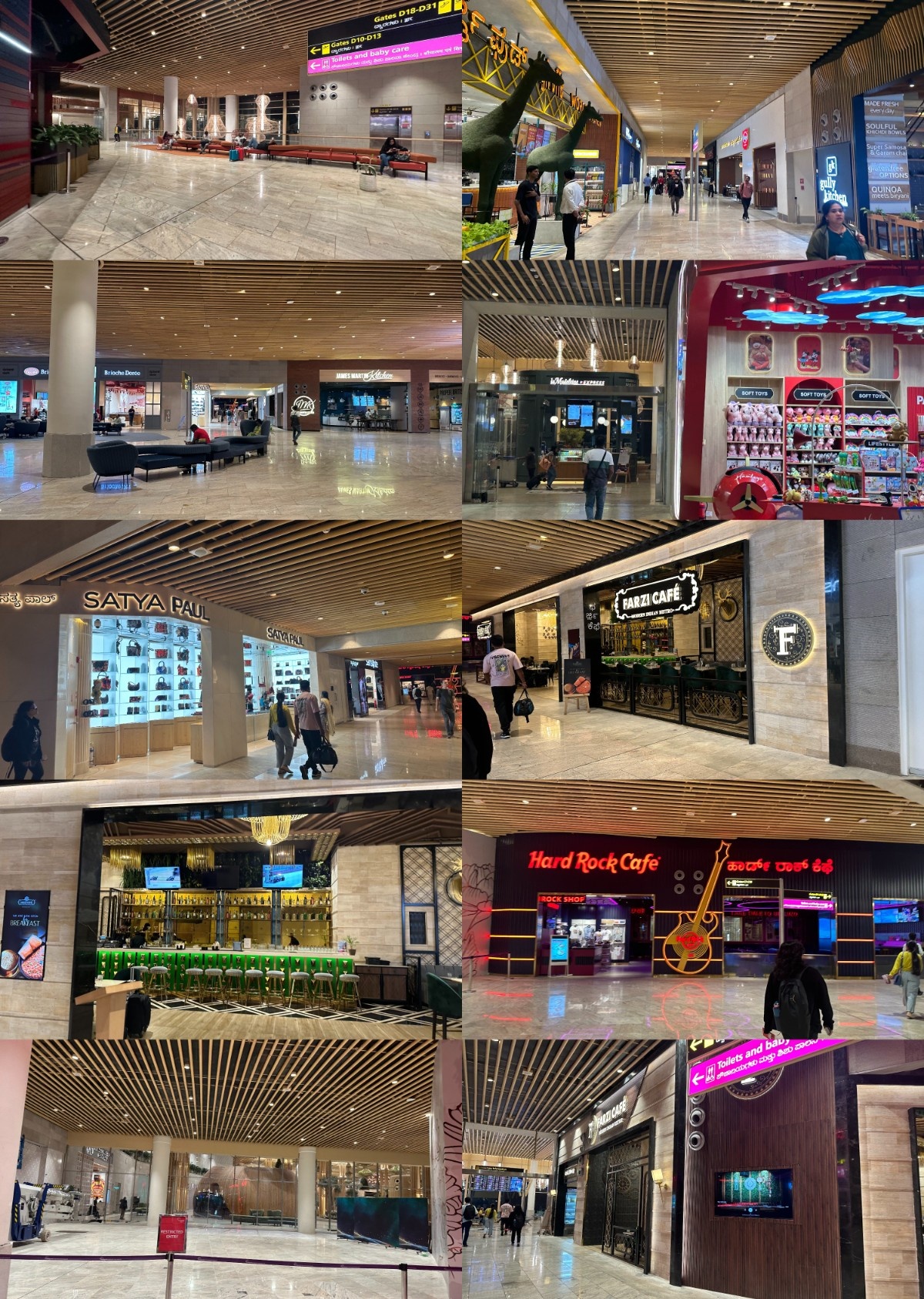
Eventually, I picked Brioche Dorée because of its array of muffins and puffs, and sandwiches and salads, none of which were below ₹200 (US$2.40) — but I doubt I would’ve found much better to eat at that early hour of dawn. The slogan may be ‘Frenchly Delicious’, but the prices were, at least in INR terms, exorbitant: the ₹530 (US$6.30) Butter Chicken & Cheese sandwich that I ended up choosing being a case in point. Well, at least the taste — and the décor, probably — made up for it. Tout est bien!
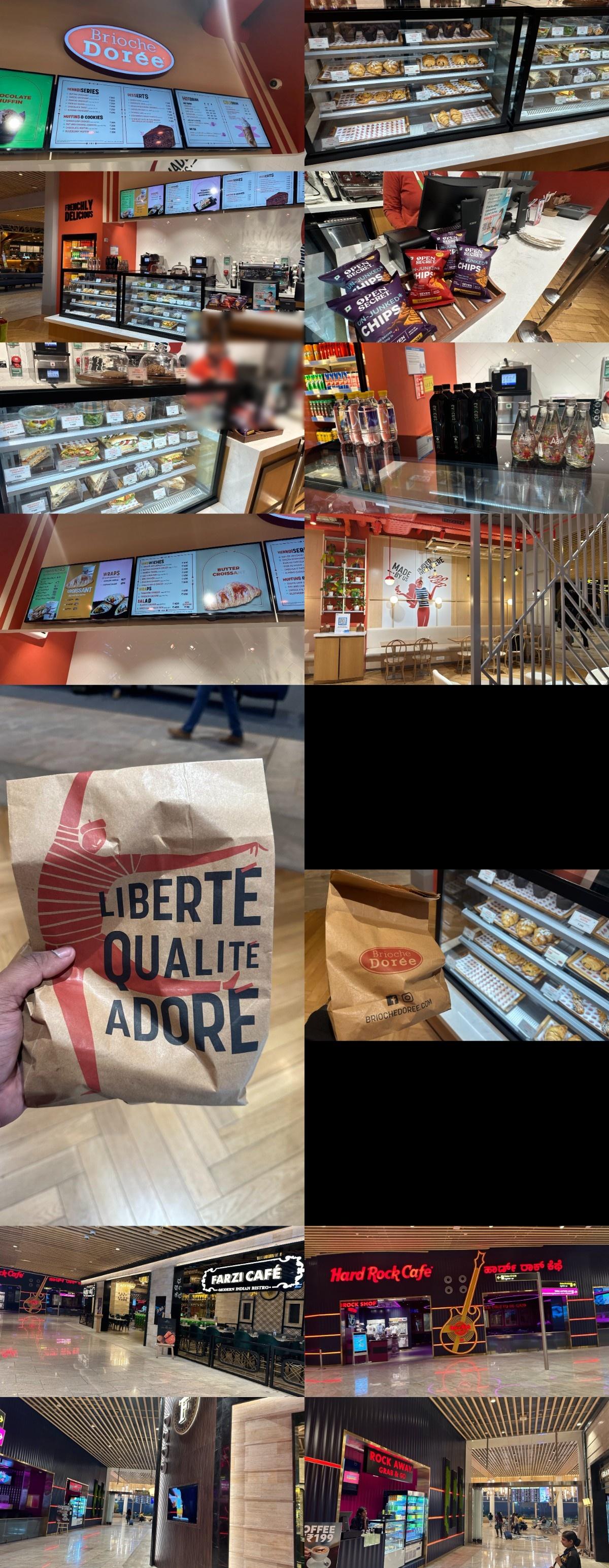
It was only at around 6:30 that I came to the boarding gates, with their ornately scuplted, brightly lit cylindrical lanterns and their endless seating areas. It goes without saying that I was badly short-changed for the better part of my life by fellow South Indian airport Chennai (MAA)’s never-good-enough government-run facility, where you should be lucky to have a functional food joint, with little more than KFC and Pizza Hut — and no proper bookstore like Relay or WHSmith. This was the opposite extreme: BLR T2’s domestic area was busy flexing all the luxury prowess it could humanly muster.
In my opinion, as far as Indian airports’ domestic retail offerings are concerned, BOM T2, as well as BLR T1 (even Hyderabad for that matter), strike the perfect balance by not being woefully underequipped like MAA, or filled with shops but still depressingly drab like DEL, all while having a number of familiar affordable Indian brands where travellers would actually like to shop.
Anyway, enough with the discussions on airport-retail costliness, and on with the main subject of today’s flight. There she stood: VT-JRB, Air India’s second A350, with sister-ship VT-JRA in the distance. This, then, would be operating my flight, AI589 to Mumbai — and I was beyond excited!
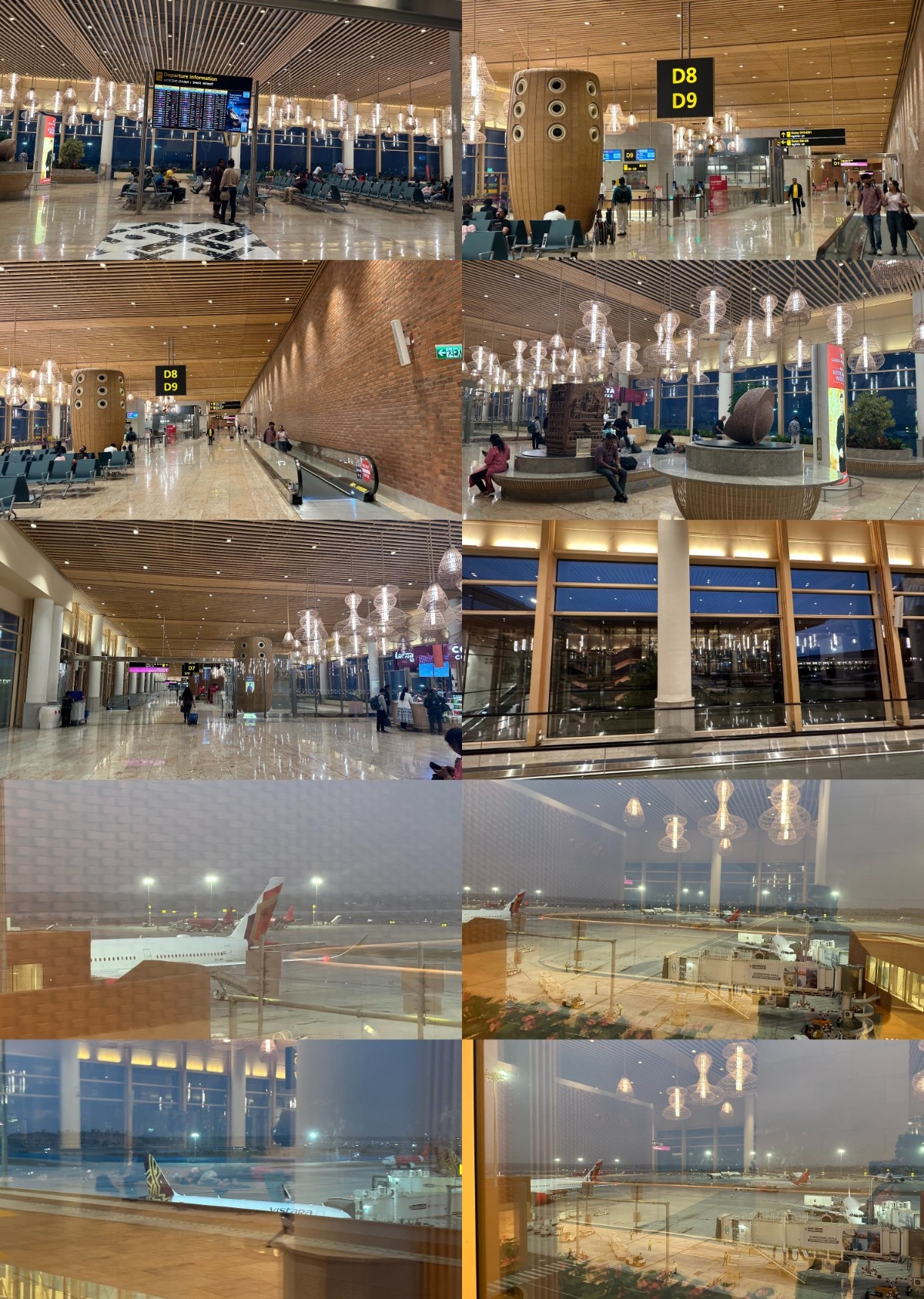
I went down a level on the escalator to the boarding gates. Boarding was quick to commence, and despite my Premium Economy ticket I was shepherded into the Economy queue. So much for priority boarding!
(VT-JRB had last landed at around 10 at night, along with a flurry of other domestic arrivals — several of which happened to be ATR 72s, aside from the standard A320/1neos (or, in the case of Akasa Air, 737 MAX 8s).)
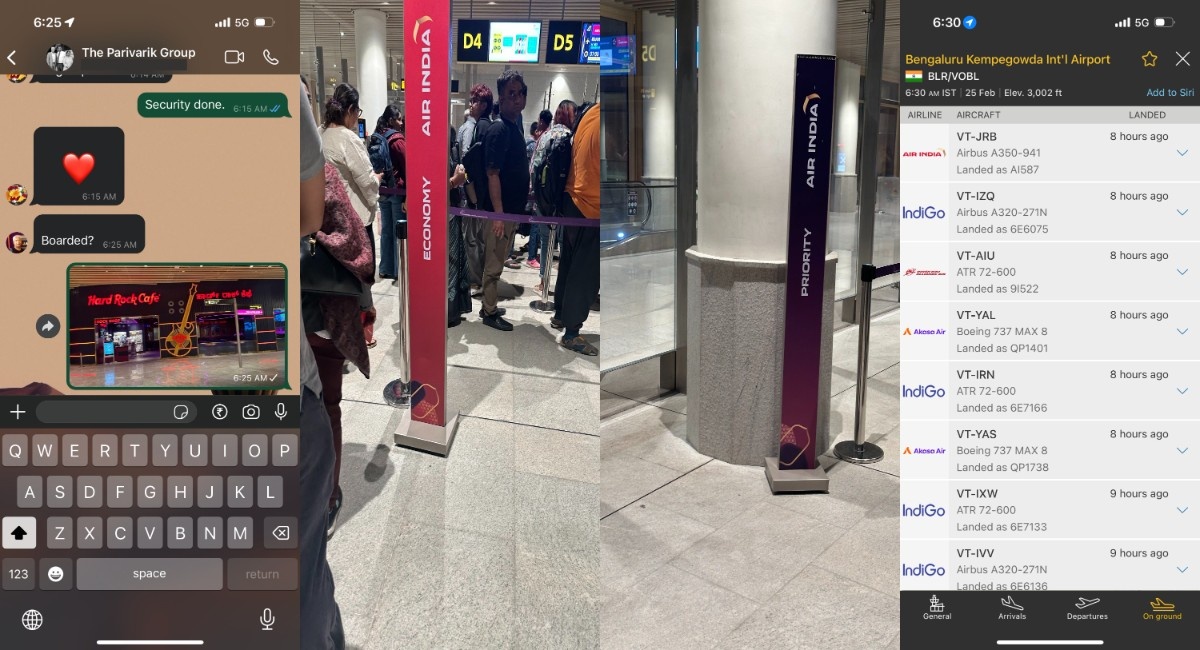
In moments I would be on board the new Air India A350, and given my underwhelming (if not horrendous) experience on the airline’s A320neo earlier that week — on a torturous 5.5-hour redeye with no magazine (let alone entertainment) at that — this was the kind of validation I was so eagerly looking forward to that the Tata Group (and, now, Singapore Airlines) was dead set on restoring it to its lost heights and former glory in the aviation world, of which the A350 was the most visible and prominent instrument!
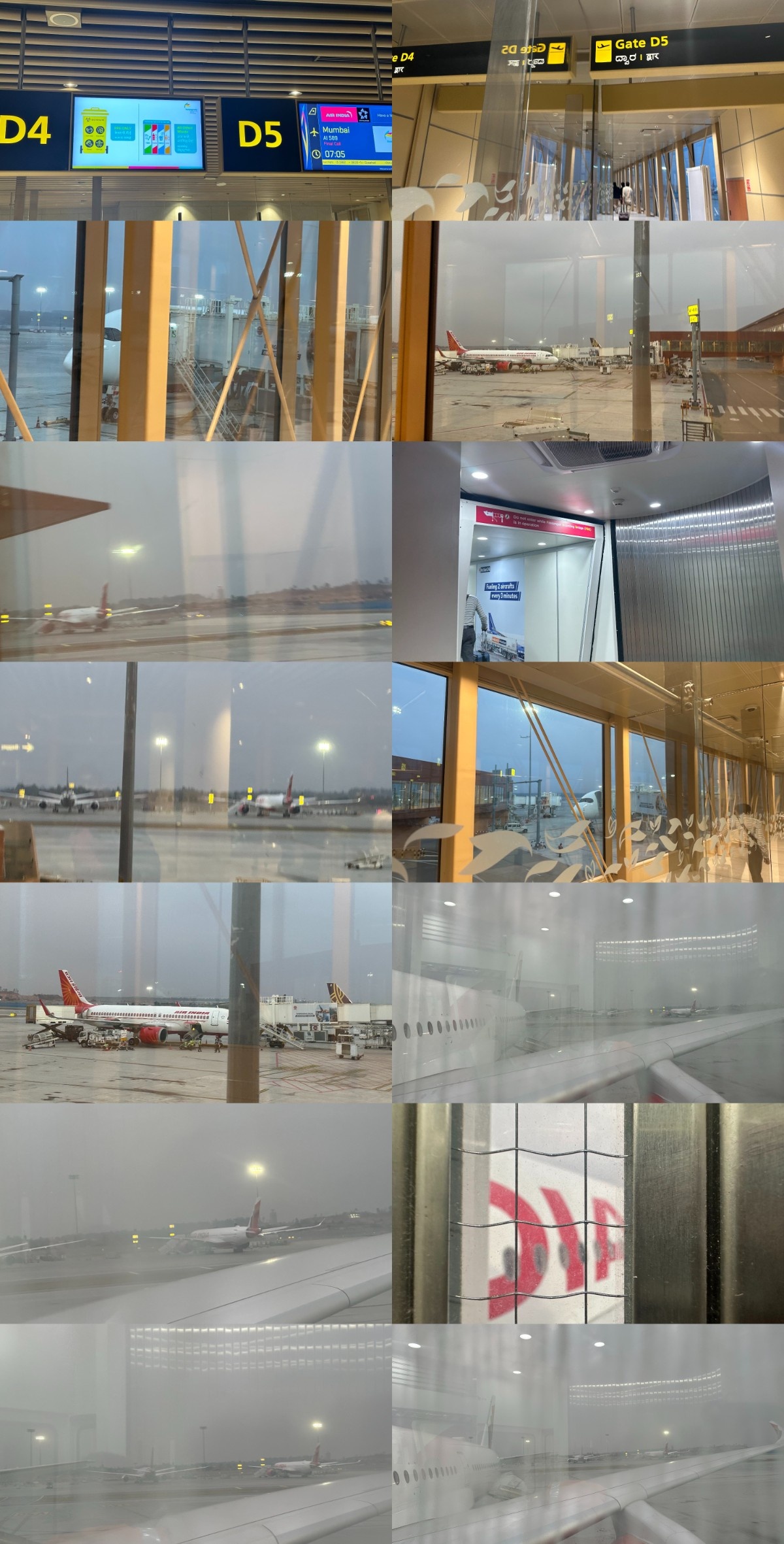
The flight: Boarding and departure
Flight: Air India AI589/AIC589
Date: Sunday, 25 February 2024
Route: Bengaluru Kempegowda (VOBL/BLR) to Mumbai Chhatrapati Shivaji Maharaj (VABB/BOM)
Aircraft: VT-JRB, Airbus A350-900
Age: 5 months at the time (built: 11 September 2023, delivered: 2 February 2024)
Seat: 10K (starboard side, window)
Boarding: 6:45am IST (UTC +5:30)
Departure: 7:30am IST
Arrival: 8:55am IST
Duration: 1 hour 25 minutes
Notes:
• Fourth airline’s A350 flown, and tenth A350 overall, after Singapore Airlines (five until then — or six when including the very next flight: SQ421, BOM–SIN, 9V-SHL), Thai Airways (three) and Cathay Pacific Airways (one).*
The A350-900 is far and away my most frequent widebody flown, thanks singlehandedly to Singapore Airlines and its 9V-SH* series of medium-haul or regionally configured A350s, of which I’ve flown six so far — to and from Bangkok, to and from Bengaluru, from Hanoi and now from Mumbai! There was also 9V-SMF, the 10,000th Airbus of all time, to Kuala Lumpur in 2022.
• First widebody flown on Air India other than the 787-8, which I’d flown on two previous occasions, both between Chennai and Singapore. VT-ANX on 7 October 2018 (AI346, MAA–SIN) was my first widebody aircraft ever, while VT-ANO on 11 December 2021 (AI347) was my only flight for the entire year, given that travel was largely COVID-restricted. Besides AI, I’ve flown the 787-8 on another Star Alliance carrier, Ethiopian Airlines, from Kuala Lumpur to Singapore in May 2023.
*In August 2024, I flew two more A350s from CX (SIN–HKG–BKK) and later one more each from TG and SQ: a number that could’ve been greater if not for TG’s penchant of deploying the dated 777-200ER every now and then on the Bengaluru route (which is otherwise operated by the A350) — as I was victim of, twice, with ‘repeat offender’ HS-TJW (once again) rising to the occasion both times!
A rather Russian foundation to the product, with Indian finishing touches
As I noted in my original mini-review of this flight, much of the décor was largely preserved from its intended-for-Aeroflot configuration, with the blue and bronze trims being a signature of the Russian flag carrier. The business-class product was Collins Aerospace’s Horizon enclosed-suite product with doors, and indeed Aeroflot was the only airline to operate this product until the invasion of Ukraine and resultant sanctions caused four of its A350s to wind up with Turkish Airlines (TC-LGI–LGL) and six more with AI, with another (EC-NOI) going to Spanish charter carrier World2fly.
On my part, I settled in the two-row premium-economy cabin, at seat 10K: I always have a preference for K-seats (right-hand window seats) that are as far back as possible from the bulkhead, but since there were only two rows, I selected the one behind. Immediately I was treated to gorgeous views of the engine and winglet with the new Air India logo pattern, and even a tail camera feed on the bulkhead monitors — not to mention the revamped safety card and Namaste.AI magazine!
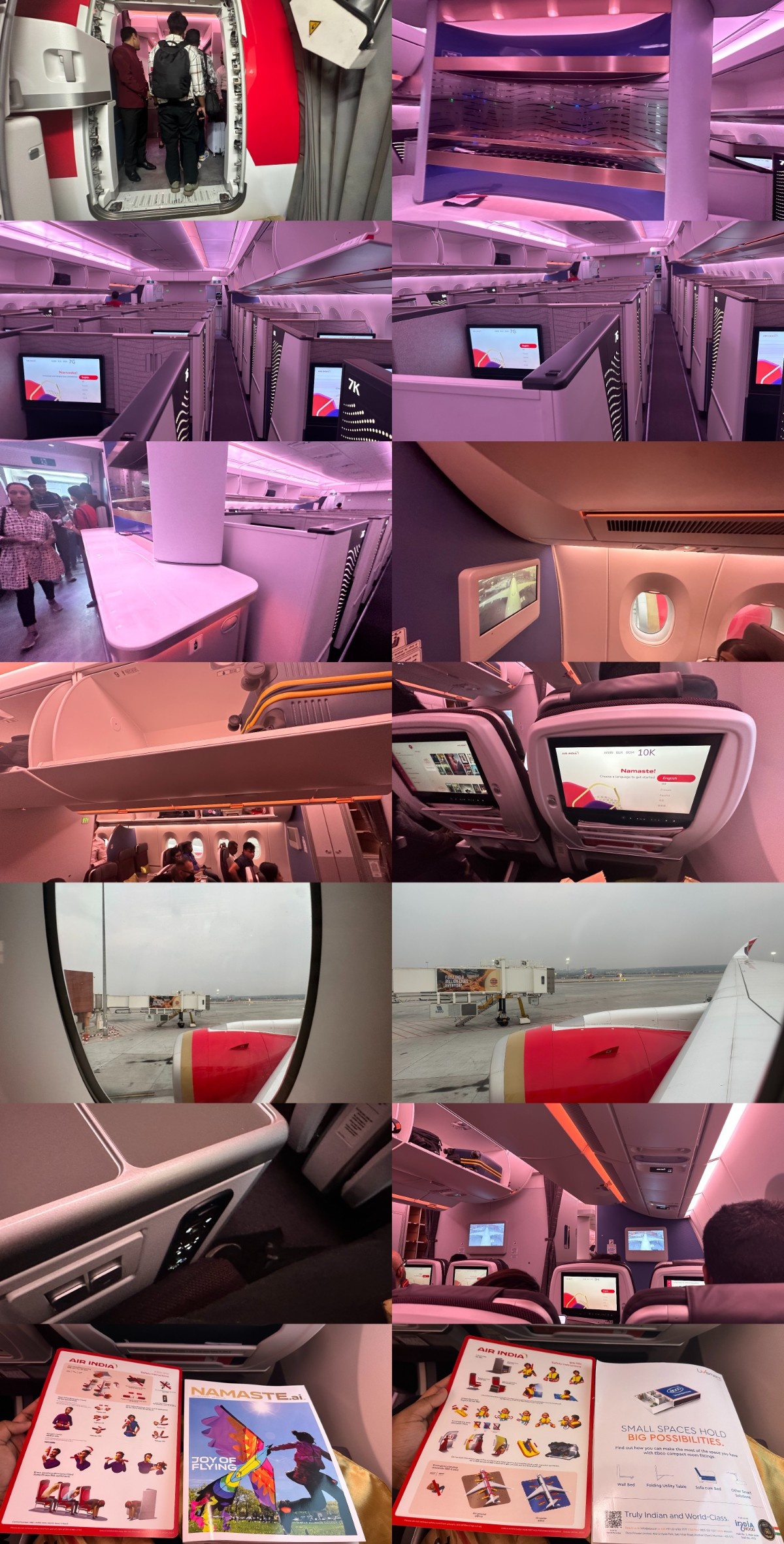
The Panasonic eX3 IFE was busy doing its Namaste-ing, in six languages, including two European (Deutsch and Français) and two East Asian (Japanese and Chinese) ones. This big 4K monitor for the premium-economy cabin was a massive upgrade over the displays on even Singapore Airlines’ regional A350s, which I’m accustomed to flying on, not to mention A380s and 787s. When even these screens were so crisp and clear — bringing my Cathay Pacific A321neo flight to Hanoi, two months prior (December), to mind — just how brilliant would the ones up front in Business Class be?! (Like the CX A321neo, and unlike most other IFEs I’ve seen — be it SQ, the CX A350, KLM or Thai — this one was light-themed instead of dark-themed.)
A male flight attendant soon rolled out the welcome drinks, with the choice being plain water or orange juice, and I selected the latter. Disposable earphones were also handed out, which, regrettably (like the airsickness bag), used the old Air India logo. I certainly appreciated the gesture of a pre-departure beverage (as well as subsequently hot towels): a rarity on Indian flights, and likely a function of this higher-than-economy cabin.
Let me also note that the boarding music was a novel and refreshing change from before, and while not the soft instrumental tones of the A320neo to Delhi, this was something I’d gladly listen to at home — if it were uploaded online! (In January, a month before this flight, The Economic Times had an article called, amusingly, ‘Bored of boarding music? Air India, try this playlist’!)
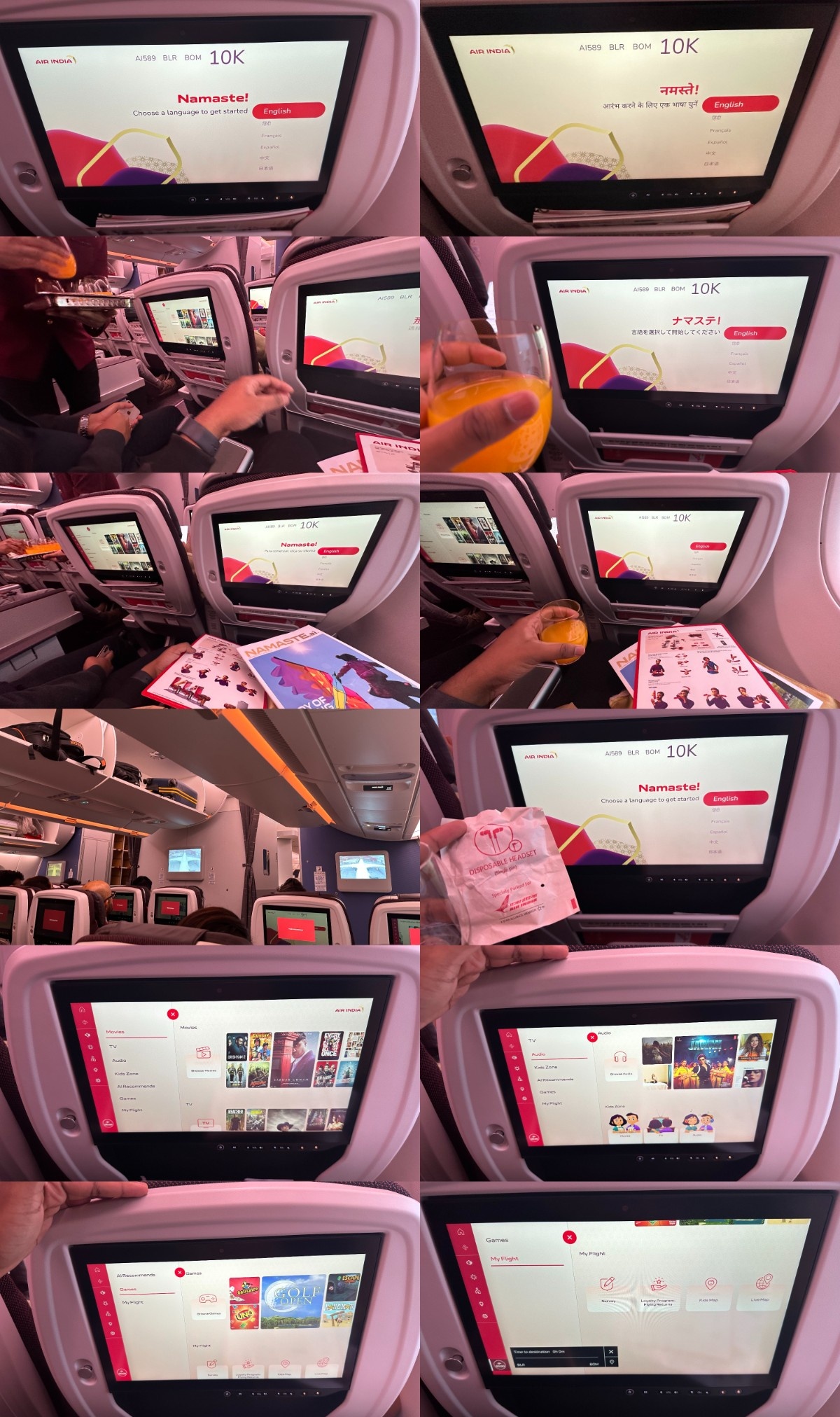
An upside of this latest-generation Panasonic ex3 IFE, as Runway Girl Network noted in its analysis of Air India’s IFE transformation, was that it also featured Panasonic’s Arc moving-map system, perhaps the most technically advanced I’ve seen. I’d encountered it before on the Vistara A321neo — actually the world’s first airline to introduce it — and which is also present on such aircraft as the Singapore Airlines 737 MAX (sadly, not on any of its widebodies) and the Etihad A350-1000.
Below you can see the various options for camera angles, route previews and destination overviews that Arc is capable of displaying. I’d zoomed in on Mumbai, which is quickly becoming my all-around favourite city in India in every aspect possible, with its manic electric vibe and energy cutting through entertainment, finance and business. Though, as an outsider, I must beware that the grass is often greener on the other side! (Full resolution here.)
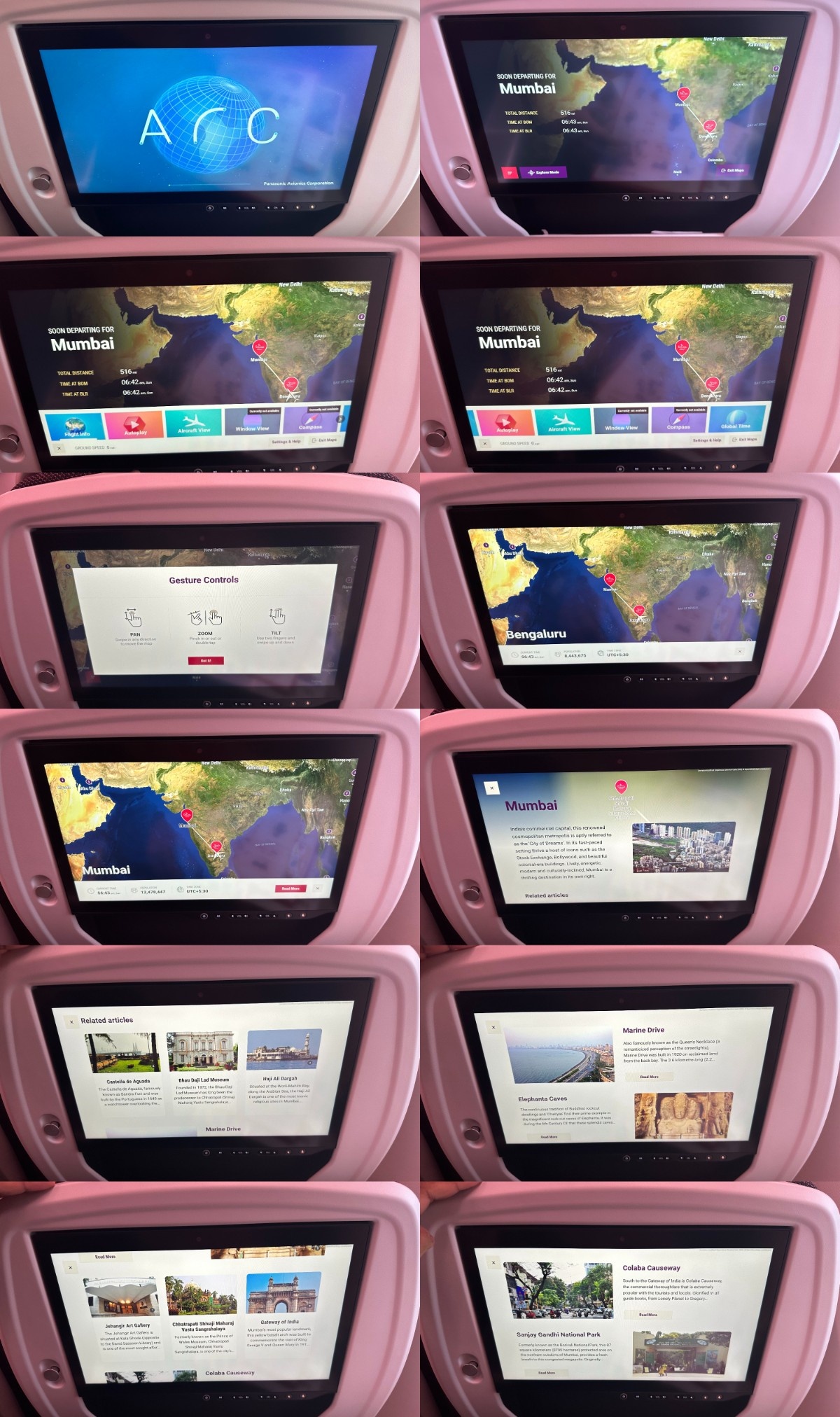
I also zoomed in on Delhi, the national capital, and a city I absolutely can’t bring myself to like in any way whatsoever. Stodgy political atmospheres, set-in-their-ways conservative mindsets, smoggy pollution-filled skies (often gravely so) and a massively drab, boring airport to boot (as I’d seen earlier that week)… there’s very little redeeming about that place.
And Bengaluru? While infamous for its bumper-to-bumper traffic, higher-altitude cool weather, frenetic frenzied streets and shortage of various resources (especially water), I’ll gladly take the splendour of Kempegowda Airport — never mind the 47-km, often 2-plus-hour commute that it entails — over the laidback coastal charm of Chennai with a horrible airport!
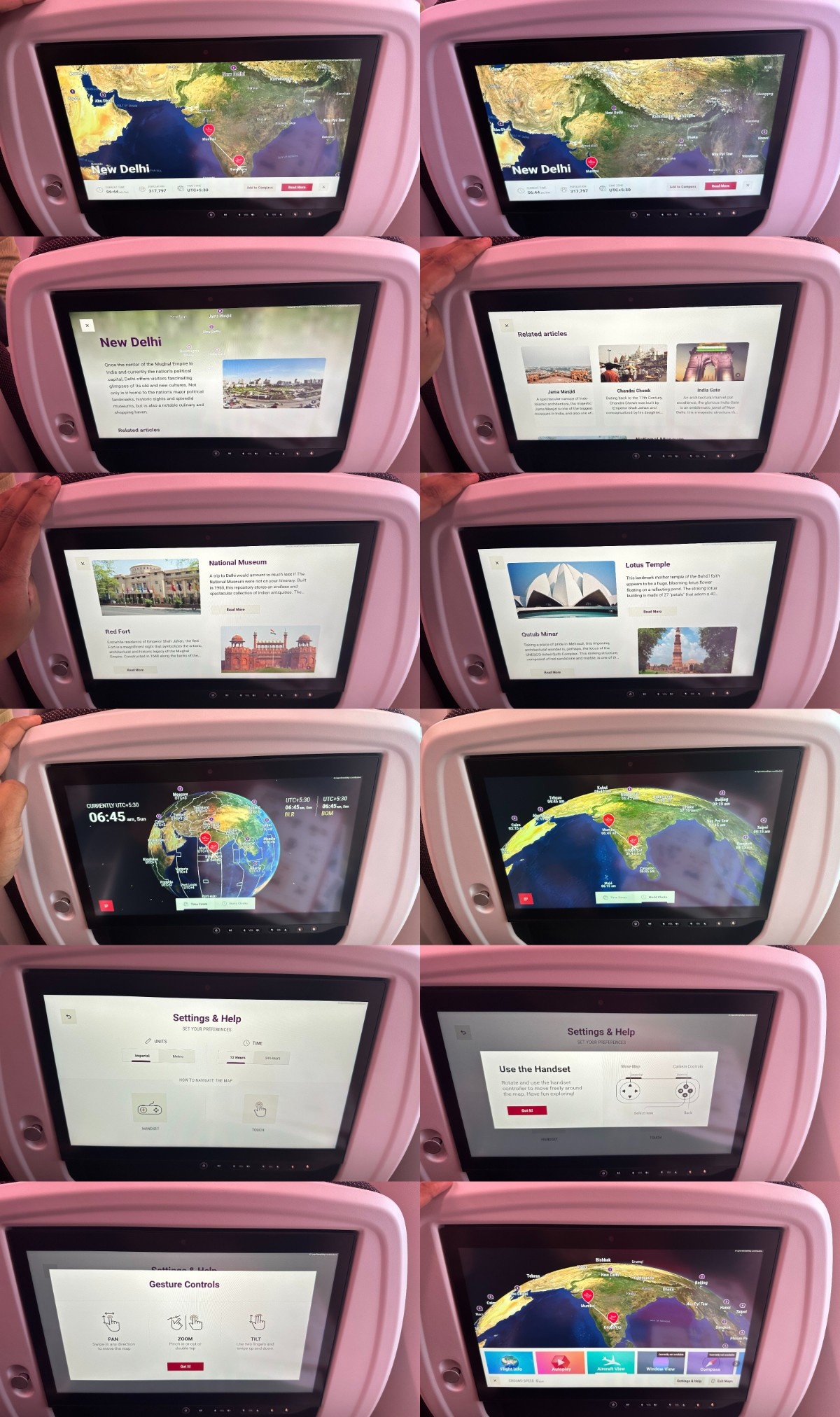
At 6:45, Melissa, a saree-clad Indian flight attendant despite her Western name, handed out the menus for Premium Economy — something I’d also received on Vistara’s A320neo two months back. While the menu featured AI’s old logo, I’m willing to forgive it because this menu design was actually introduced just after the Tata Group had taken over the airline in January 2022, and featured the rare, exclusive Concourse font. The options read as follows: (Full resolution here.)
Breakfast:
Fresh seasonal cut fruits
Butter Baked Croissant, served with preserves
Entrée:
• Western option: Roasted Garlic and Spinach Stuffed Roulade of Egg served with chicken sausages, herbed mushrooms, cherry tomato and prune compote
• South Indian option: Ven Pongal, Palak Corn Dosa and Paniyaram served with sambar
• North Indian option: Masala Moong Dal and Palak Paneer Kabab served with vegetable paratha
On the whole the menu descriptions were very formal, as you might expect on a full-service carrier: quite in contrast to the fun-filled, drool-inducing way the (absolutely scrumptious) pre-ordered meals from the ‘Gourmair’ menu were described on my Air India Express A320 flight four days prior. Having gone with the Western option on Vistara two months before, I didn’t choose that this time around, so what did I choose? You’ll need to scroll further down to find out!
But wait a moment, be patient, hold your horses; we need to take off first, and soar into a new chapter of Indian aviation, with the tail camera feed for company.
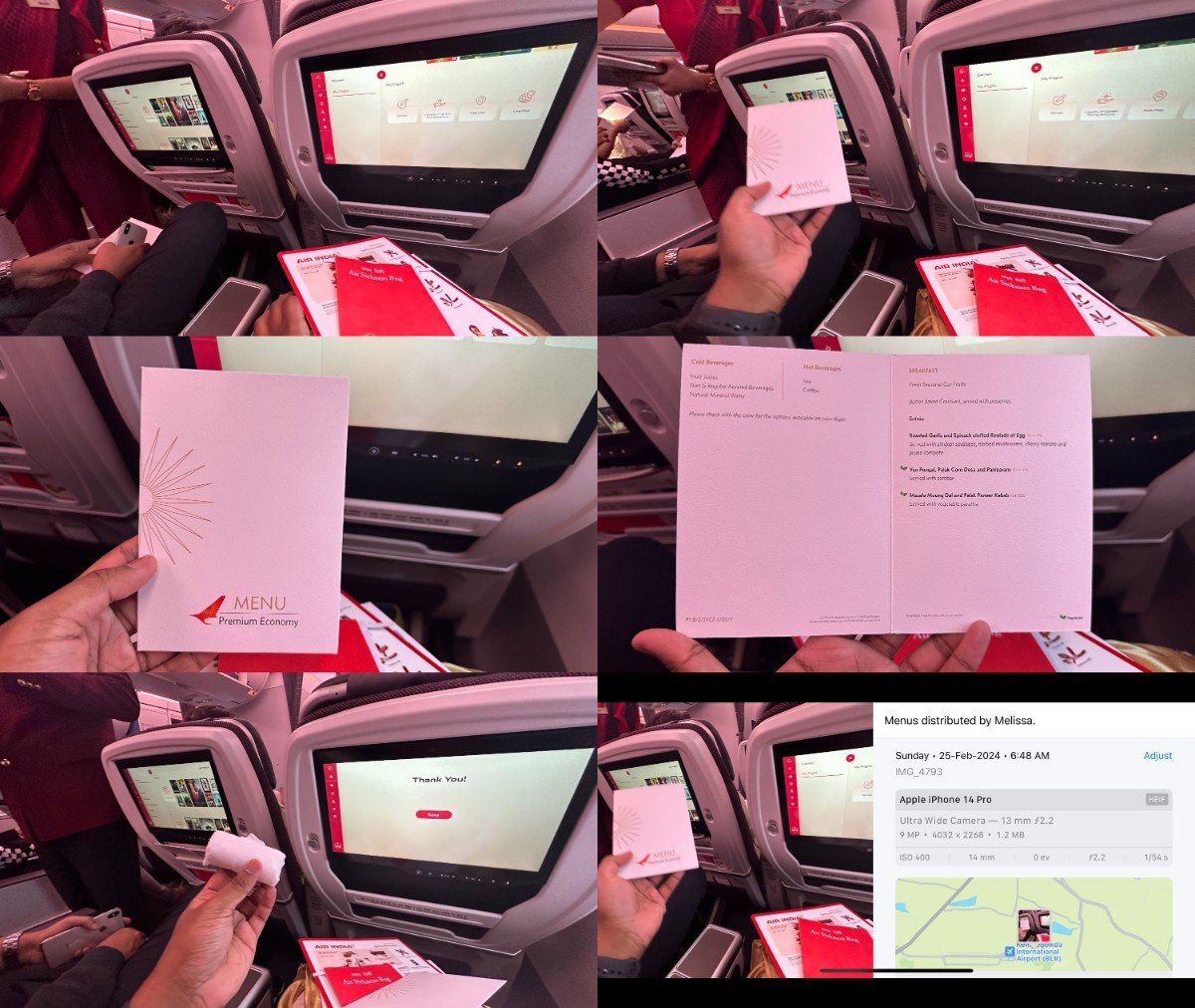
Now I busied myself reading about the Flying Returns frequent-flyer programme, which was revamped in April 2024 with much easier elite qualification requirements. While it wasn’t all that attractive at that point, the information was presented in an excellent, modern, concise manner like never before.
After this I came to the service survey, which I usually skip, but this time around I was tempted to answer every question — and very positively at that. (Full resolution here.)
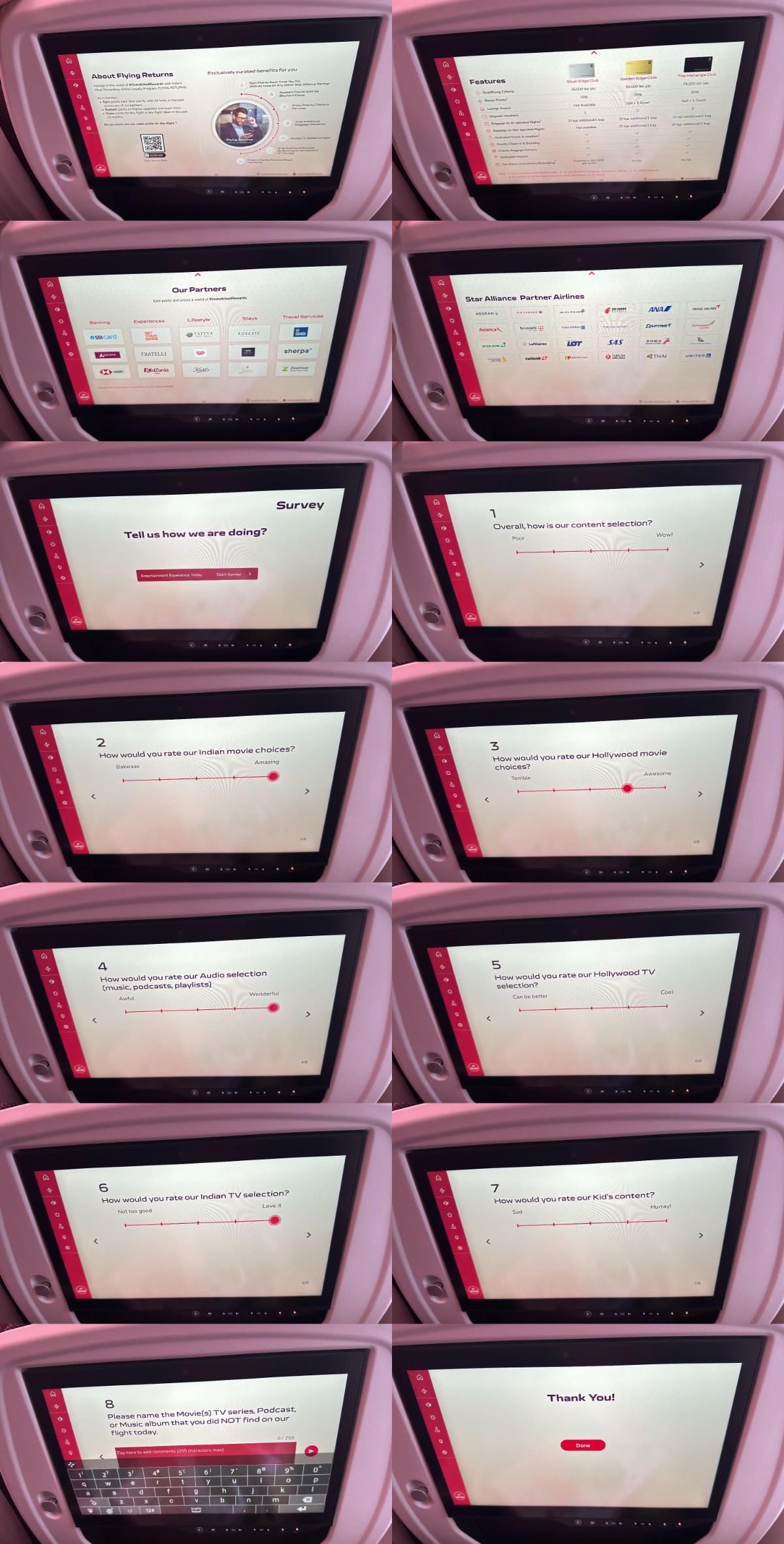
Now I came to the actual entertainment selection, and I, being someone who seldom looks beyond Bollywood for an inflight watch, was more than overjoyed to find a rich selection of both Indian and Western movies on offer. (Full resolution here.)
Too bad that this 90-minute flight would be too short to watch any of them — but I still did get to enjoy the best of Bollywood, and Shah Rukh Khan in particular! (How? You’ll find out very soon.)
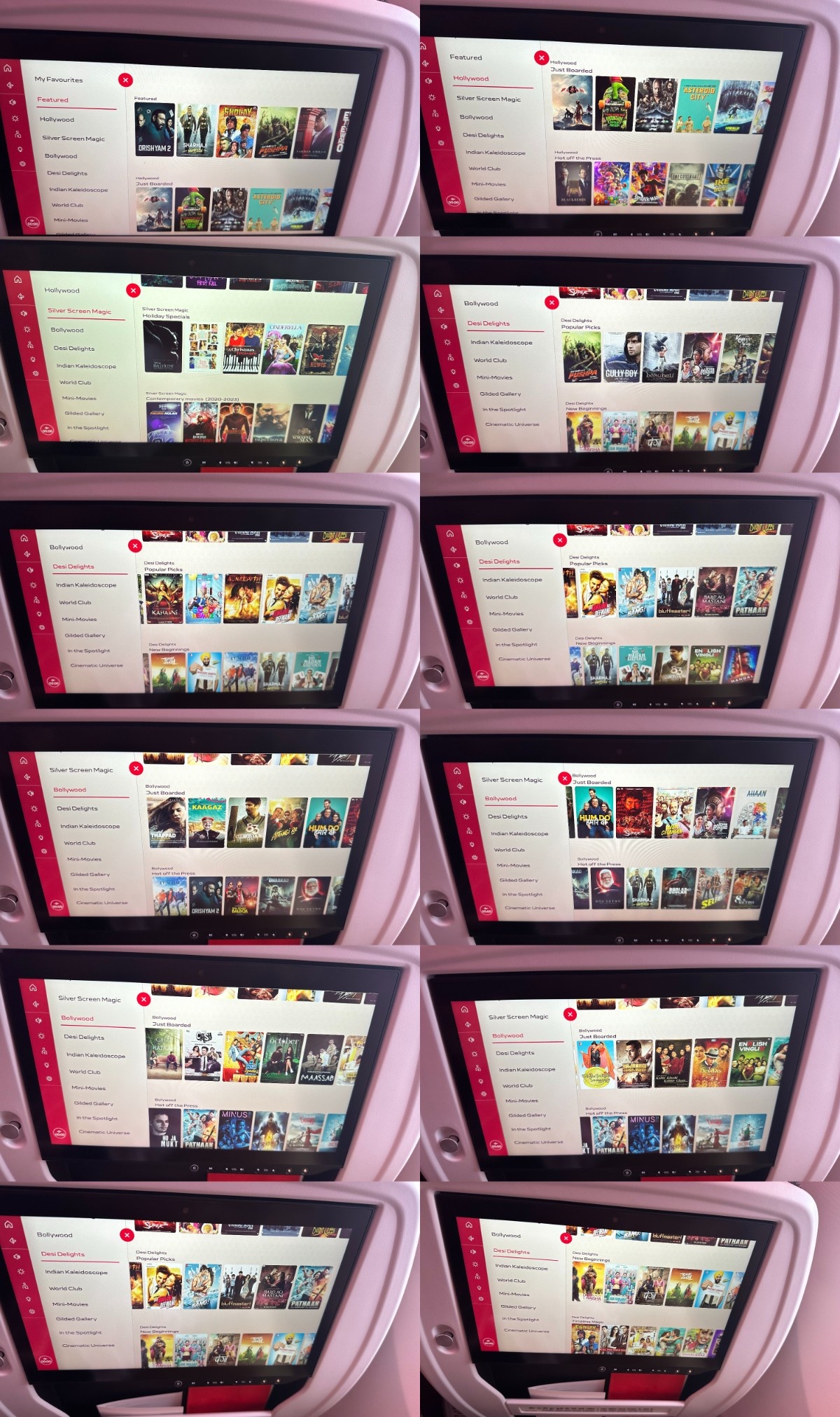
As always my parents wished me a safe journey with God’s blessings, while I received a couple of SMSes informing me about my baggage tags, something I’d never seen before. I looked at the recent flying history of VT-JRB, which was rather repetitive — flying around southern India plus Mumbai on short triangular hops — and then the SQ A350s in the air, including 9V-SHL which would operate my next flight.
I’m afraid the lead FA’s welcome was one of the driest and most boring welcome announcements I’ve ever heard. On the previous embarrassment of an A320neo, Cabin Executive Neha added a few special touches like ‘we hope you enjoy our Indian hospitality’ towards the end, but this one, Vandana, was practically reading from a book — pretty much the same announcement, word for word, minus that small touch. She had no intonation or charm whatsoever, and thankfully she was serving the suites up front; I had much more personable people serving me in this cabin.
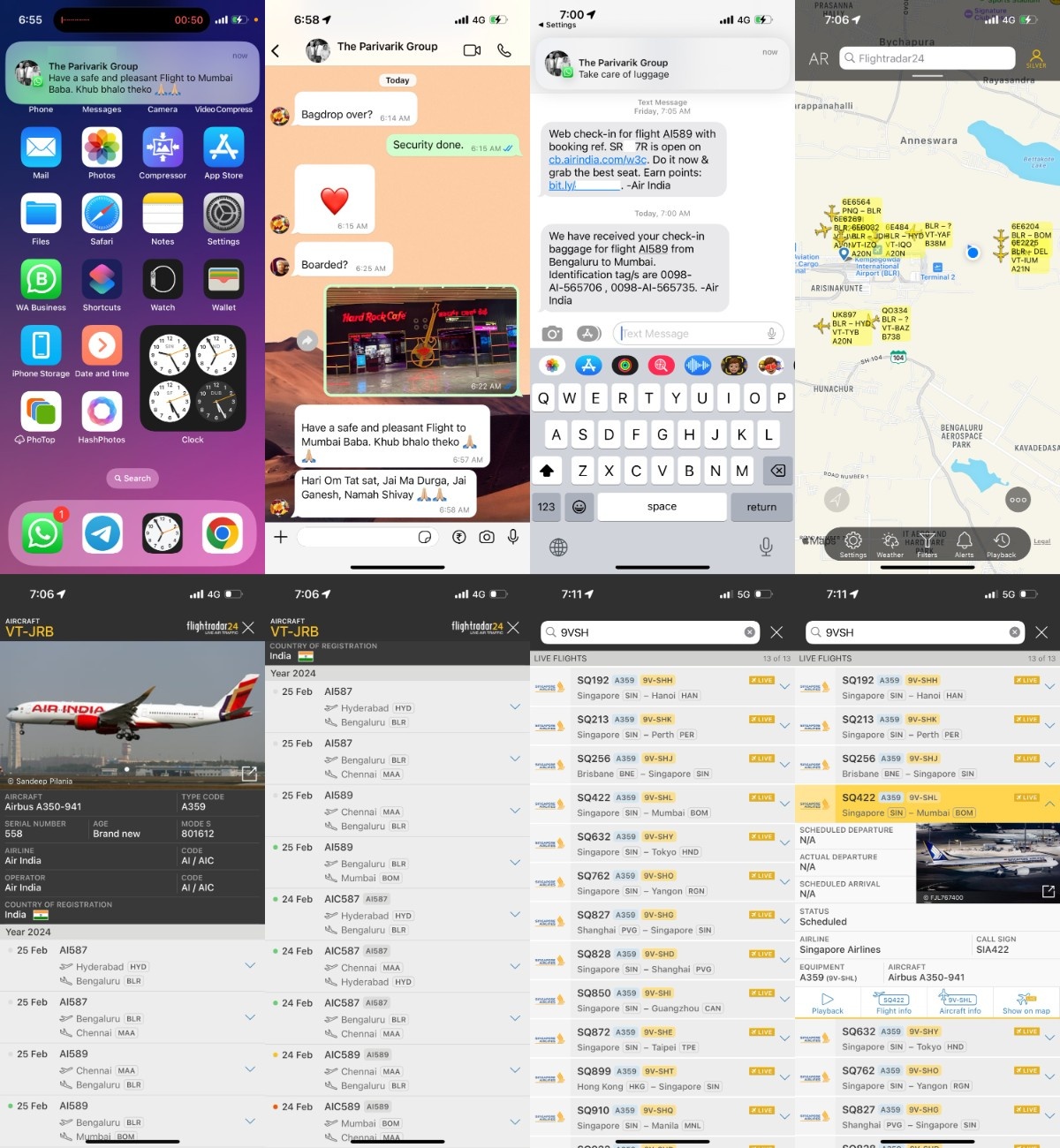
Shortly thereafter, as I mentioned, the manual safety demonstration was performed — there being no screening of the latest dance-inspired safety video, never mind that this was the highest-tech Air India aircraft in ages. This phenomenon would repeat itself on a short trip to Jakarta and Kuala Lumpur in June 2024, where neither the Garuda A330-900neo (SIN–CGK) nor the KLM 787-9 (CGK–KUL) had a safety video, despite the modern nature of the aircraft! (There was a small reminder asking business-class passengers to keep their suite doors open during takeoff.)
Meanwhile we pulled out of the gate and drove past some interesting non-IndiGo aircraft: a couple of Embraers of regional airline Star Air — an Embraer 175 E-Jet and a smaller E135 — and then none other than VT-JRA herself. To have a view of one elegantly exquisite AI A350 while sitting in the other is something you could only have at BLR at the time — but going forward this will only be possible at Delhi! And then came VT-TSO, a Vistara 787-9 that’s a rarity at Bengaluru, given that all but one (PNQ–SIN) of the short-lived airline’s international routes — certainly all the 787 routes — were only from DEL and BOM.
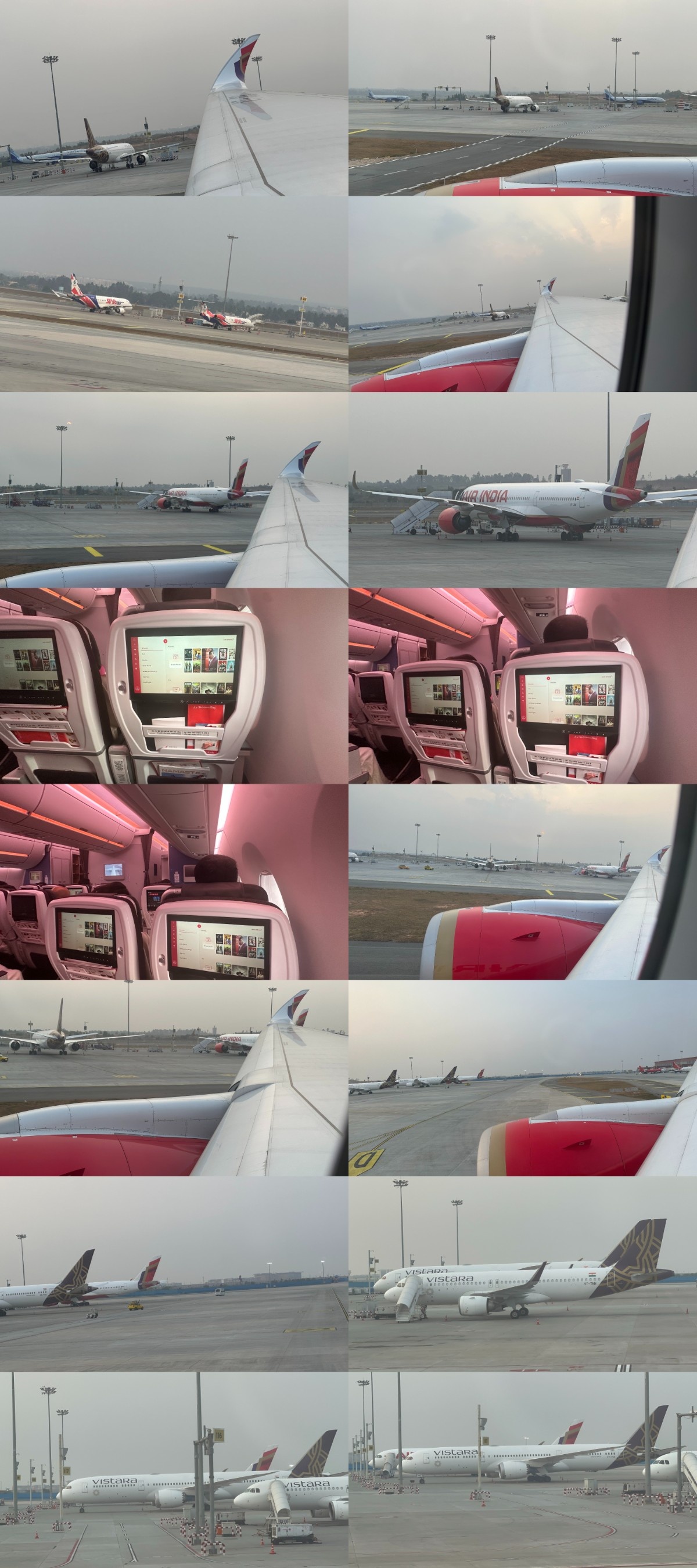
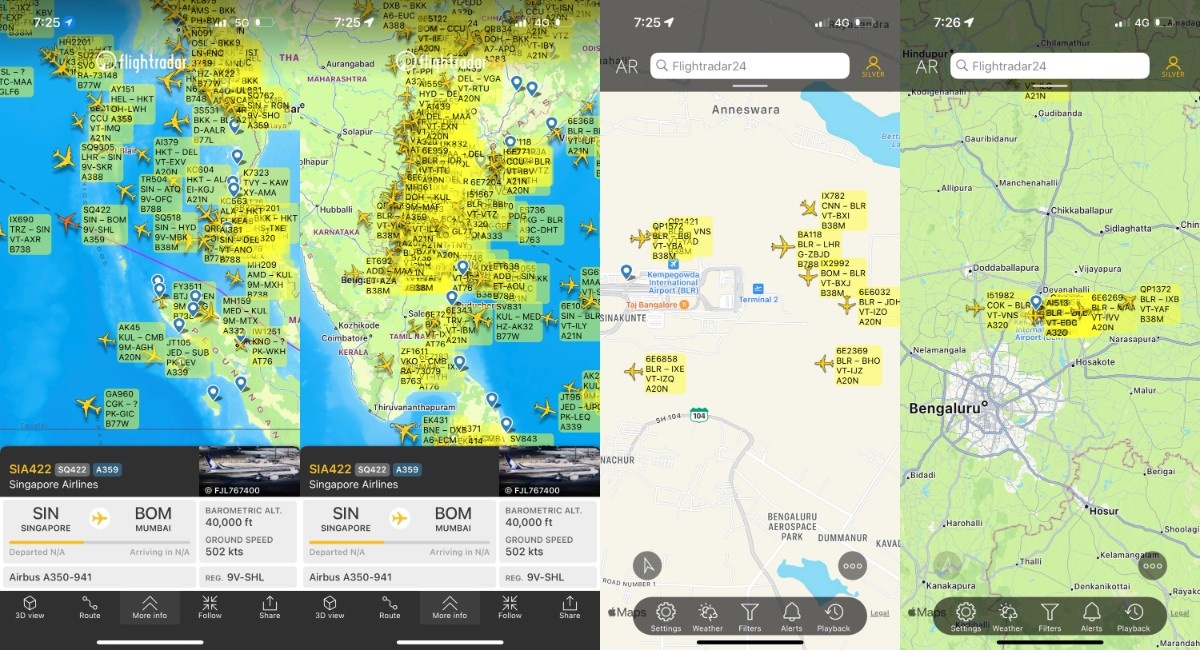
I continued to tweak and fiddle with the settings as we turned around on the runway, with a British Airways 787 — BA flew the A350-1000 to BLR prepandemic but not any more — parked in the distance, followed by an Air India Express 737 MAX 8 (VT-BXC) in the new livery design.
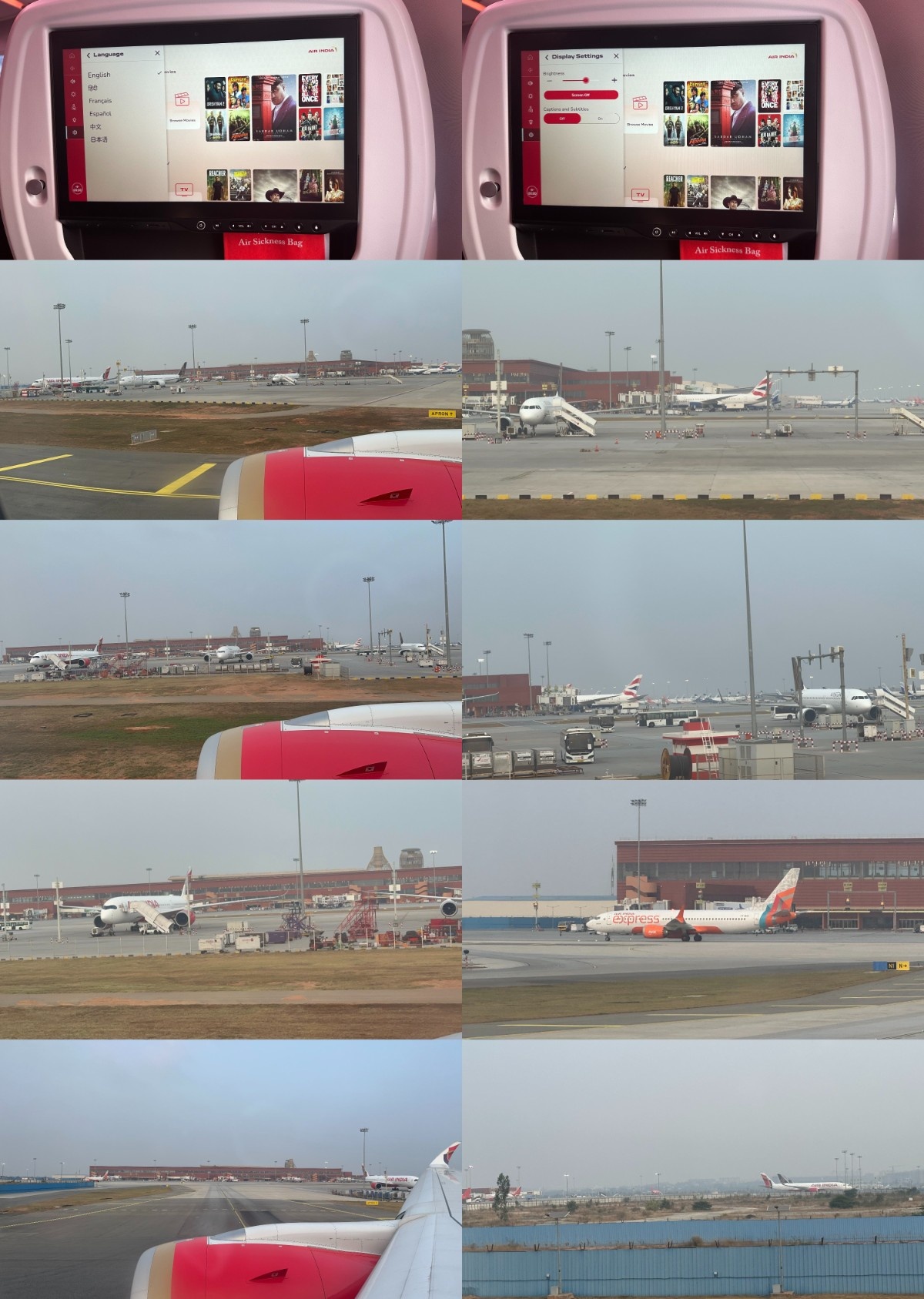
If an A350 has a tail camera, I’m sure as heck guaranteed to use it. Given that most of my A350 flights have been on SQ, which doesn’t have this option (a shame!), I seized the opportunity to lord over the takeoff roll with a majestic camera view of the graceful giant. There were both a tail camera and a forward camera, and naturally I settled for the former like any true avgeek will. We continued to whir and whir, and rev and rev, and then…
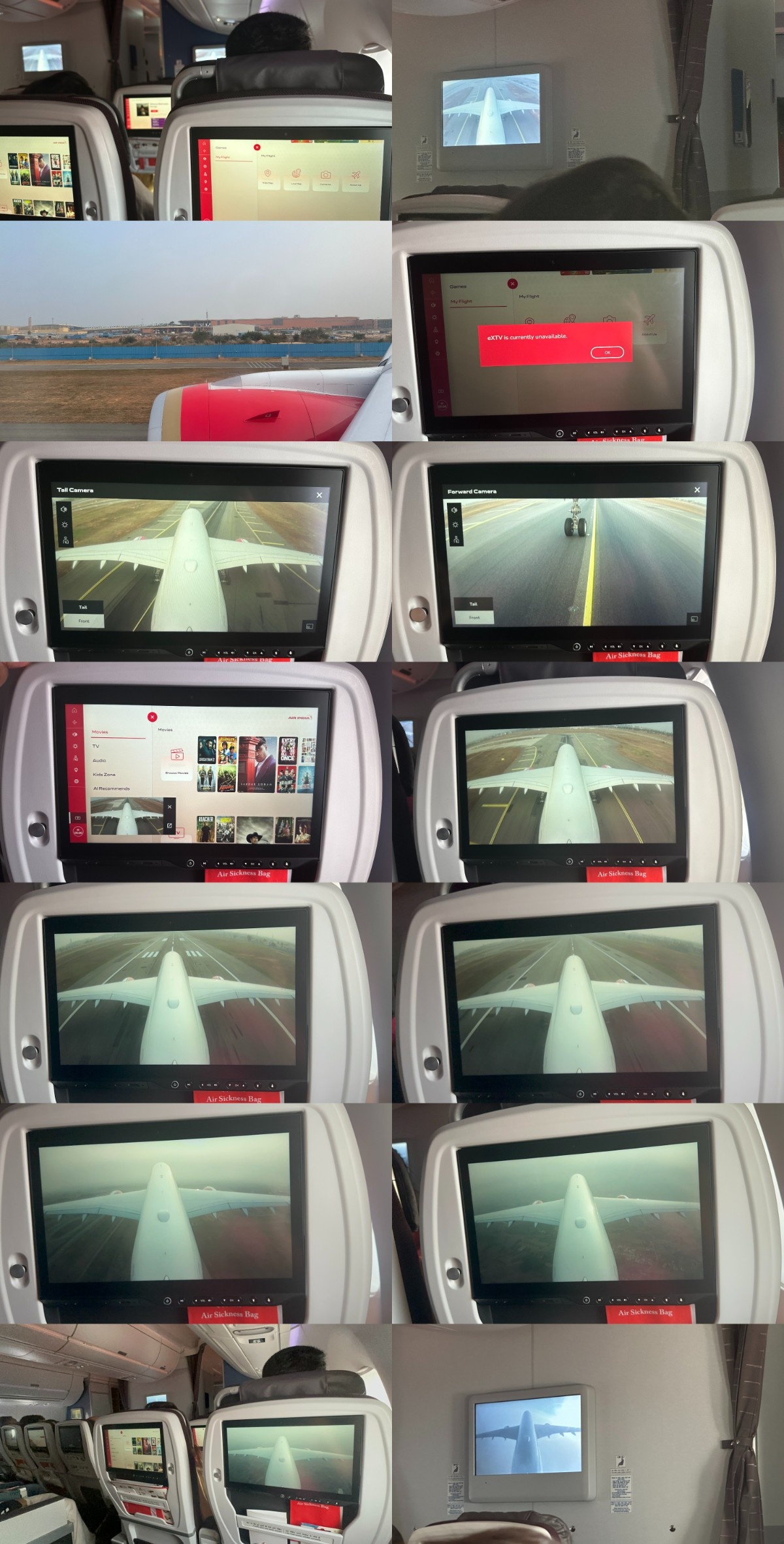
Whoosh! VT-JRB and those Rolls-Royce XWB engines lifted off into the skies above Bengaluru, literally and metaphorically symbolising an ascent into a new era of Indian commercial aviation in the mid-2020s and beyond. An era bereft of the enduring legacy of Jet Airways and now Vistara, but spearheaded chiefly by Air India (Express) and IndiGo — one premium-focused with a baggage of bad history, the other slowly shedding its low-cost image — as the torchbearers of the world’s largest population’s desire to travel, and, indeed, to set themselves free.
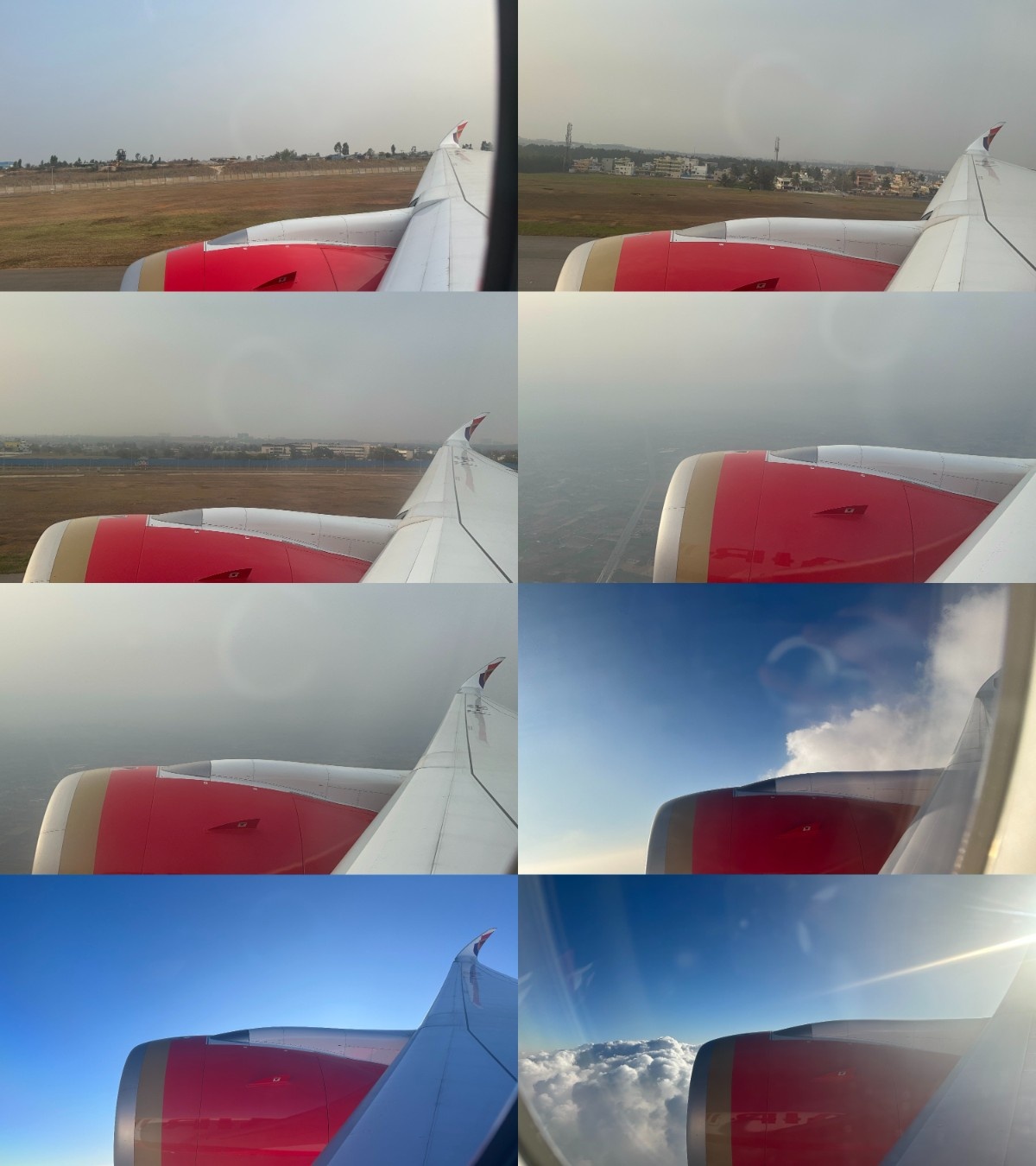
A very Indian entertainment selection, on a very Indian, globalising airline
Note: There is going to be a link to a high-definition, full-resolution version of almost all of the below pictures, given that they have very small, almost unreadable text at the size that they are uploaded.
No sooner did the A350 lift into the skies than I opened the Arc moving map and had a view of my route from as many angles as possible: always a joy to use given the highly customisable and tailored nature of this system, all the more so since this was my first time using it on a widebody. (Full resolution here.)
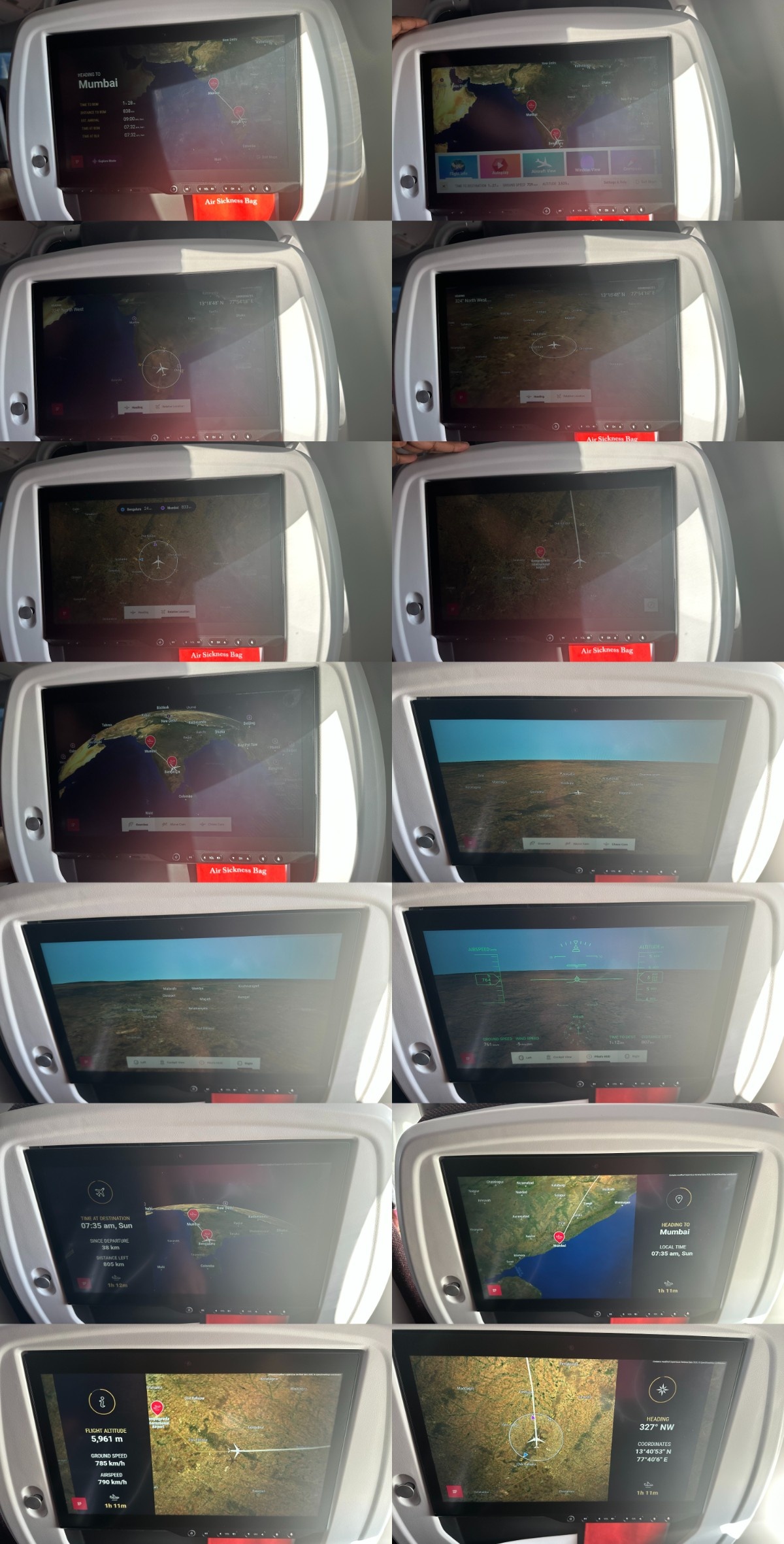
Now it was time to scroll through the entertainment selection, though this time I skipped the movies given the short nature of the flight. Instead I started with classic Indian TV shows like that evergreen sitcom, Sarabhai vs Sarabhai (2004–06) — some of whose early episodes were included here. A rib-tickling and rip-roaring portrayal of Mumbai of the times, especially the gulf between its high-class milieu and, um, the ‘middle class’: a term that’s used all too often in the show. (Full resolution here.)
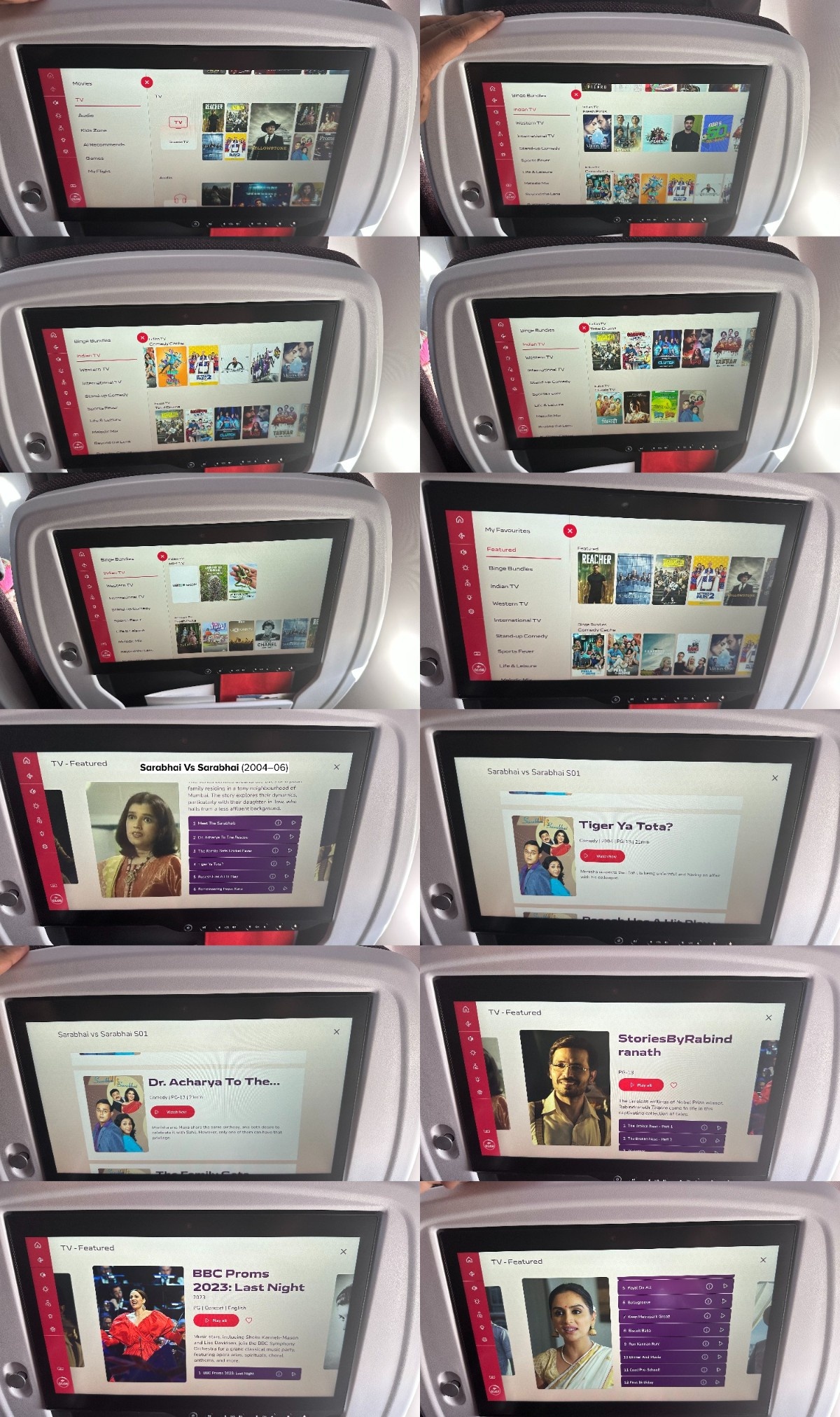
More pictures of the TV selection are in the Tourism Bonus, lest you get bored reading all this.
Meanwhile I unfolded the tray table at the side of my seat: my first time doing so, it being a new feeling indeed to pull out a tray from the side-of-seat storage and separate its two halves with a solid, satisfying click. I scrolled through some more variety shows and shorts, ranging from the twelfth and final season of The Big Bang Theory, to short-form slice-of-life videos by FilterCopy — a YouTube content creator that was really popular among young Indians like me from around 2017 to 2022, but not since — to Shark Tank India, the business/entrepreneurship reality show that has taken a whole generation of Indians by storm. (Full resolution here.)
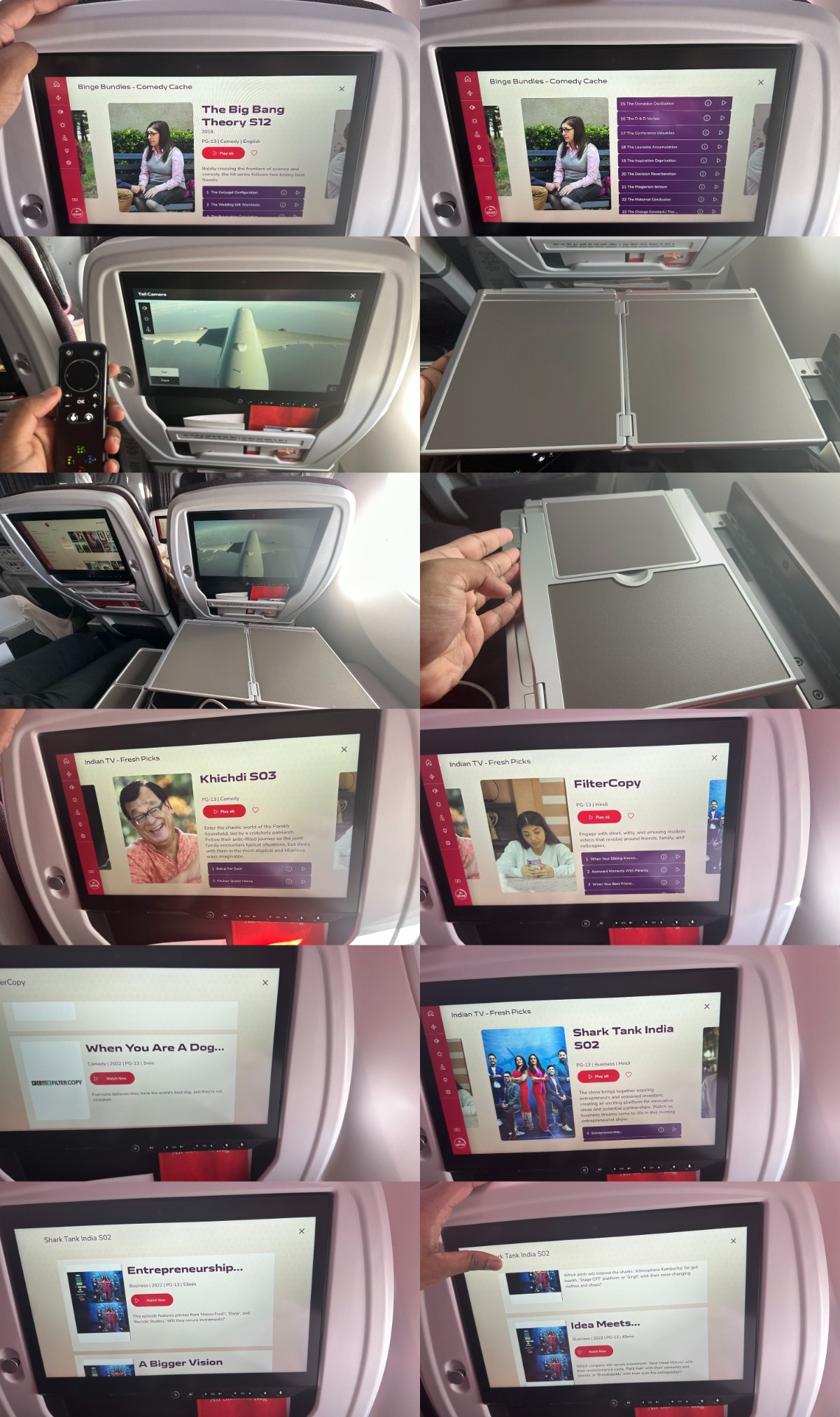
Quickly I clicked on one of the Shark Tank India episodes and, to my surprise, it began with an animation of Air India’s new red, gold and purple holding shapes ascending through a sunlit sky! These soon gave way to the violet-orange-and-yellow graphics package of Sony Entertainment Television, or Sony TV: one of India’s most established Hindi entertainment channels, which has cemented its reputation through such reality shows. (Full resolution here.)
Before I bore you further with even more pictures of fairly niche Indian TV shows…
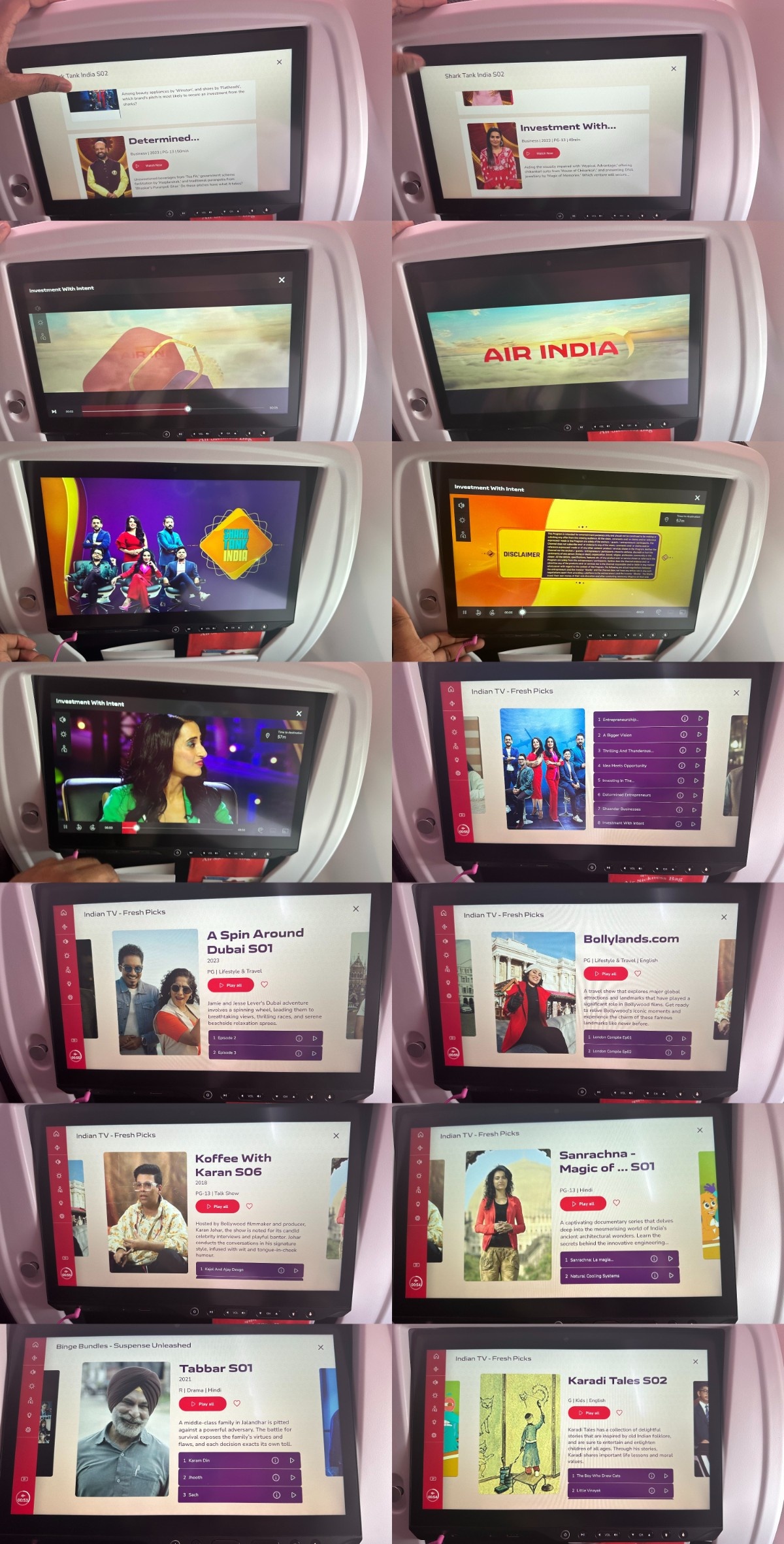
…I will, however, note that the IFE did have Season 6 of the highly controversial, candid and, dare I say, naughty celebrity talk show Koffee With Karan, hosted by Karan Johar, which has made a name (and infamy) for itself in terms of the promiscuous, bordering-on-lewd statements that its Bollywood guest stars have made over the years. (Full resolution here.)
Other sections of the IFE included ‘Wellness on Board’, ‘Sports Fever’, ‘Business Canvas’ and ‘Life and Leisure’, which are pretty self-explanatory. All-in-all, an IFE system that I’d love to use on sectors much longer than this 90-minute hop from Bengaluru to Mumbai — and hopefully it’s installed in seatback form on at least SOME narrowbody aircraft, the A321neo and A321XLR in particular!
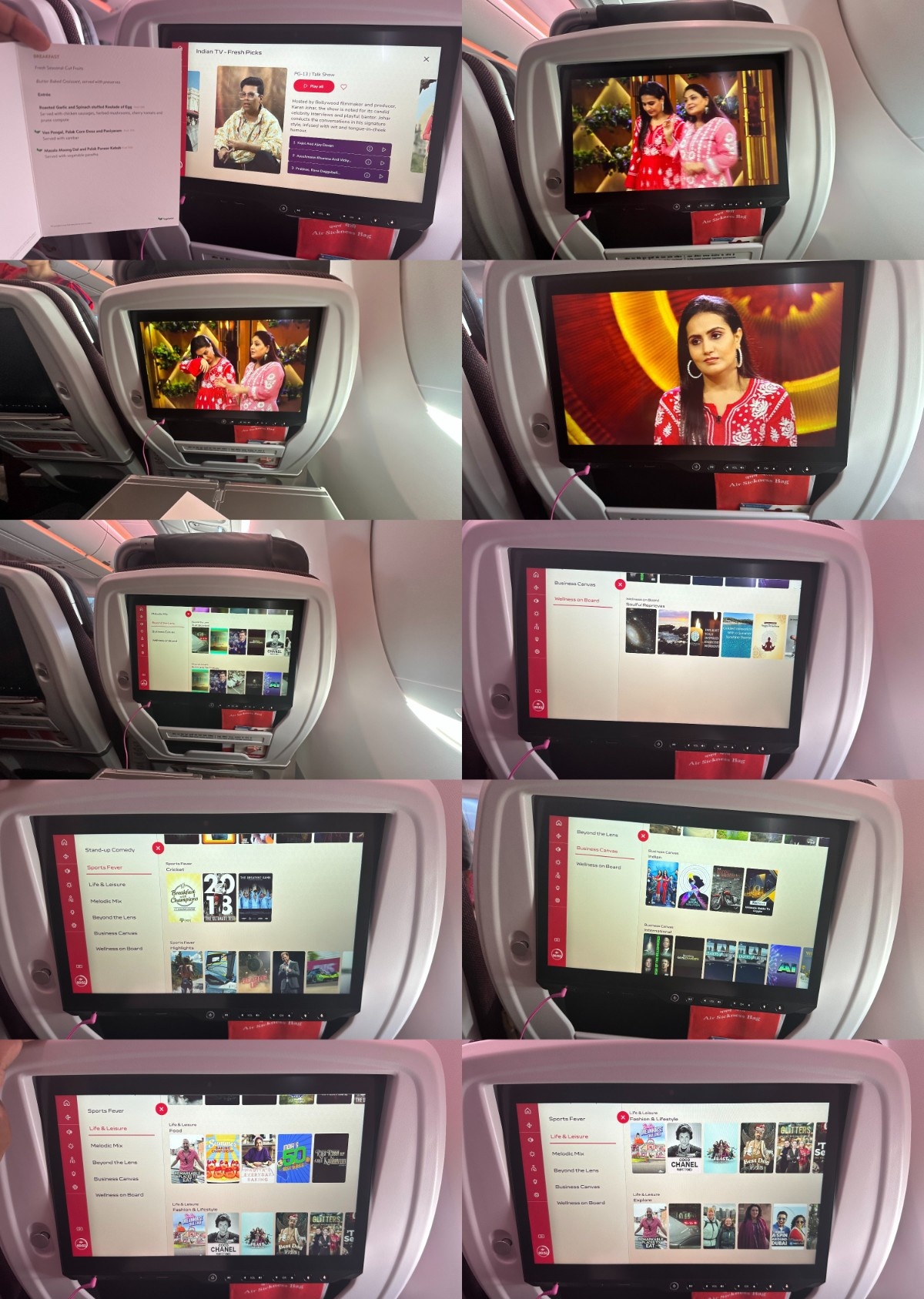
A pan-Indian superstar, and a South Indian breakfast: Timeless music videos
Note: The next few pictures are all about Bollywood songs and music videos, along with a bit of the breakfast. If this isn’t your fancy, please feel free to scroll on to the landing at Mumbai.
Soon I was getting bored scrolling and scrolling, and I needed something entertaining to watch, no matter how short. Fortunately I had stumbled upon just the right section: Melodic Mix, featuring a smörgåsbord of music videos and compilations, both Indian and western. Some had the new Air India font, colours and Vista motif, others just a half-baked infocard with that ridiculous Montserrat font… but I knew exactly what I wanted here.
Without further ado, I went for Shaan-e-Khan: SRK Special, this being a mix of music videos starring Shah Rukh Khan, or ‘King Khan’, one of the country’s most popular, versatile and enduring thespians. The compilation kicked off with a song I’ve mentioned a fair number of times on this website: Chaleya, the romantic chartbuster — as I always tend to call it — from the action thriller Jawan, the highest-grossing Indian film of 2023, with the highly similar Pathaan (also starring SRK) — which I watched on the SQ A380 to Mumbai in December 2023 and rank as the worst inflight movie I’ve ever watched — a close second.
With the graceful, sensuous moves of leading lady Nayanthara, and the dulcet duet of Arijit Singh and Shilpa Rao, this and other songs from the movie like Zinda Banda and Not Ramaiya Vastavaiya formed a lot of my listening history towards the end of 2023. (Full resolution here.)
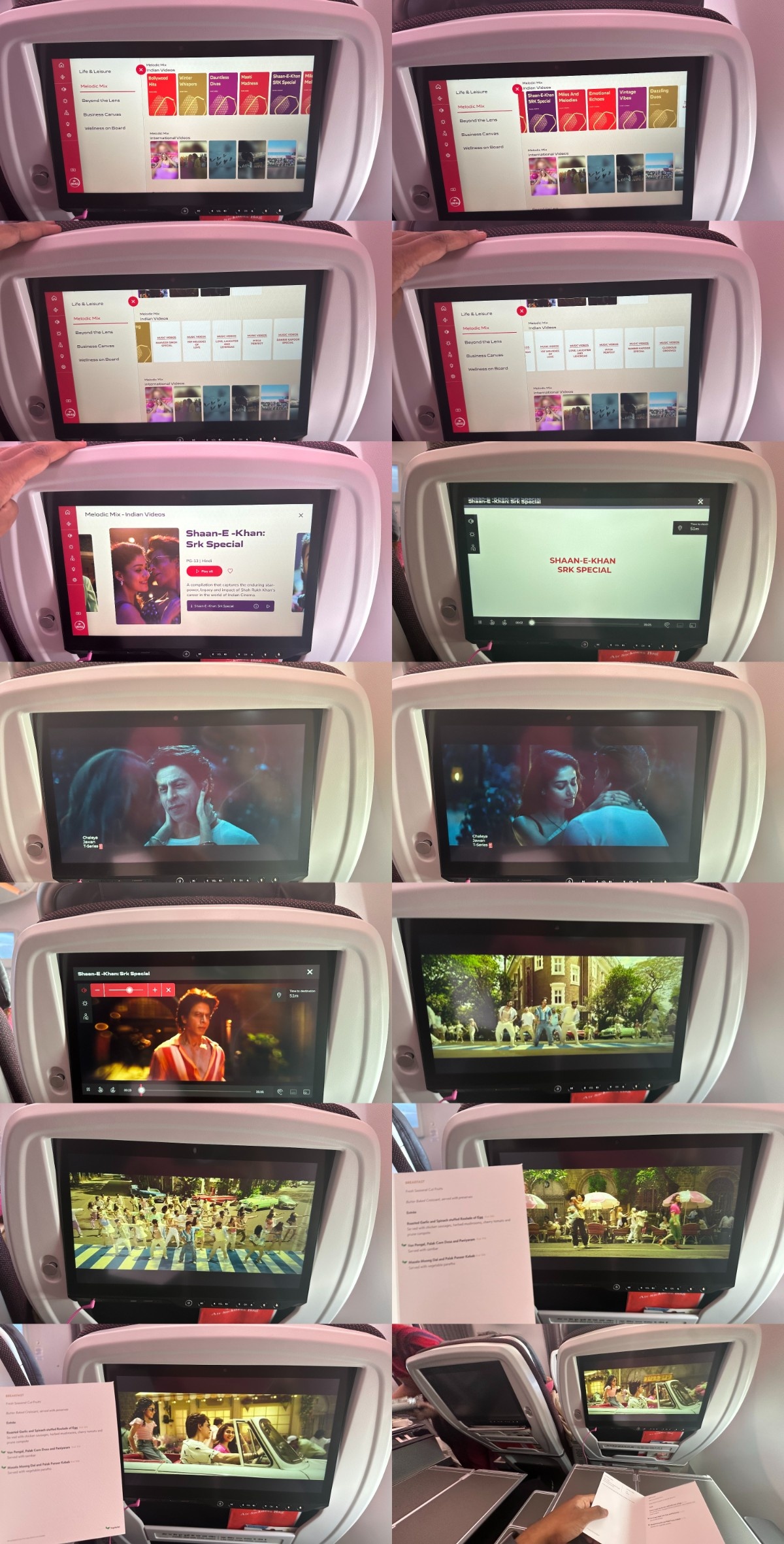
At the same time I was leafing through the menu card, and soon enough Melissa turned up. I requested her to please place the South Indian breakfast on my multi-step foldable tray, and to please place a bottle of water beside it. While airline breakfasts are usually far from the greatest meals on earth, I think this combination of the ven pongal (salty rice cakes), palak corn dosa (flat Indian pancake), paniyaram (rice lentil dumplings) and sambar (lentil soup) — with the croissant and Amul butter providing a Western touch — was a perfect South-meets-North-and-West accompaniment to the harmonious moves of SRK and Nayanthara on the screen!
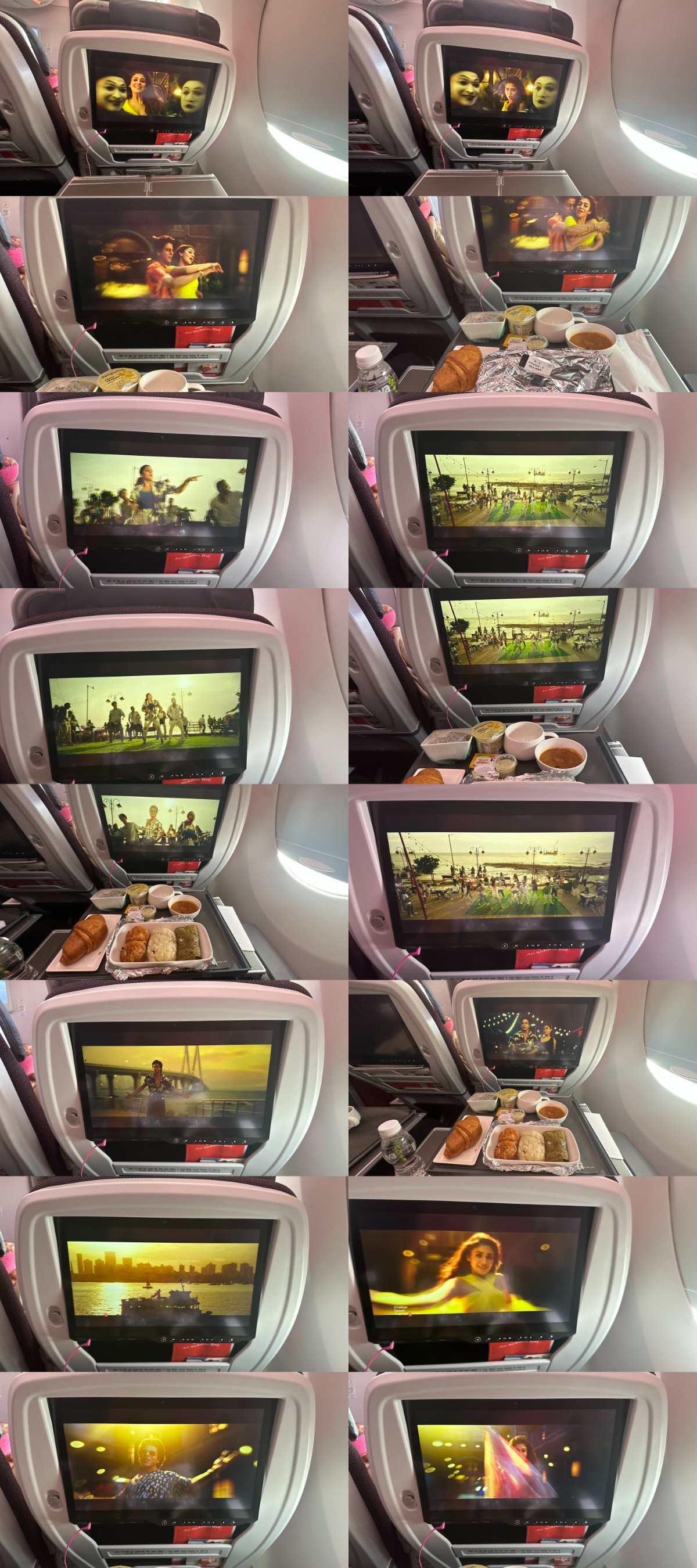
Almost all the other songs in the video were from movies released by Yash Raj Films (YRF), the iconic production studio that I’ve talked about at length in previous reviews. Particularly the feminist sports drama Chak De! India (2007) — as I watched on the Vistara A321neo in March 2023 — which has SRK lead a ragtag, diverse bunch of girls to the World Hockey Championships, though that wasn’t included in this video (what a shame!). In fact, Jawan was distributed (though not produced) by YRF, while Pathaan was outright produced by it and forms an integral part of the ‘YRF Spy Universe’.
Specifically, instead, the focus was on the romances directed by Yash Chopra and his reclusive, auteur son Aditya Chopra — so much so that they formed the crux of the Netflix documentary The Romantics, which was released a year prior, in February 2023. The first of these to be shown was Challa, from Jab Tak Hai Jaan (2012), the swansong of Yash Chopra: in fact he died in October 2012, a few weeks before the film was released on the Diwali holiday in his memory. The romantic drama has a large part set in London — that favourite hub of Non-Resident Indians (NRIs) — and in this song SRK plays Samar, initially a busker (street singer) by the Thames before moving to the Indian army in Ladakh.
After this came Main Yahan Hoon from Veer-Zaara (2004), also by Yash Chopra: an epic saga of trans-border separation and enduring love.
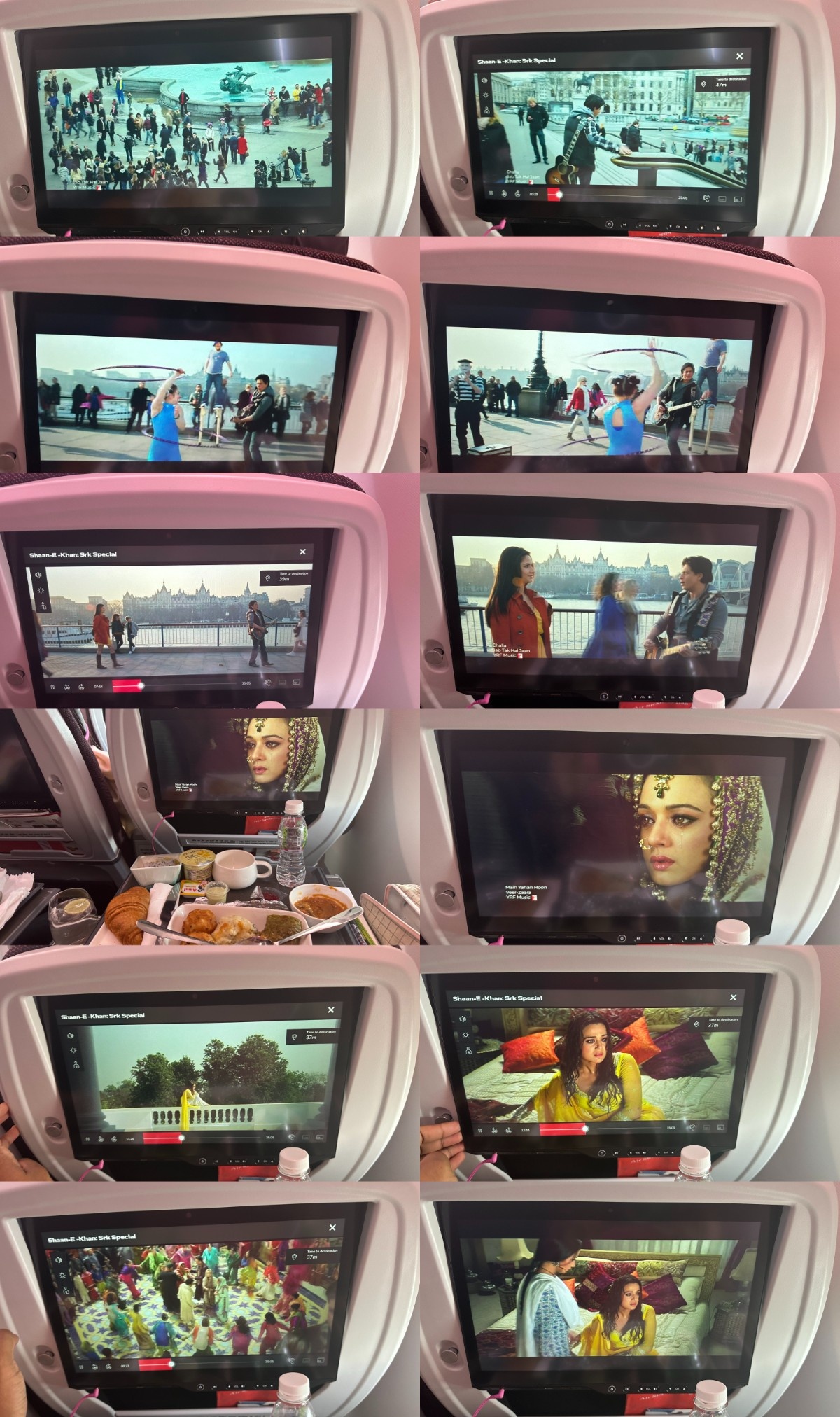
Then came the soulful, moving title track of Jab Tak Hai Jaan (which means As Long As I Live), in the form of a poem written by Aditya Chopra and narrated by SRK himself, with leading ladies Meera (Katrina Kaif) and Akira (Anushka Sharma) accompanying him and his undying ode to love.
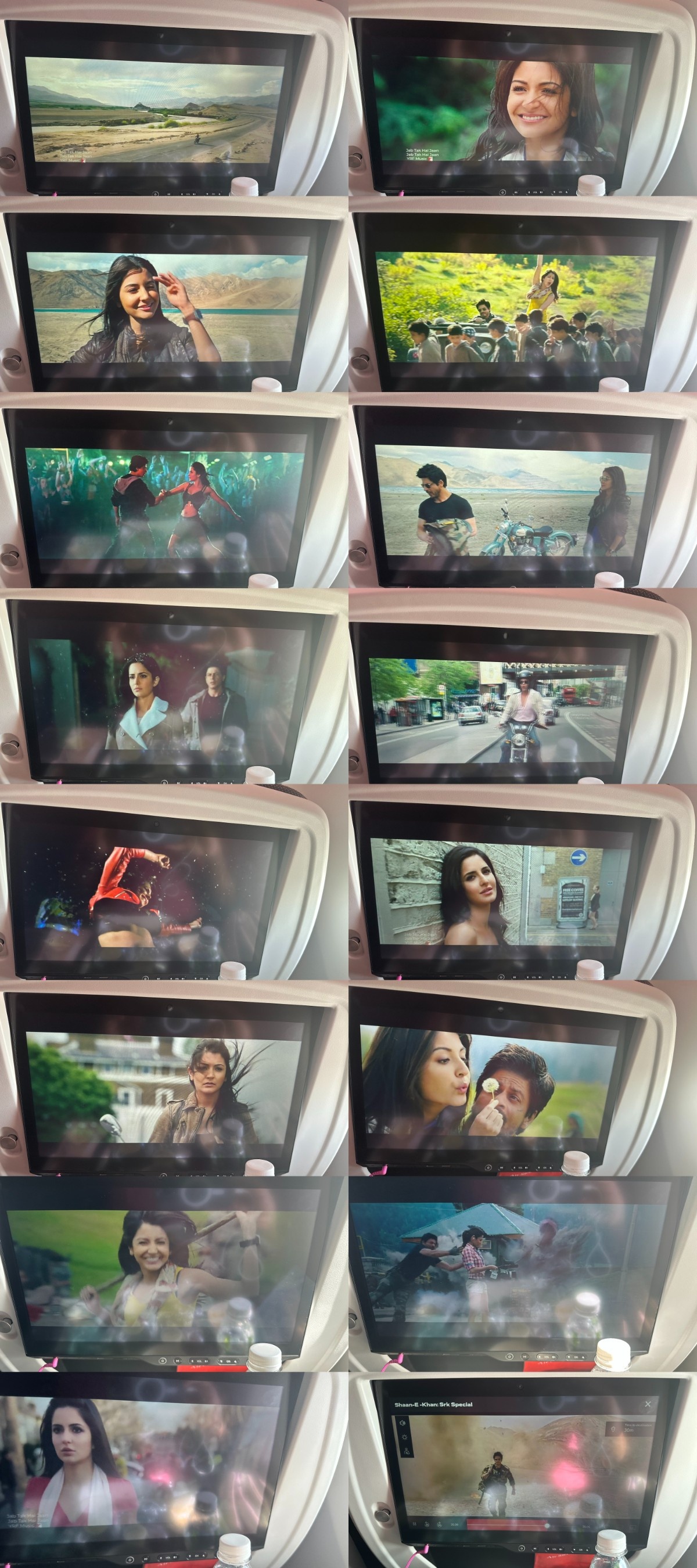
Slightly older than this was Tujh Mein Rab Dikhta Hai from Rab Ne Bana Di Jodi (2008) by Aditya Chopra, wherein SRK plays Surinder, a modest Punjabi office clerk, who transforms himself into a young hunk, Raj, to impress his lady love, Taani: a teenage Anushka Sharma in her début. This was one of only four films directed by the extremely reticent but brilliant director, along with Dilwale Dulhania Le Jayenge or DDLJ (1995) — his sparkling début that stands tall as one of Bollywood’s biggest icons three decades later — plus Mohabbatein (2000), also the biggest superhit of that year (in which I was born!), and most recently Befikre (2016), the only one not to star SRK and the only disaster of the four.
There’s an all-singing, all-dancing number from Mohabbatein in the Tourism Bonus at the very end, as well as another from Dil To Pagal Hai (1997), a similar youthful YRF romance from that time.
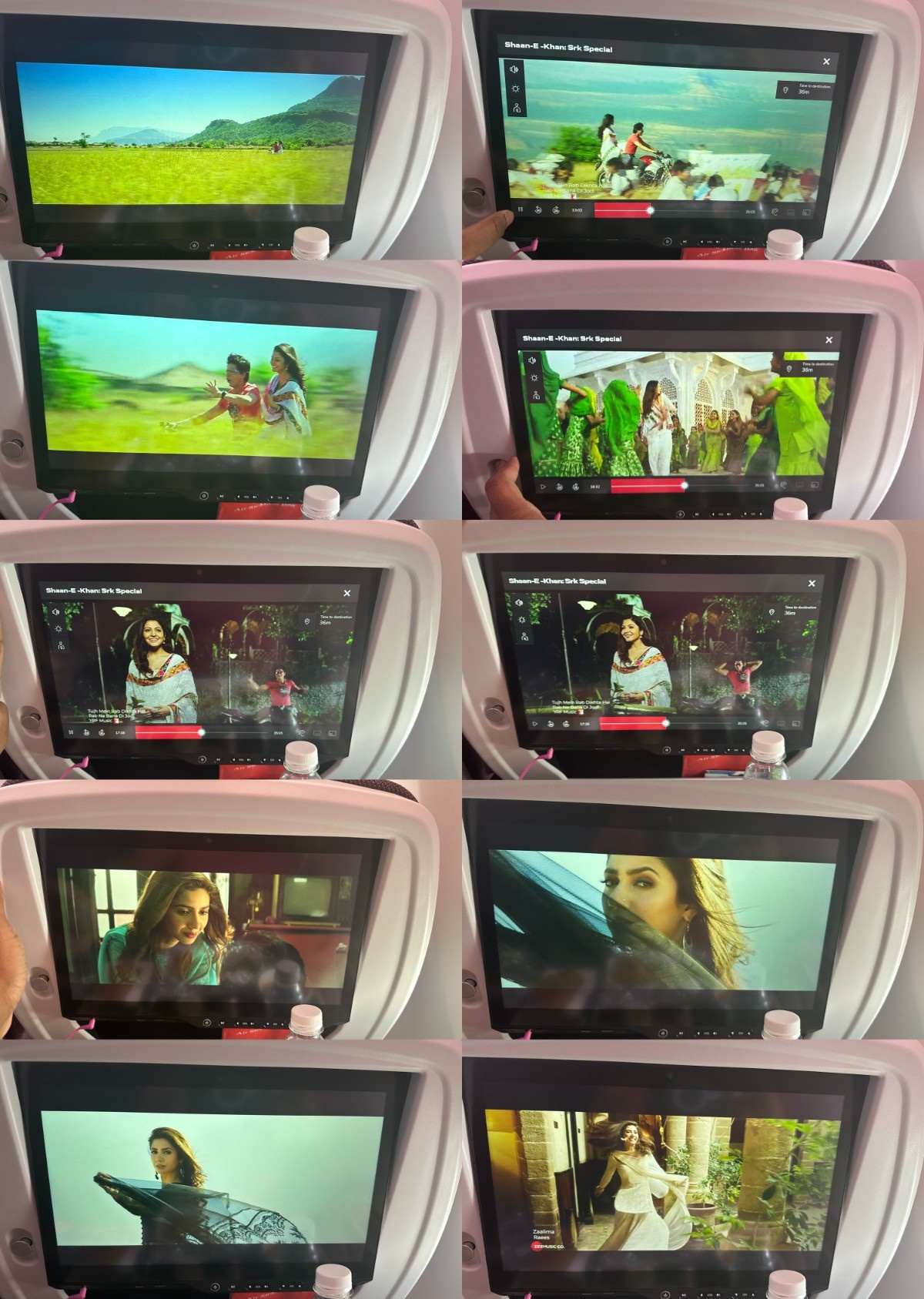
After that came a couple of songs from a more recent non-YRF film, Raees (2017), which didn’t have as good a commercial reception as the others. First Zaalima, meaning ‘torturess’, as you see above, with Pakistani leading lady Mahira Khan sashaying and showing her moves; and then the more modest, traditional-sounding Udi Udi Jaye, as below. All these songs provided a delightful musical accompaniment to the meal, and showed just how far Air India’s IFE transformation had come on the A350.
There were a number of other such melodious mixes, of which I’ve shown the Bollywood ones here, though there were also several South Indian and Western compilations otherwise. Clearly AI had taken a big leaf out of its would-be parent SQ’s playbook here! (Full resolution here.)
Also note the slice of lemon that had been placed in the glass of Sprite that Melissa had served closer to descent. A deft touch indeed!
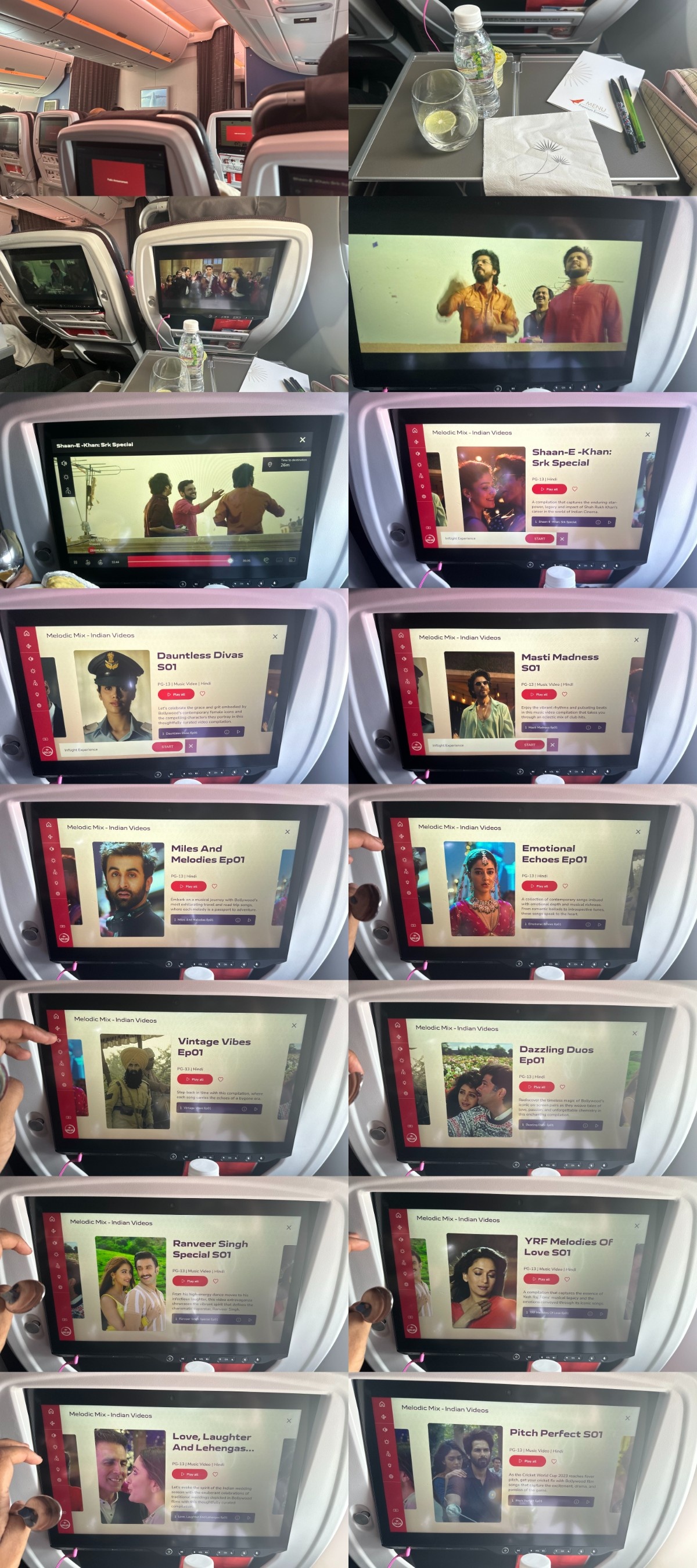
Insofar as the actual audio selection itself was concerned, there was (of course) the audio track of Jawan, which I now listened to for a bit, as well as a number of other offerings including live radio and podcasts. All-in-all, a serious sign of progress in terms of relaunching what has historically been one of Air India’s biggest Achilles heels and turning it into a strength!

Melodious moving down towards the manic, magic metropolis of Mumbai
In all this time I somehow managed to squeeze in my journal entry for the flight, calling this plane the ‘AI350’ (not a flight number!) and especially highlighting the premium-economy cabin, the vastness of the Panasonic eX3 IFE and the crispness of the tail cameras.
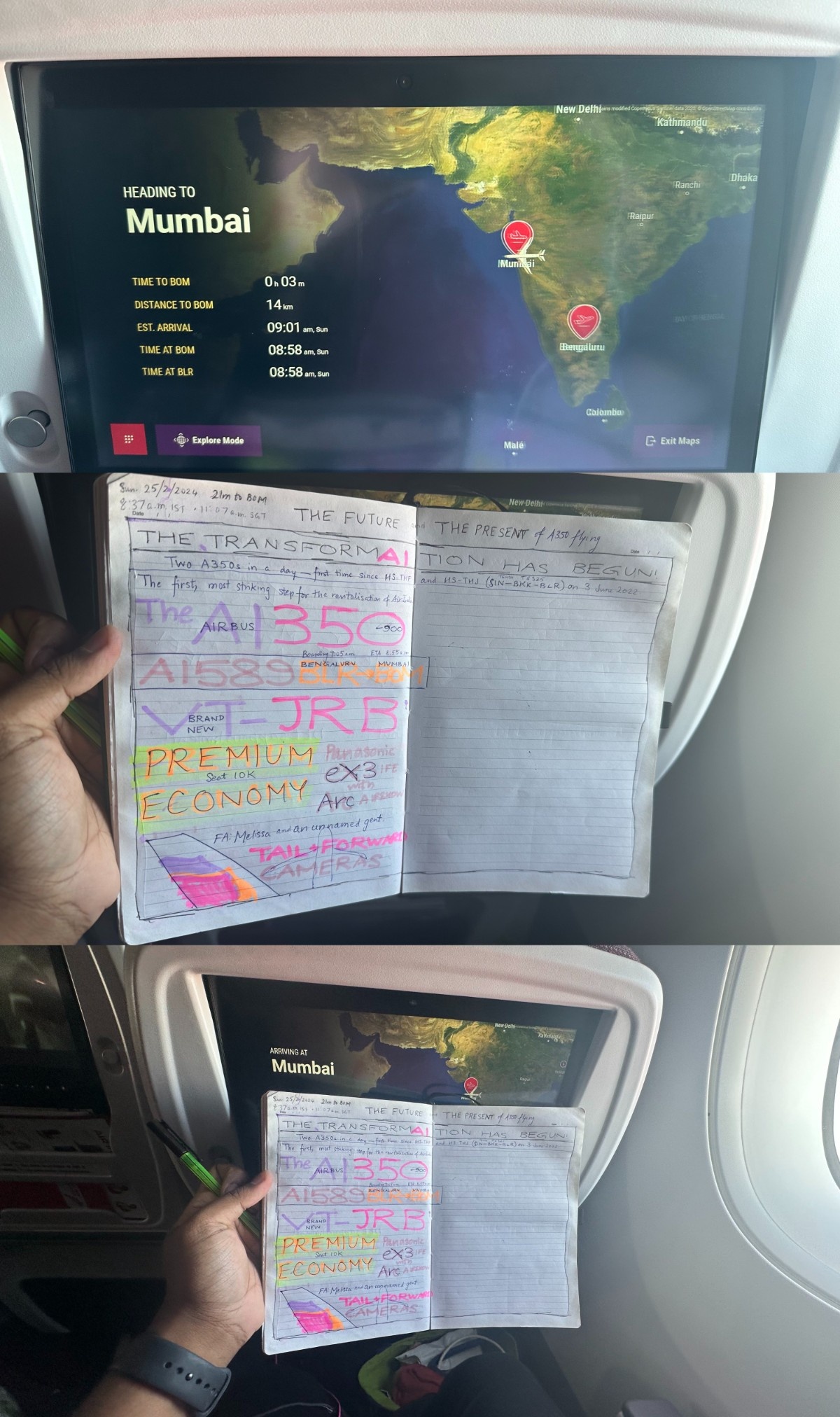
All too soon we commenced final descent for Chhatrapati Shivaji Maharaj International Airport, with the brilliant morning sun glowing on the wing(let) and the striking horizon doing its part to keep the scenes surreal. I, of course, was no fool, and wouldn’t squander a spectacular opportunity to capture the landing on the tail camera, as I’d done for the Cathay Pacific A350 (also from BLR) at HKG barely two months before.
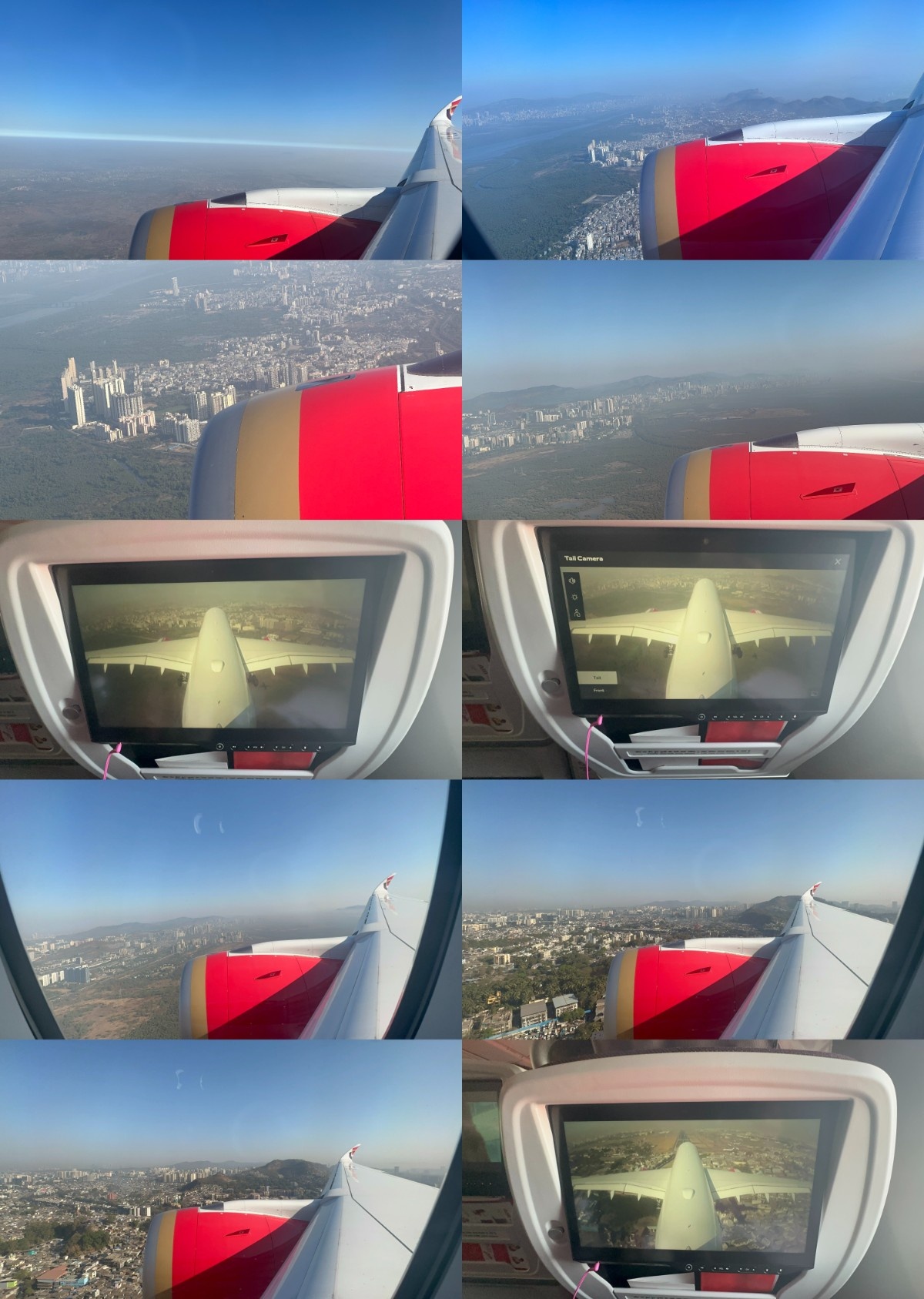
And then VT-JRB swooped over the slums of Dharavi, and the concrete jungle surrounding the airport, and kissed the ground at a few minutes past nine. A thrilling 90 minutes on board the next chapter of Indian aviation, a glimpse into the promising premium future of AI, had come to an end amidst the seas of everyday Air India, IndiGo and Vistara Airbuses — and, rarely, Boeings.
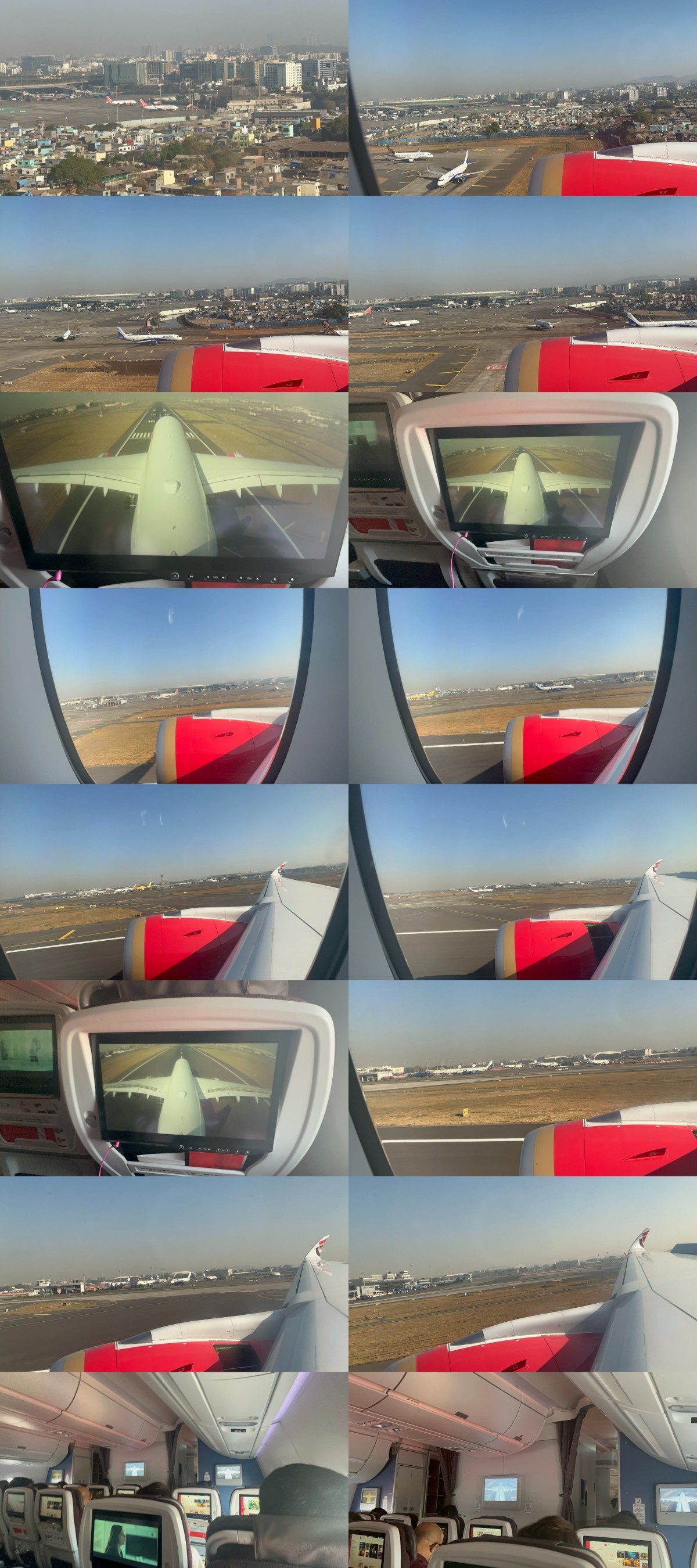
Now firmly back on terra firma, it was my turn to admire the glorious sunshine and the equally gloriously proud red-and-gold engine and winglet, as a more mundane IndiGo A320neo took off and another landed. In due course, we taxied to the parking stand, and I followed the entire movement on the tail camera — because how else was I supposed to do it?
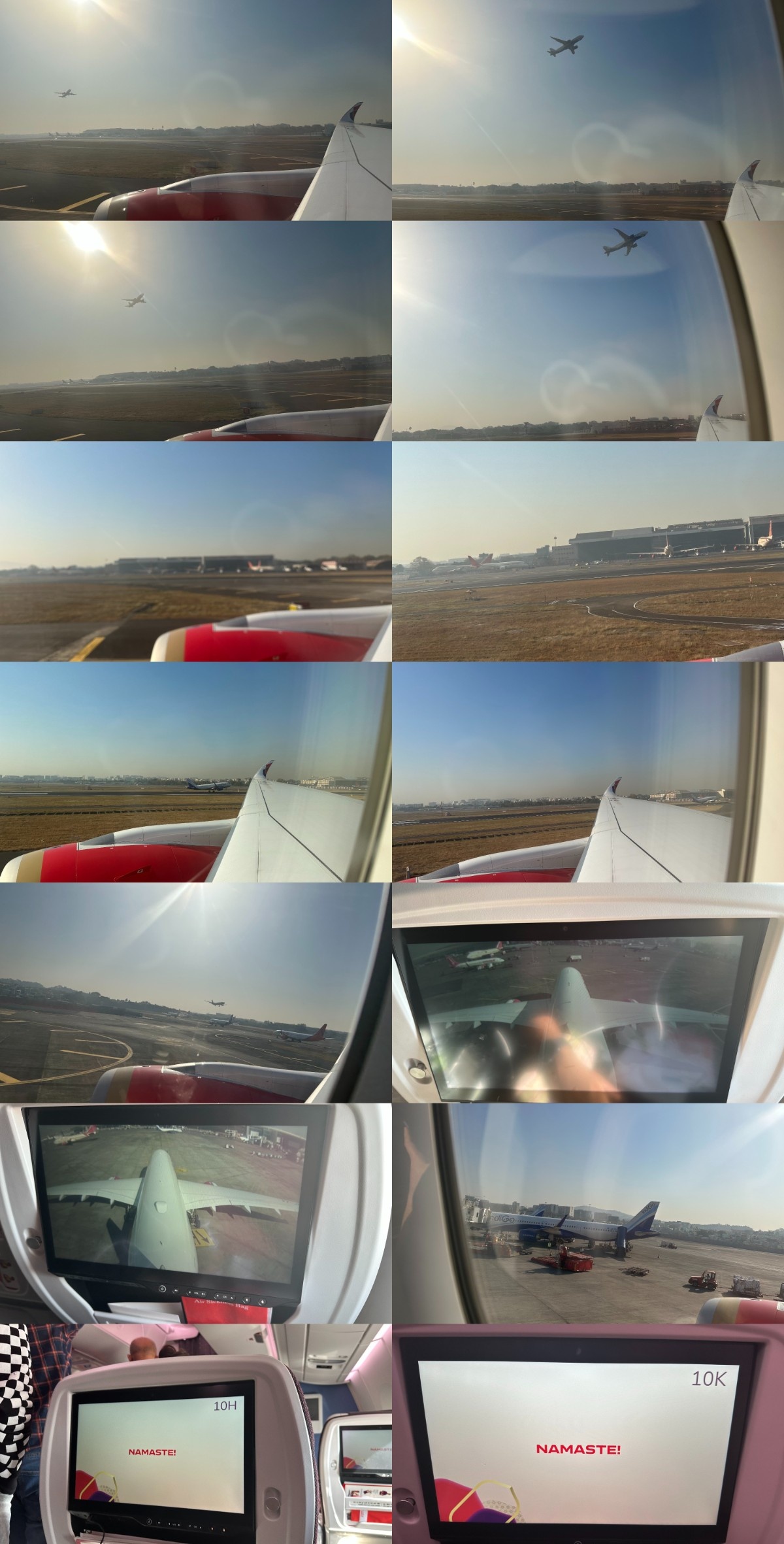
Almost as soon as I’d boarded, it was time for me to leave the rich ruby-red seating of the A350, with its soft pale-pink mood lighting, and the pleasant warm glow of the Sunday-morning sunshine streaming through the large windows, and the blue-and-gold trims that looked decidedly out of place on this very red plane. Bidding goodbye to Melissa, along with her team, and praising the all-around excellence of the A350 — both in terms of the aircraft itself, and also by way of Air India’s own premium touches — I stepped off VT-JRB much sooner than I’d like to.
Around me were various SkyTeam planes: a Virgin Atlantic A350-1000 (G-VLIB), a Saudia A330-300 (HZ-AQH) — still in the old ‘Saudi Arabian’ titles, and far from the new retro-futuristic Saudia livery — and a Kenya Airways 737-800, 5Y-CYC. And, of course, the majestic but now morose Air India 747-400: this particular one being VT-ESO, one of a handful of AI planes with a sticker for Mohandas (Mahatma) Gandhi, the great Indian freedom fighter, on the tail to commemorate his 150th birth anniversary.
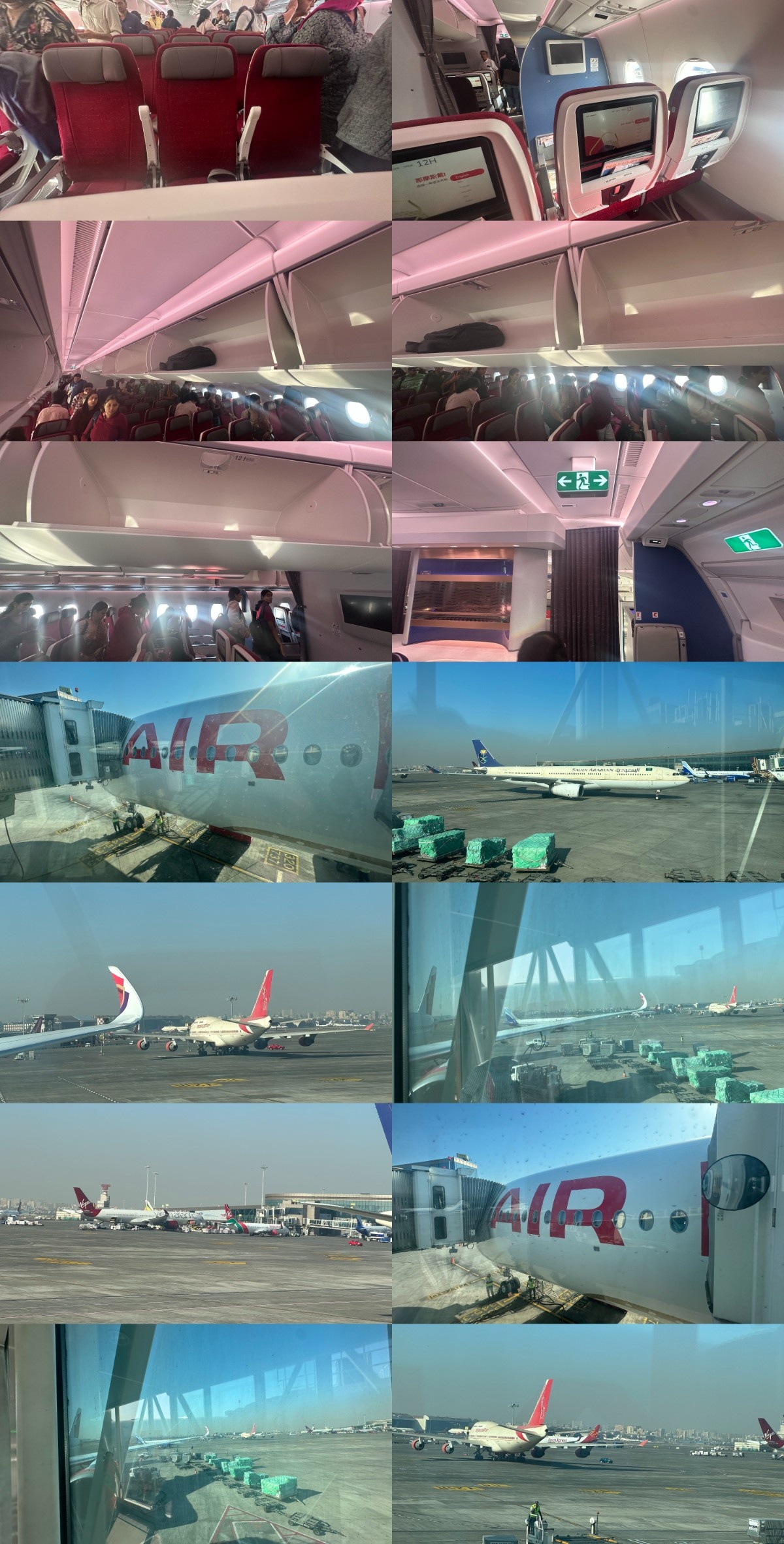
Now I didn’t have the time to notice the East–West split of Mumbai’s many neighbourhoods on the Flightradar24 map, as I did when landing here nearly a year prior on Vistara’s A321neo! Instead I had to head straight to my connecting Singapore Airlines flight, but of course I did take in the surroundings wherever possible, all the more so at an airport as beloved to me as Mumbai.
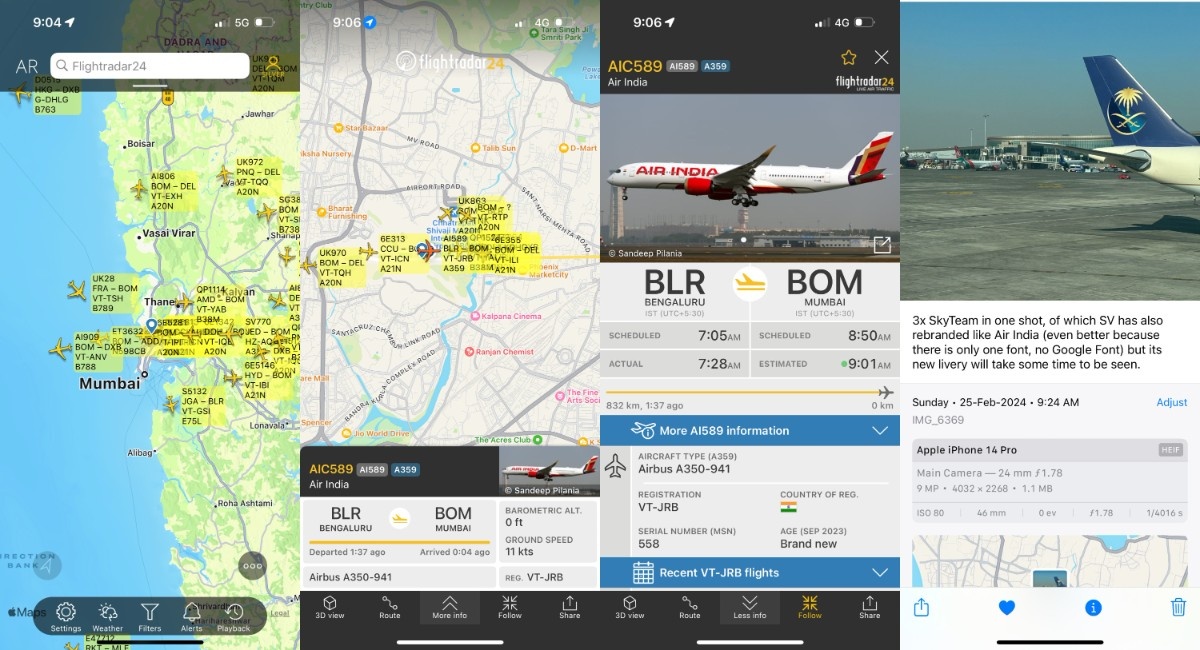
I’ll sign off here, with excellent jetbridge views at an exquisite airport, having stepped off an extraordinary aircraft — and heading towards another A350, from one of the world’s most exceptional airlines, but (for once) actually coming up short compared to this historically maligned airline that will now become its subsidiary!
